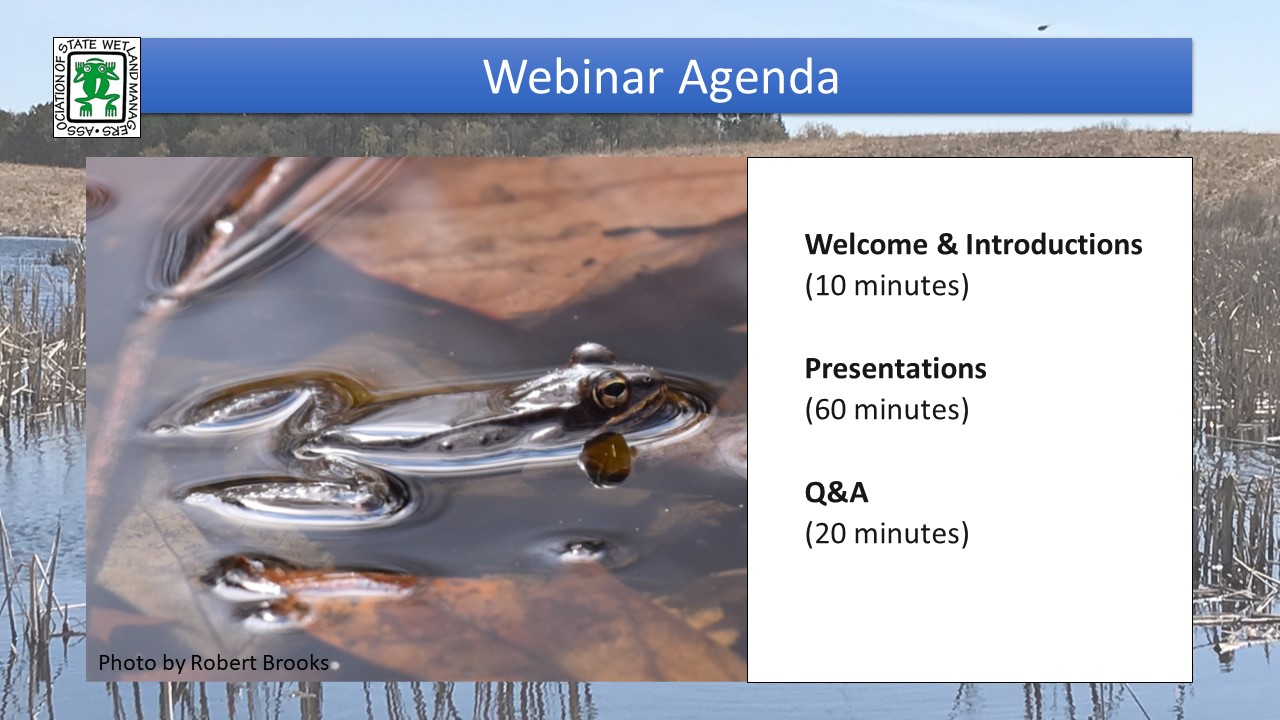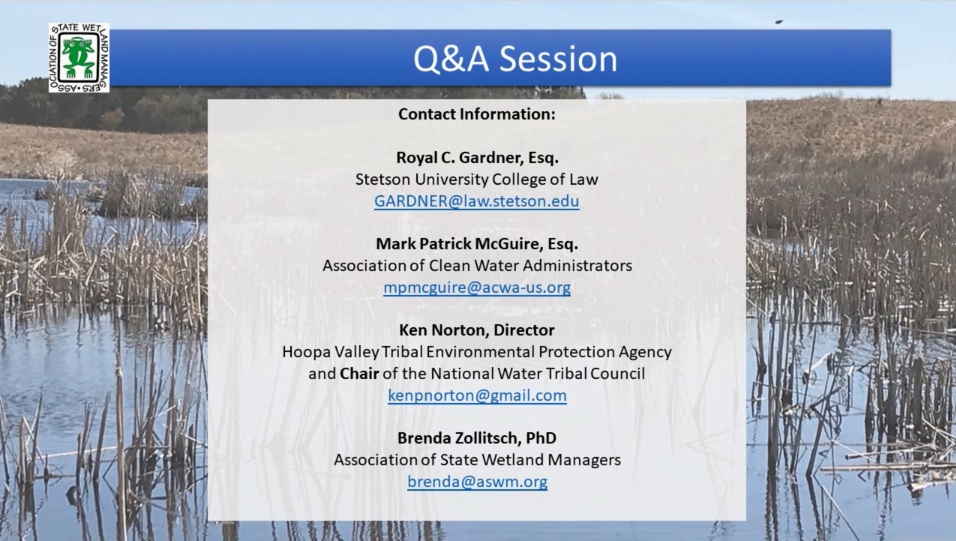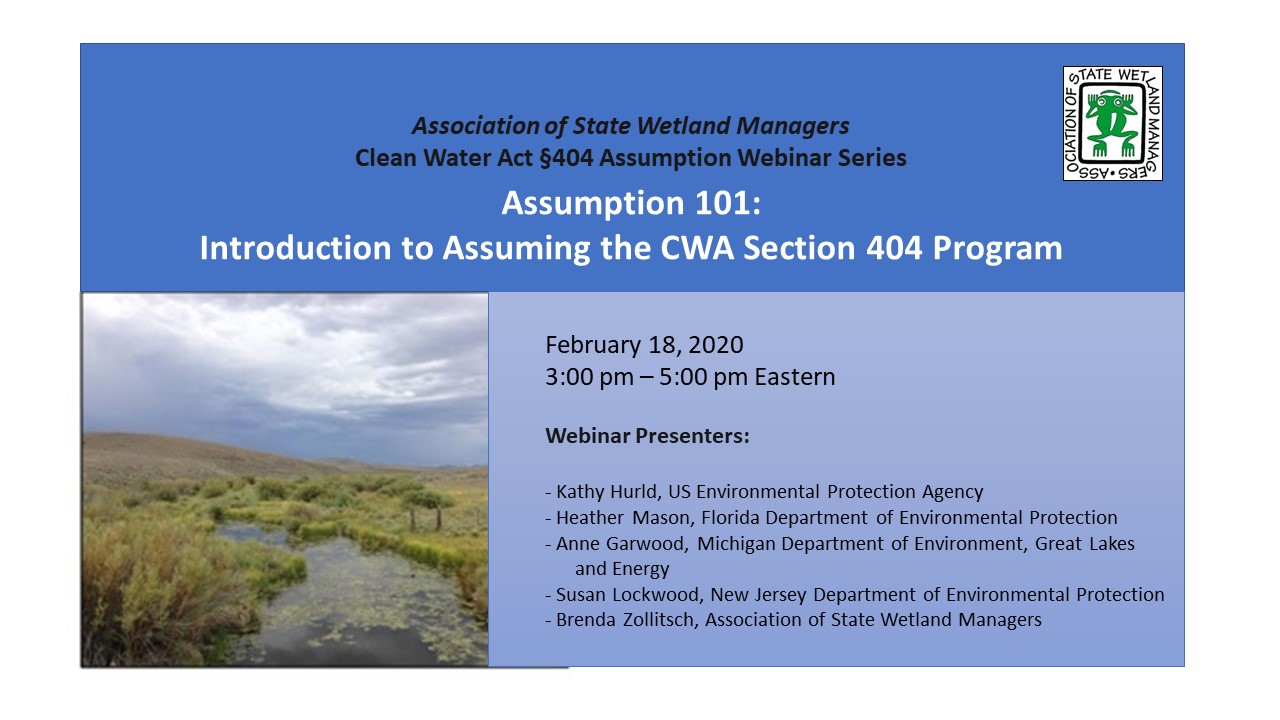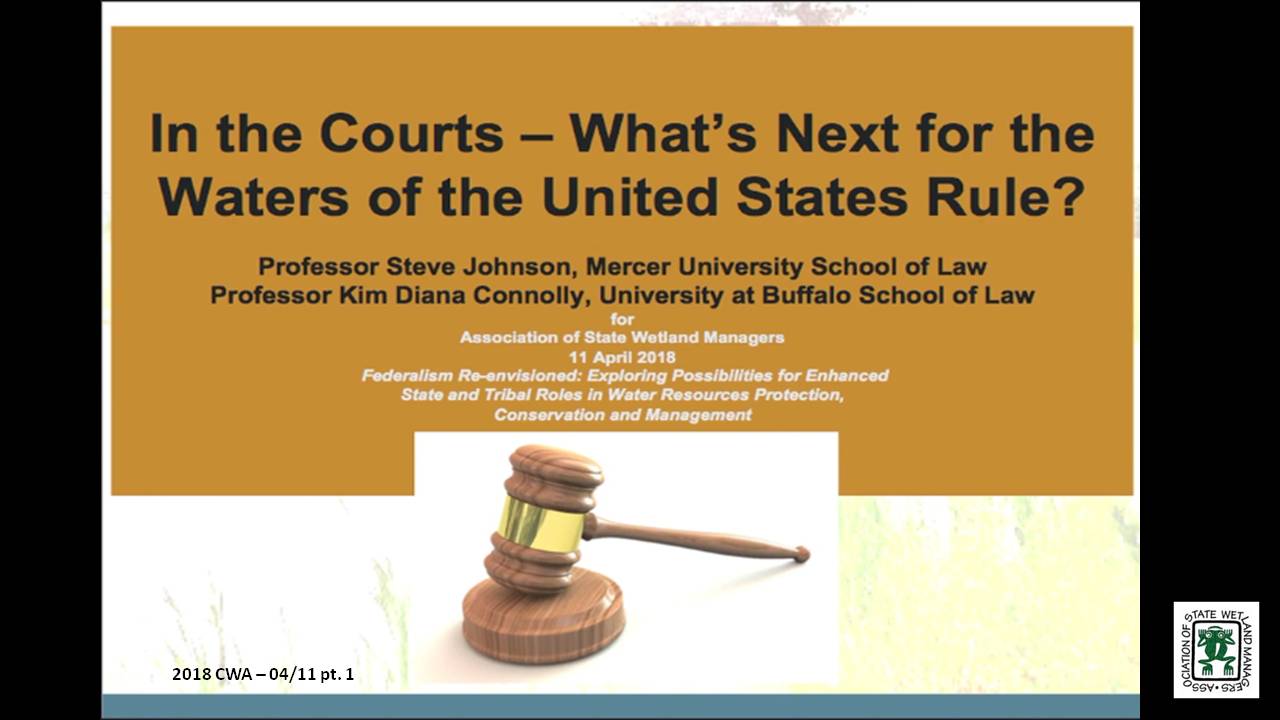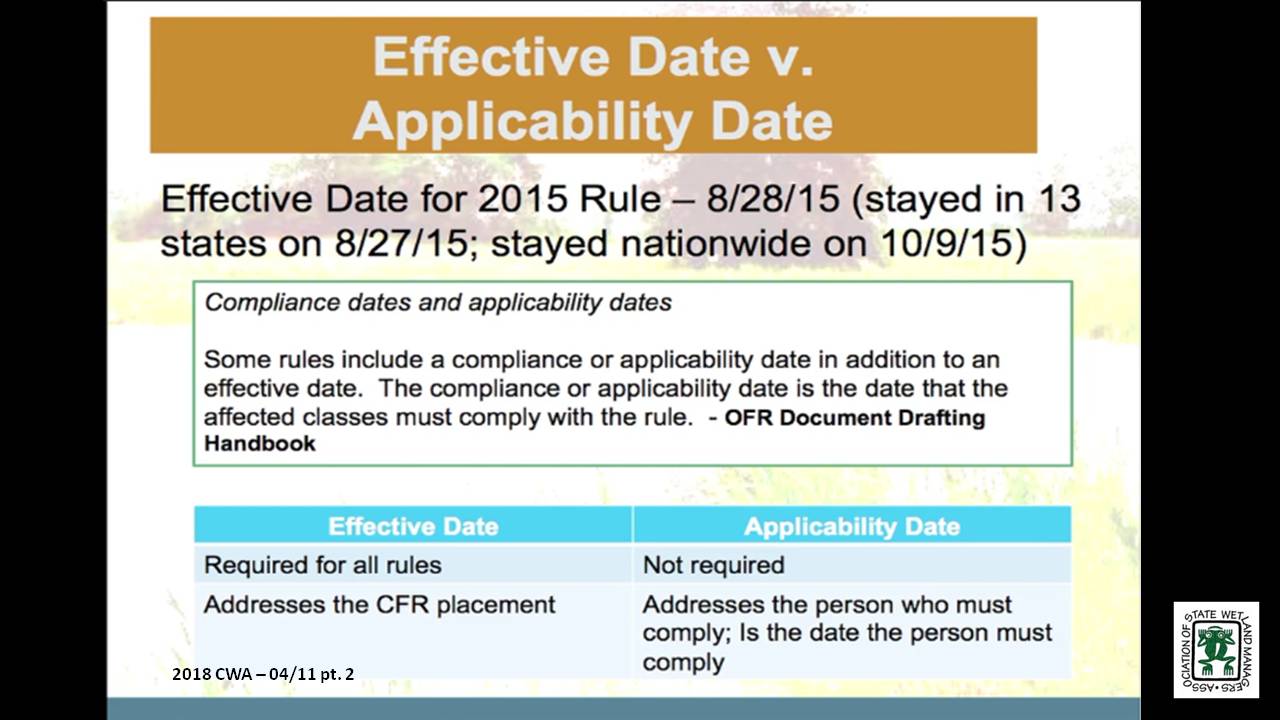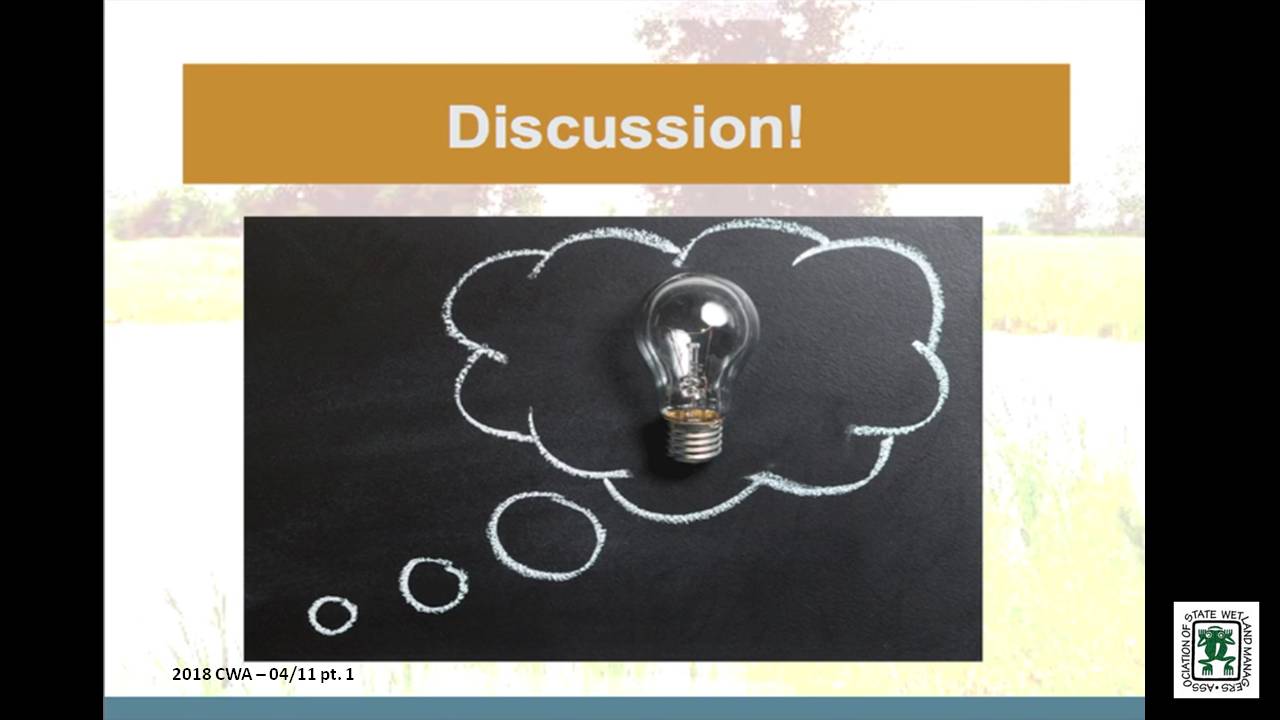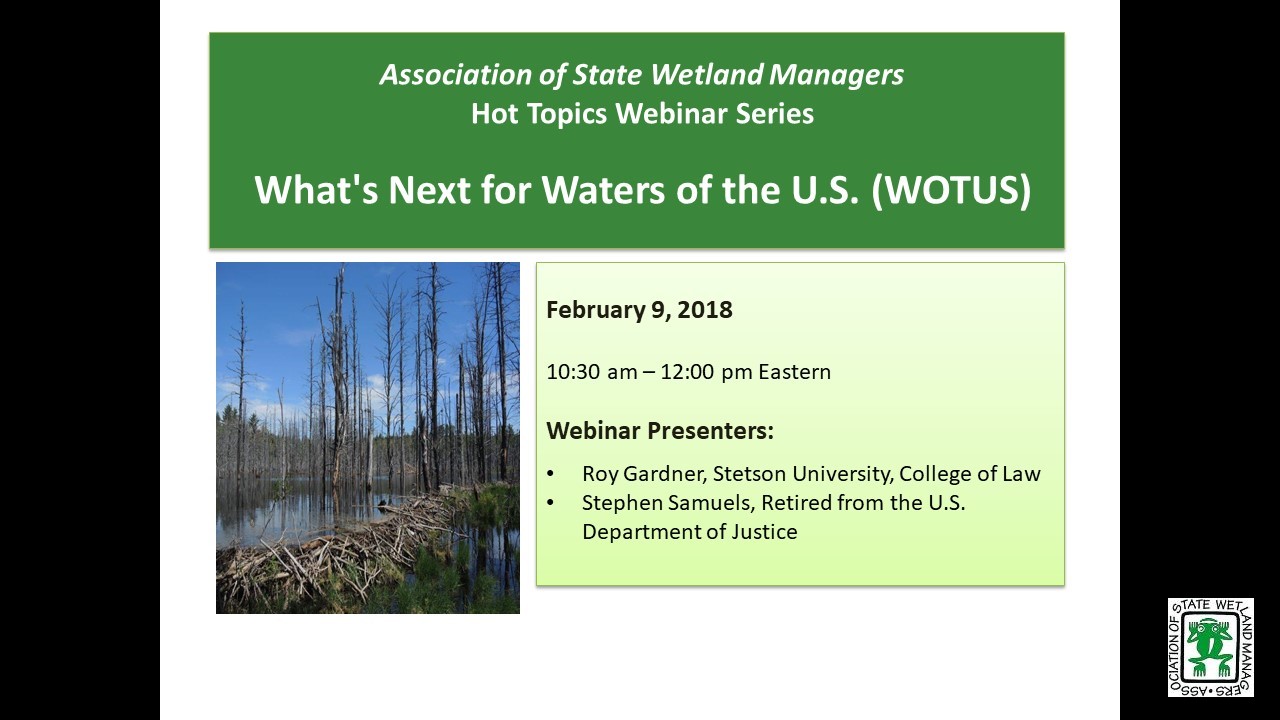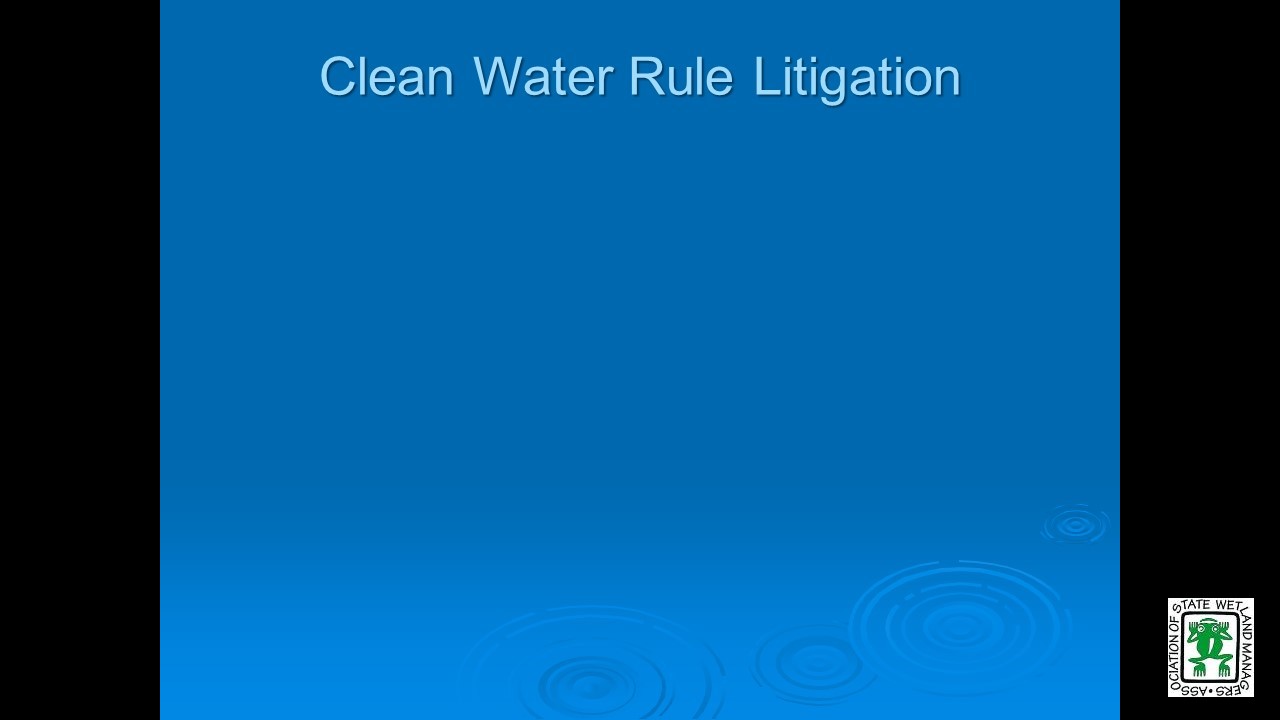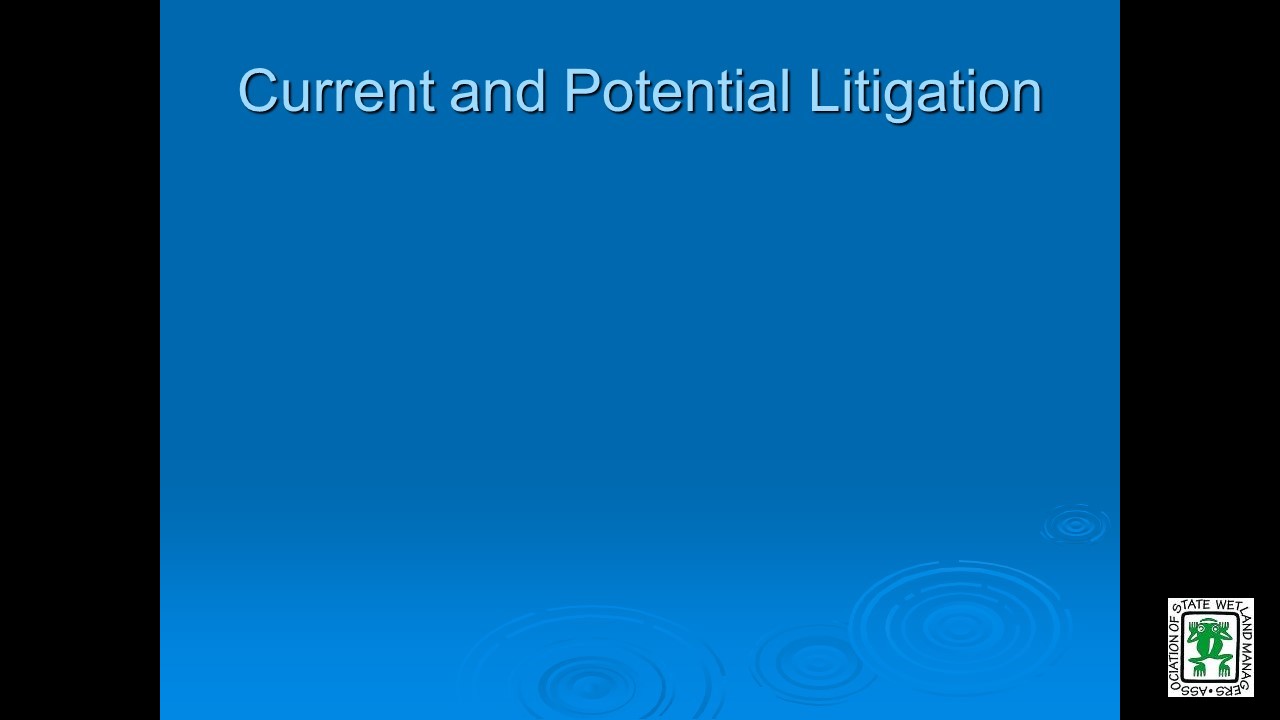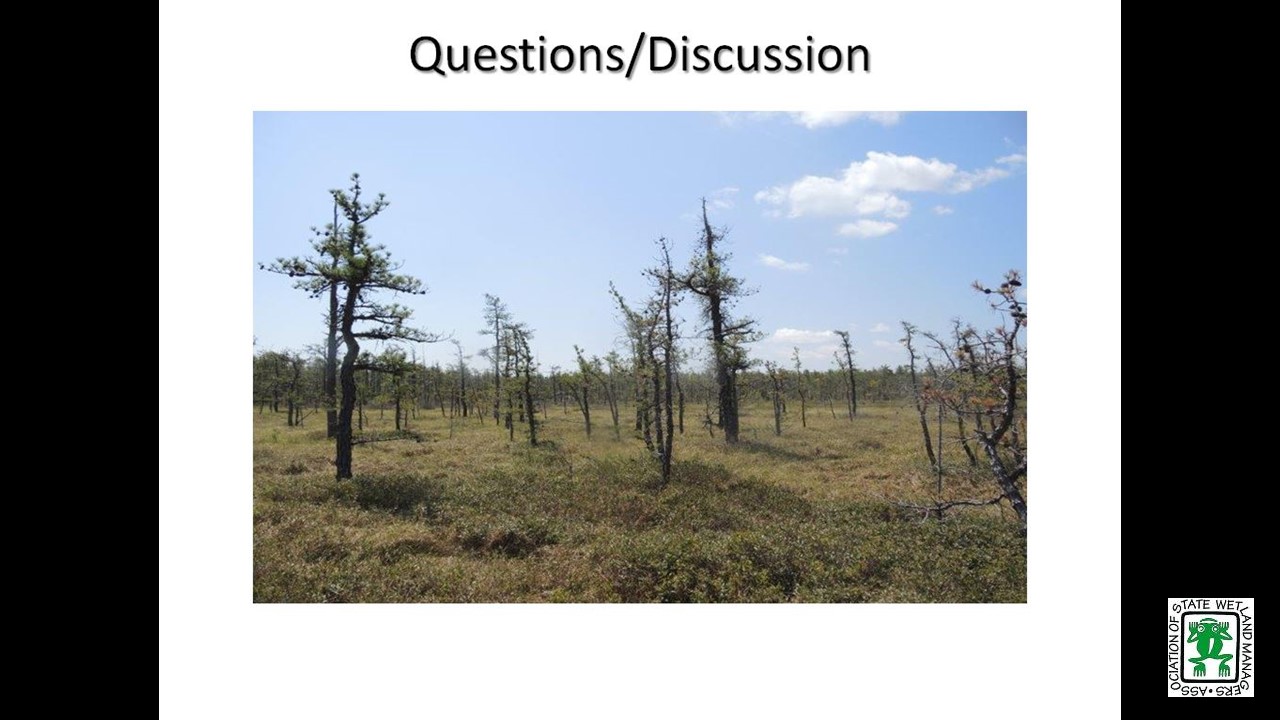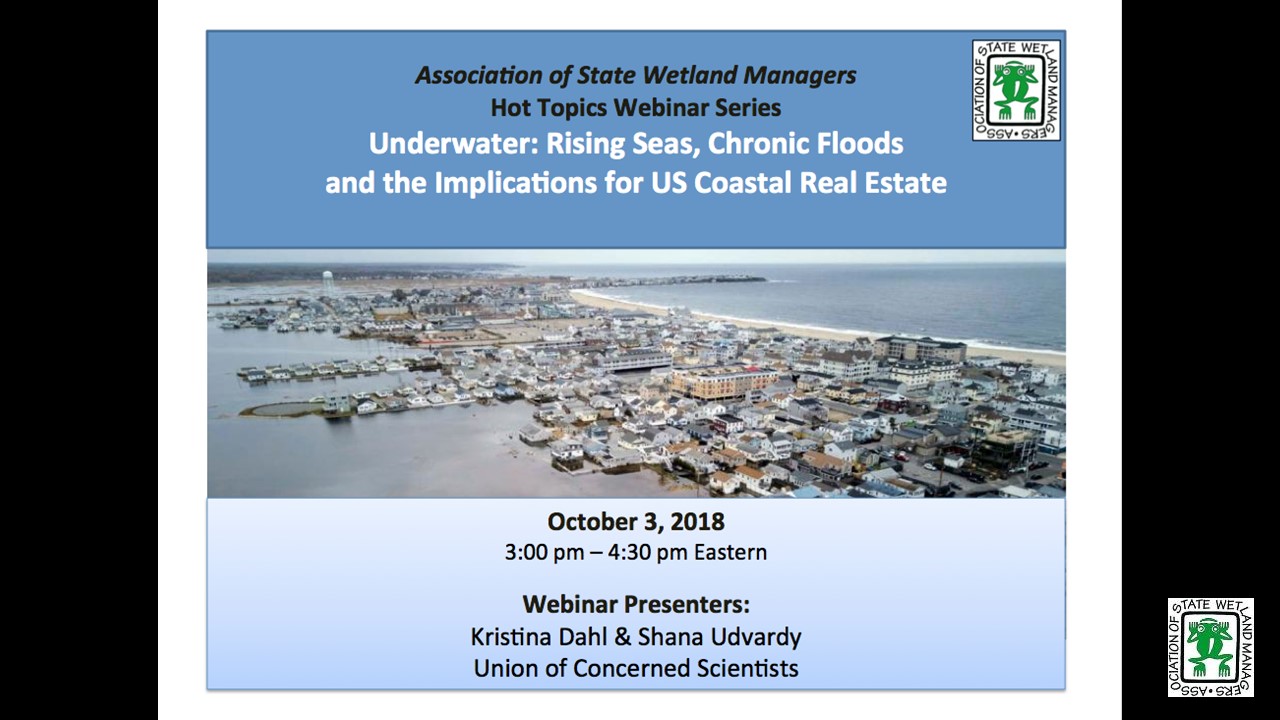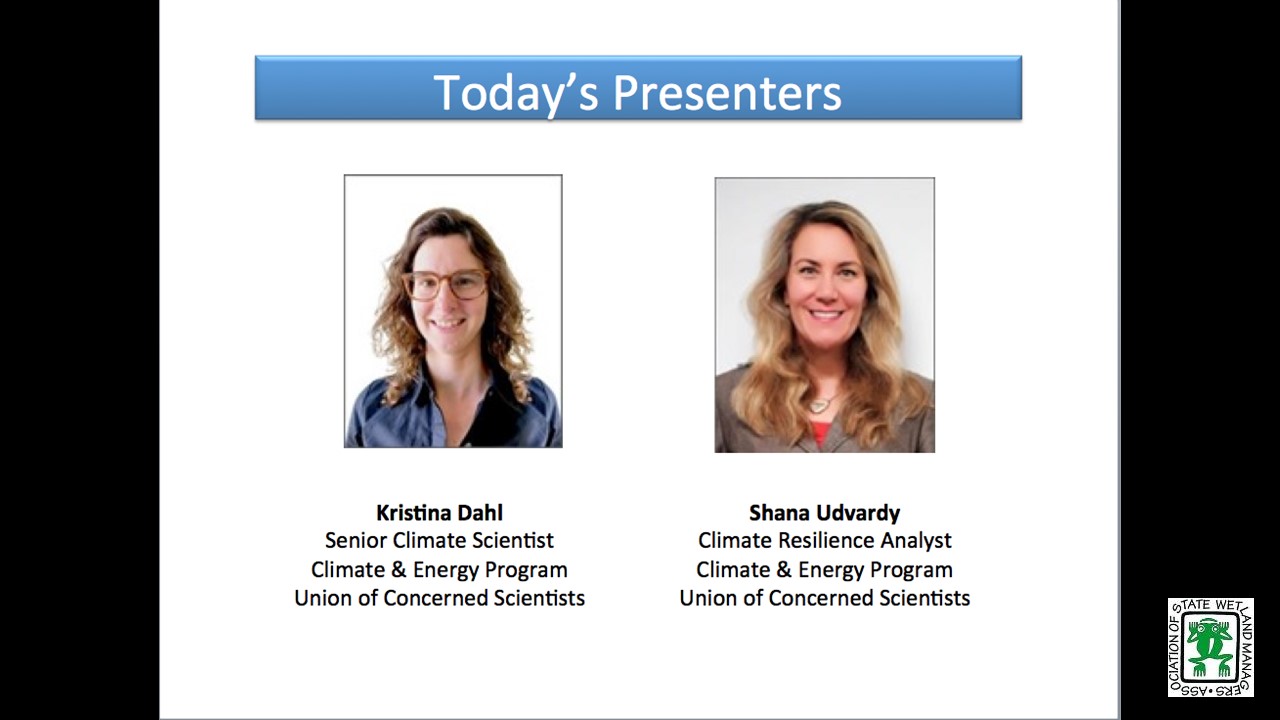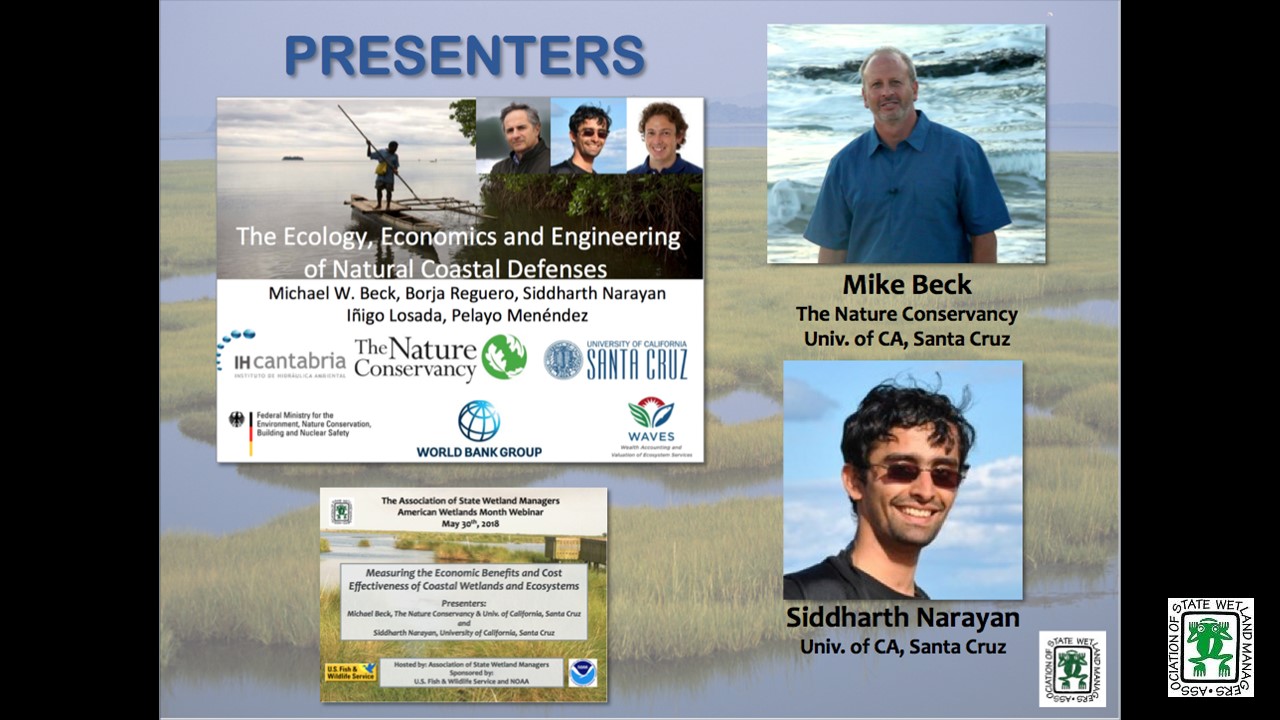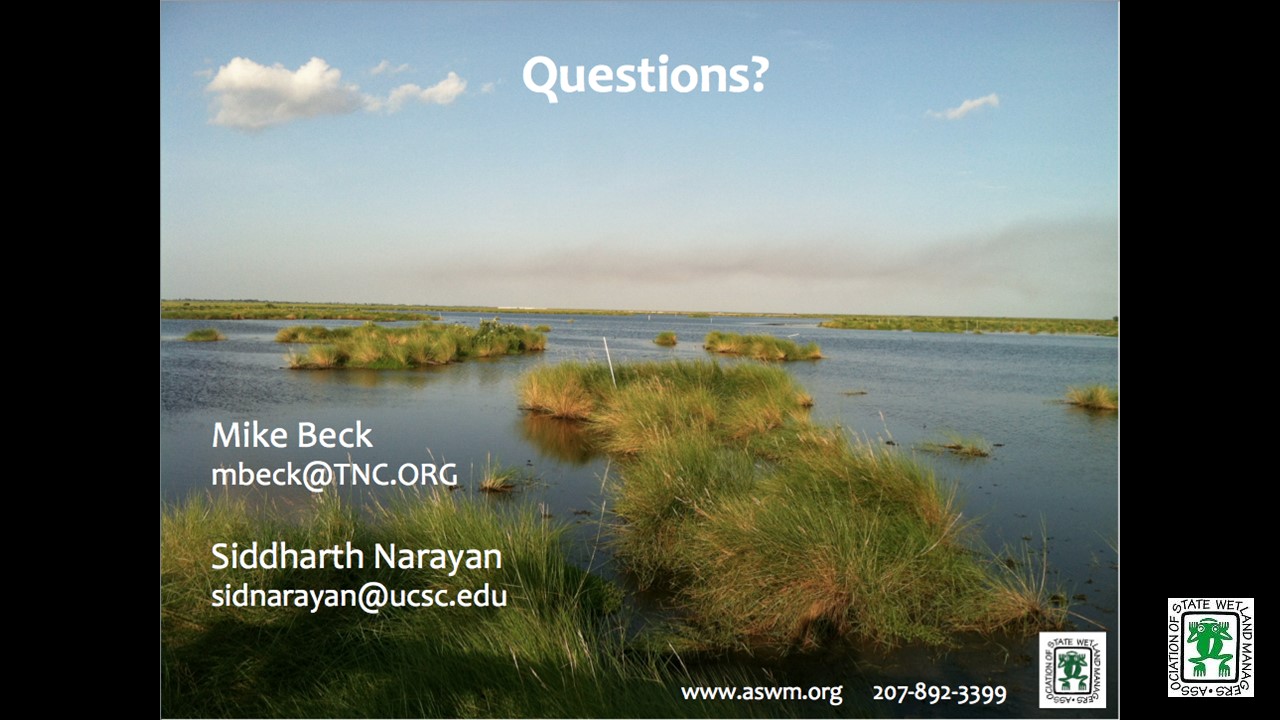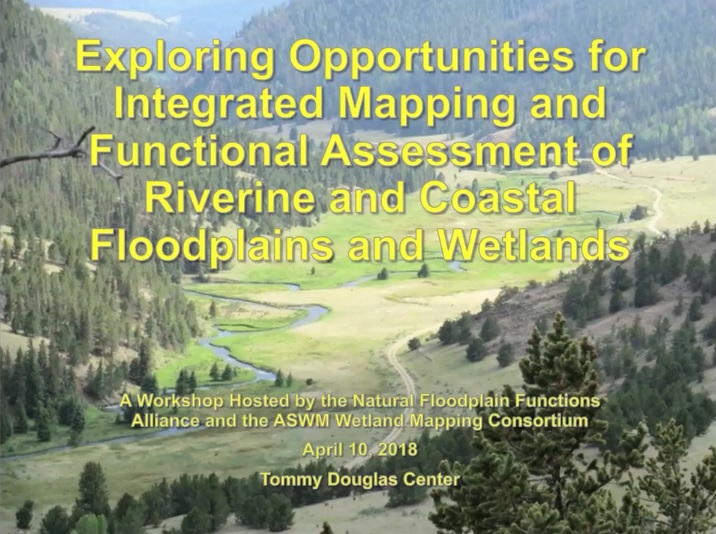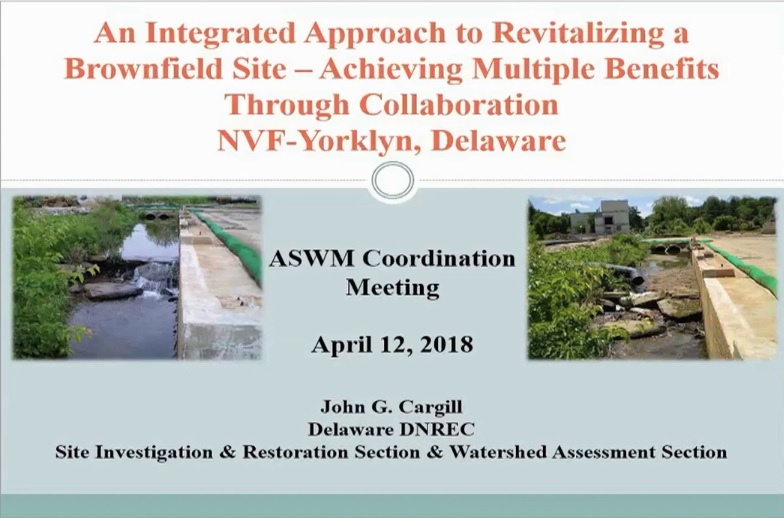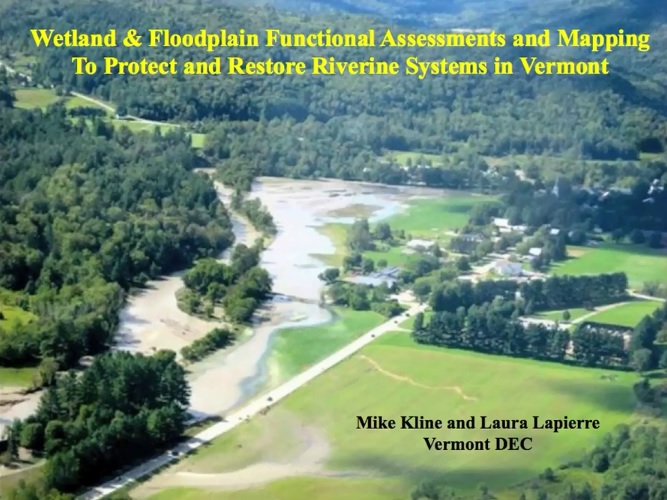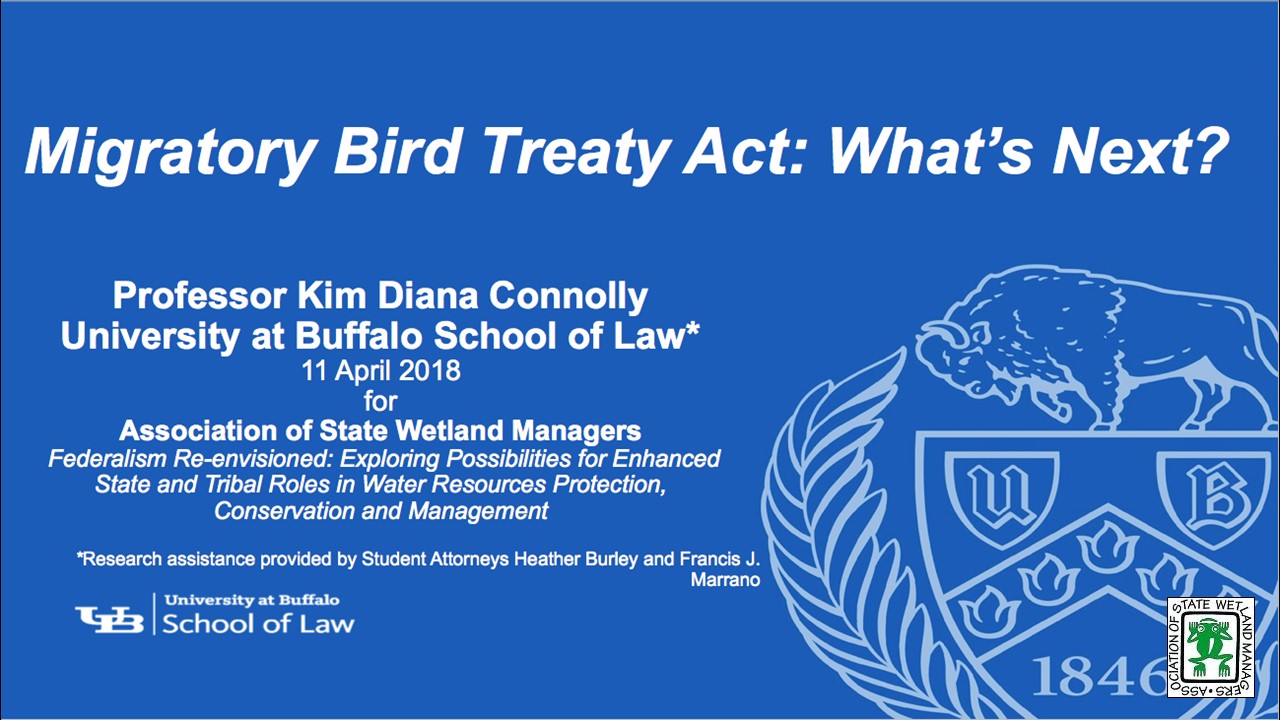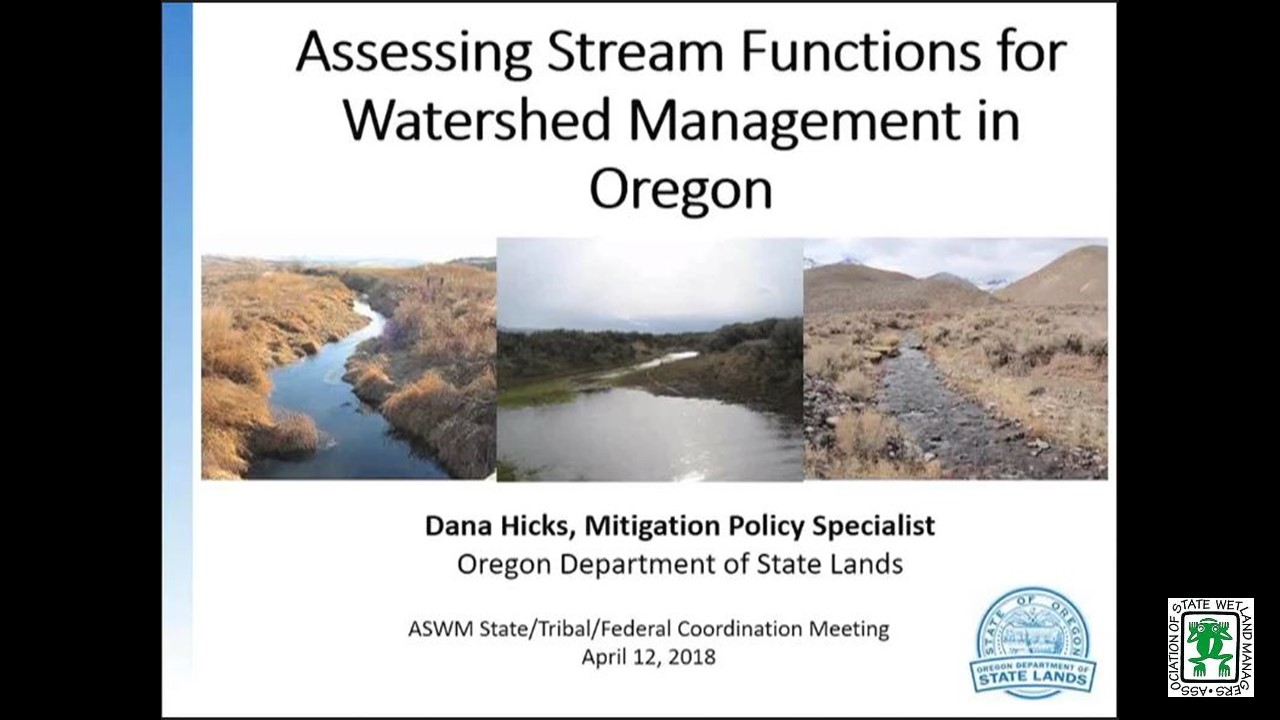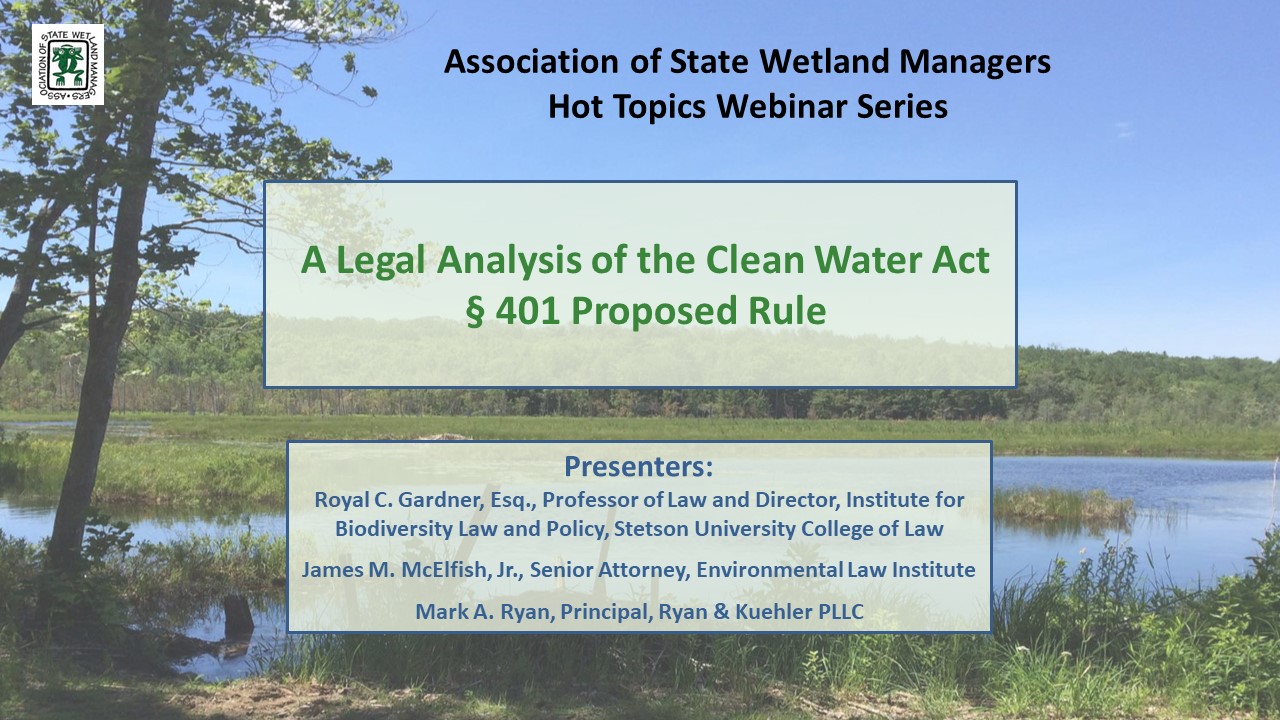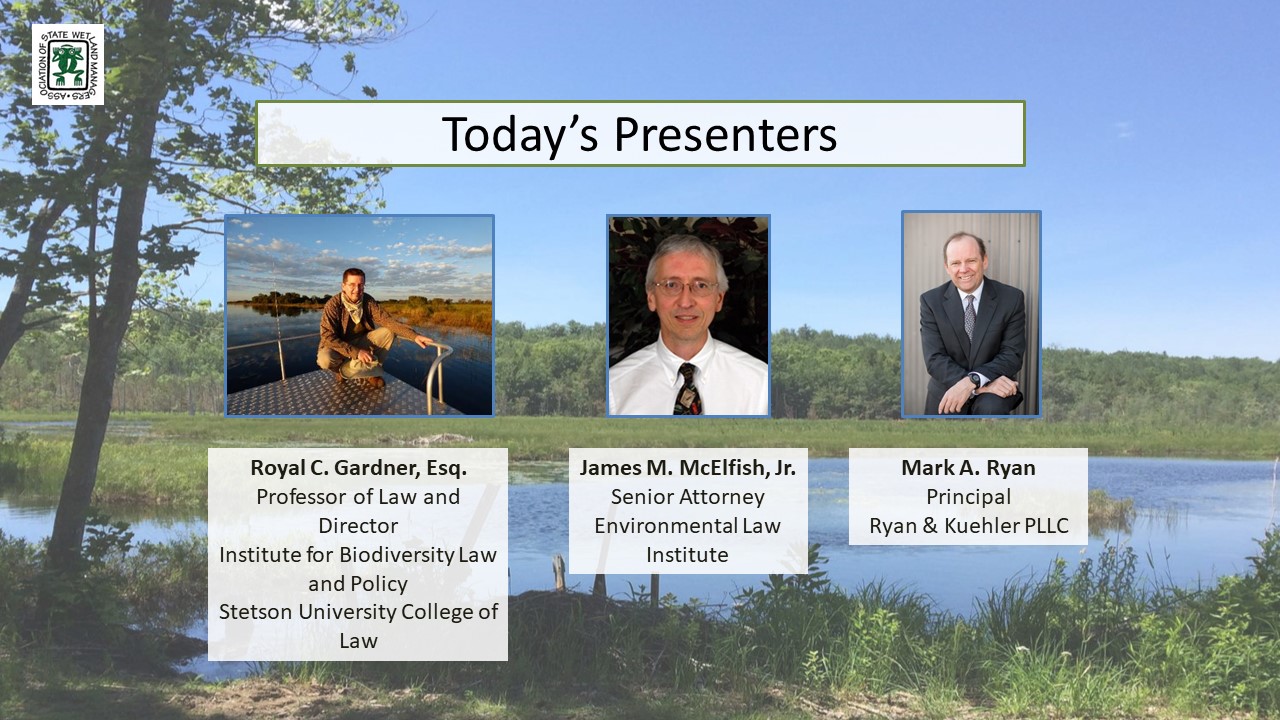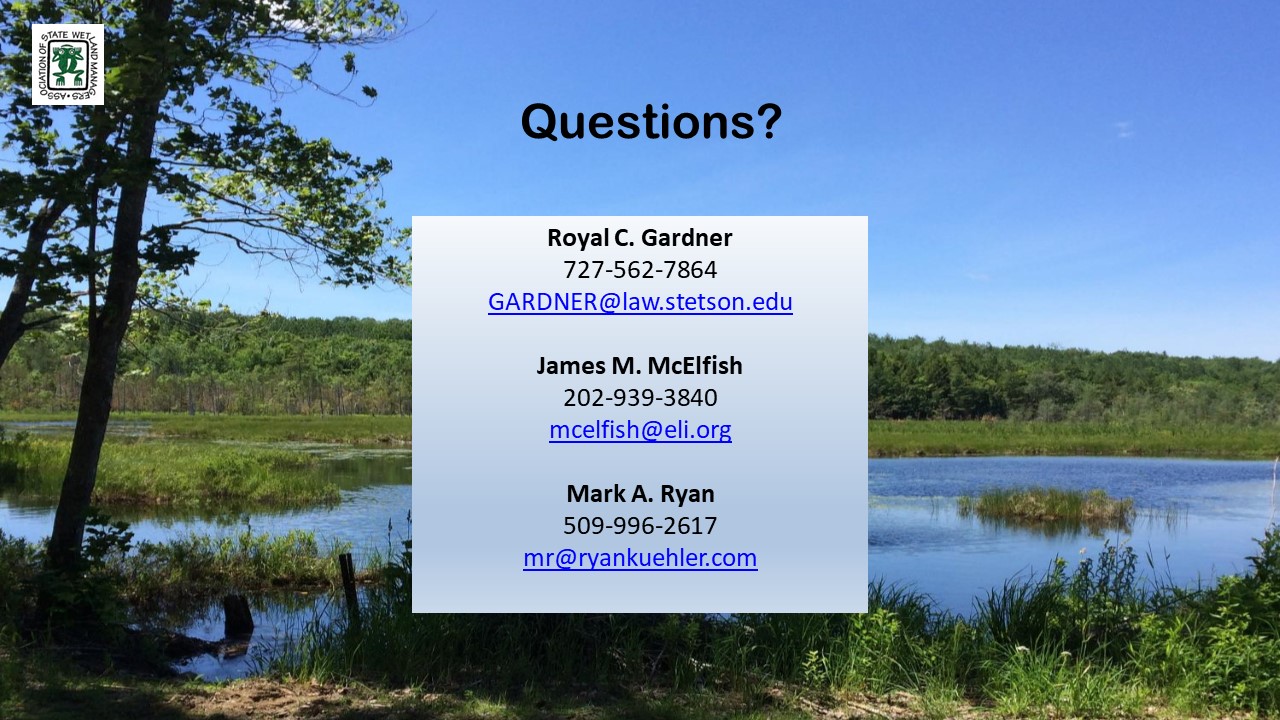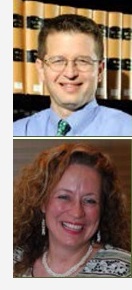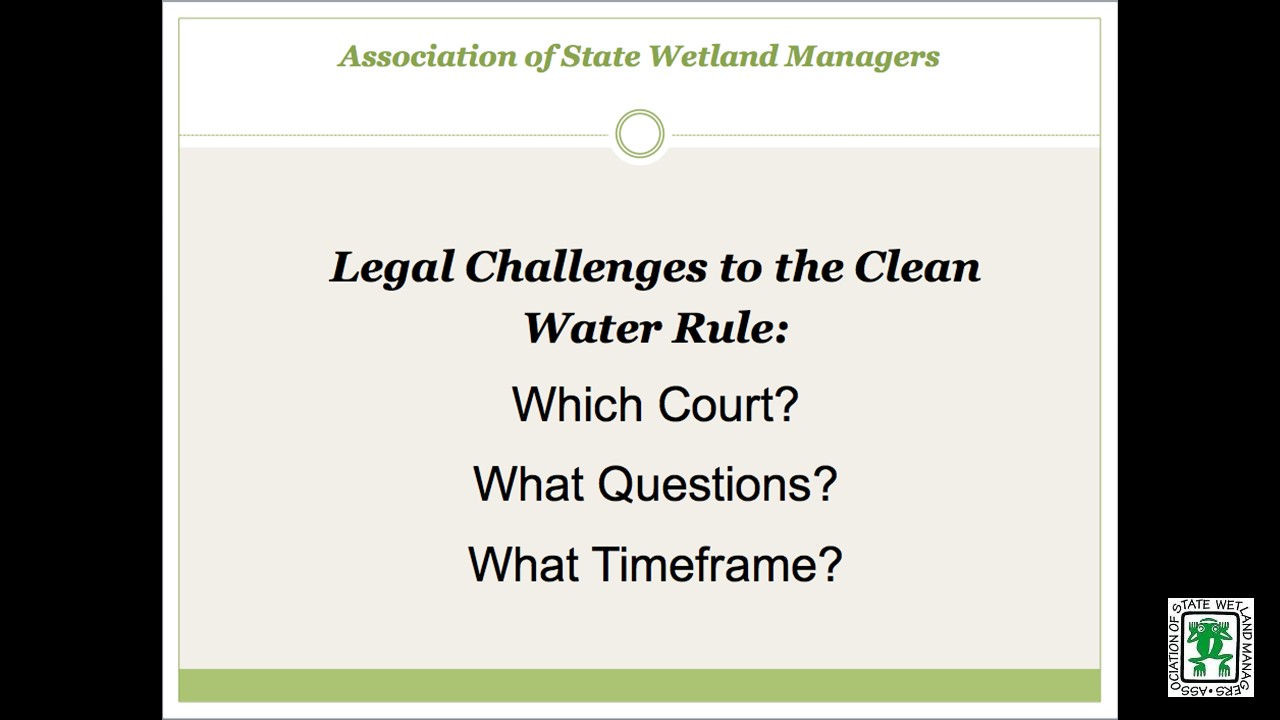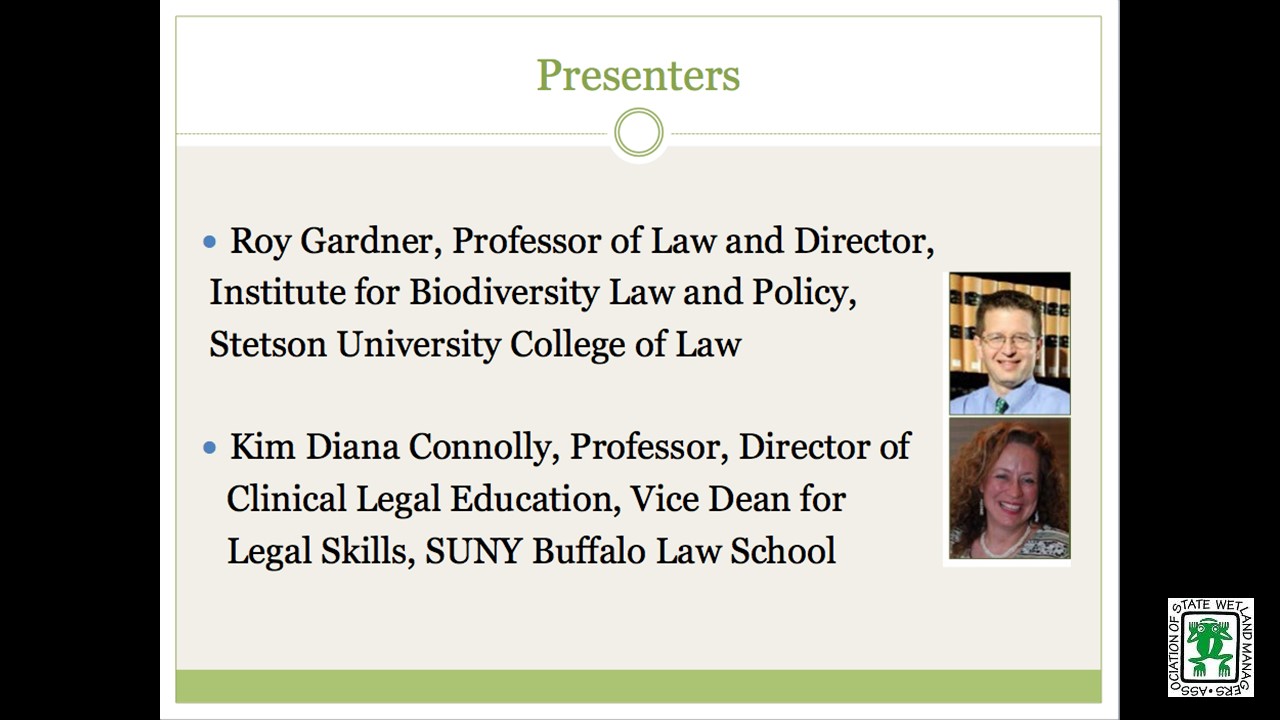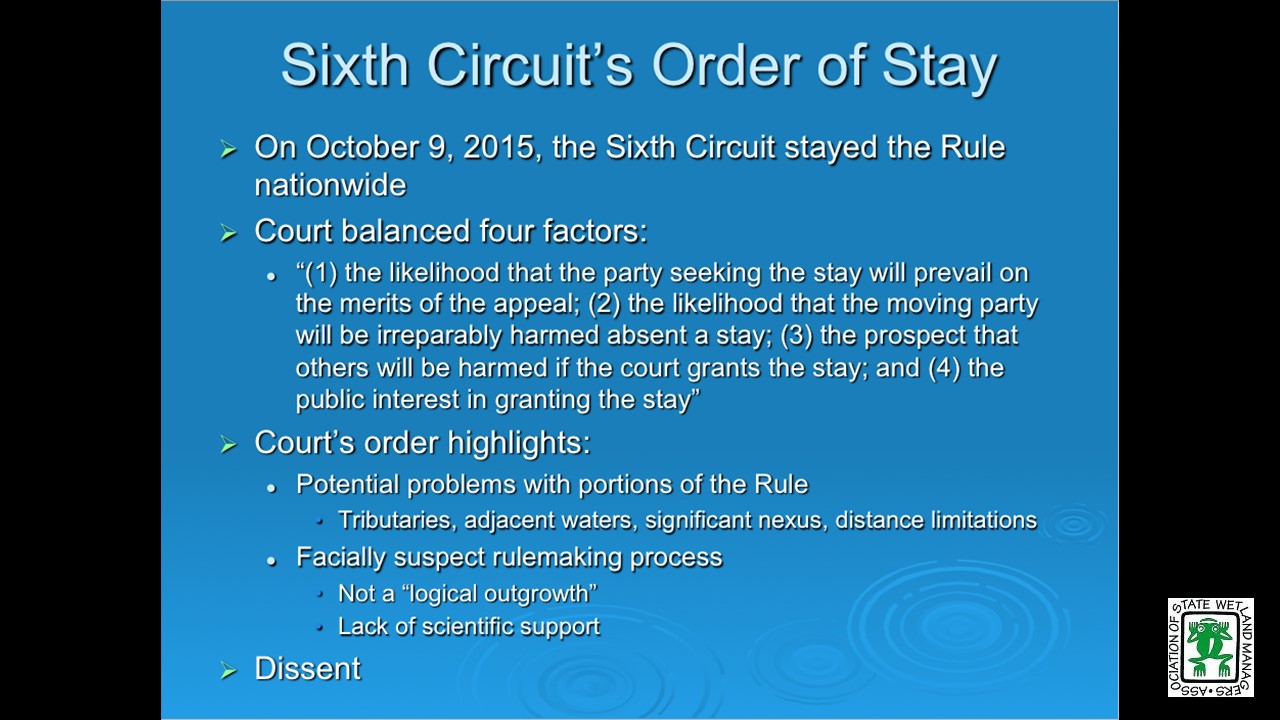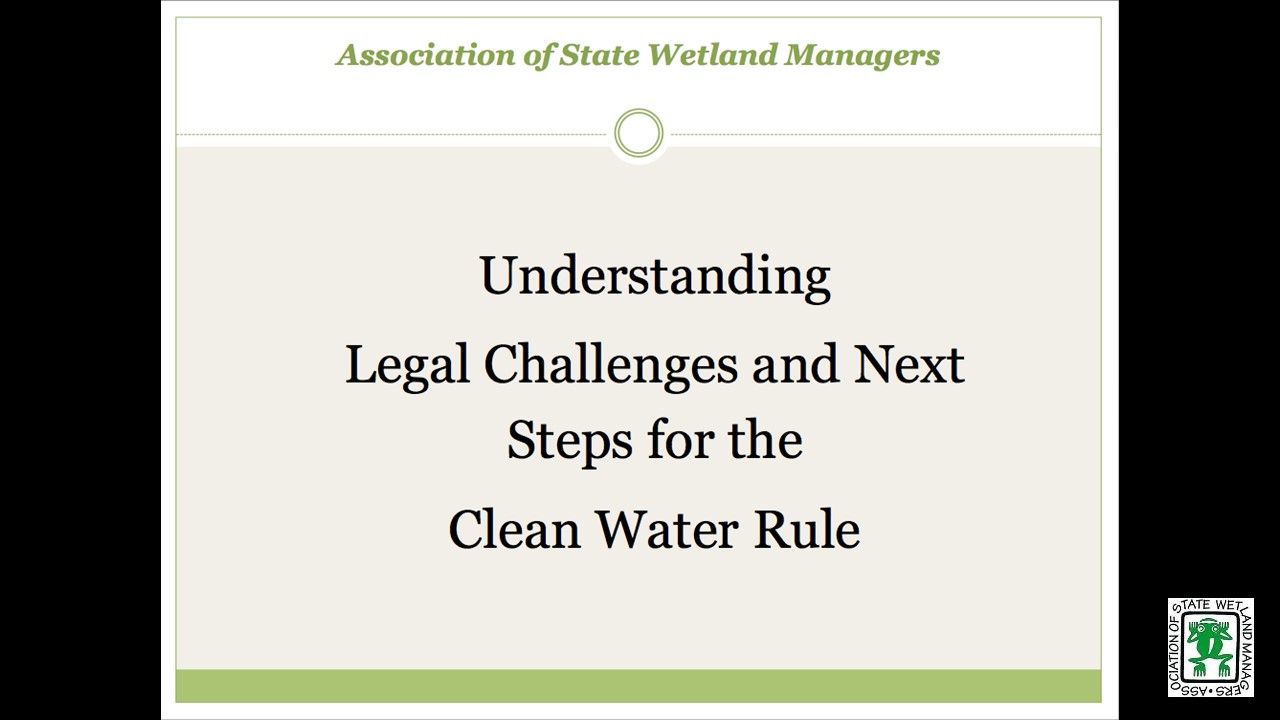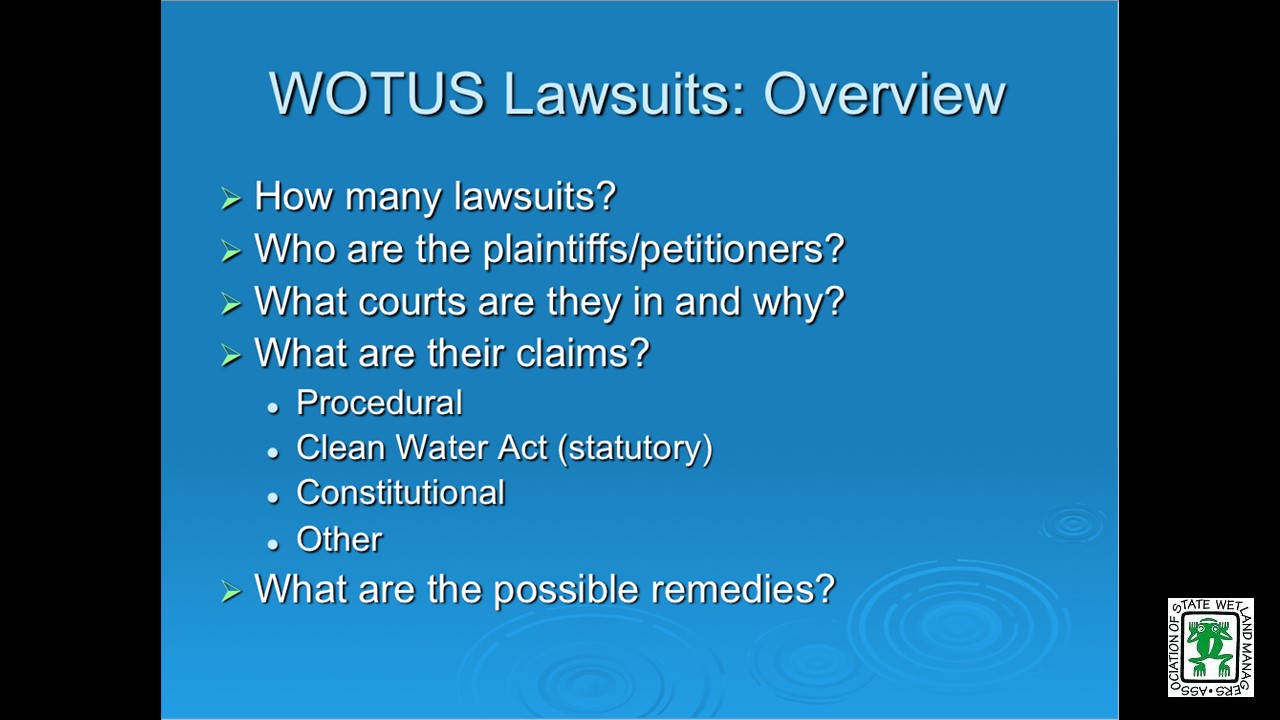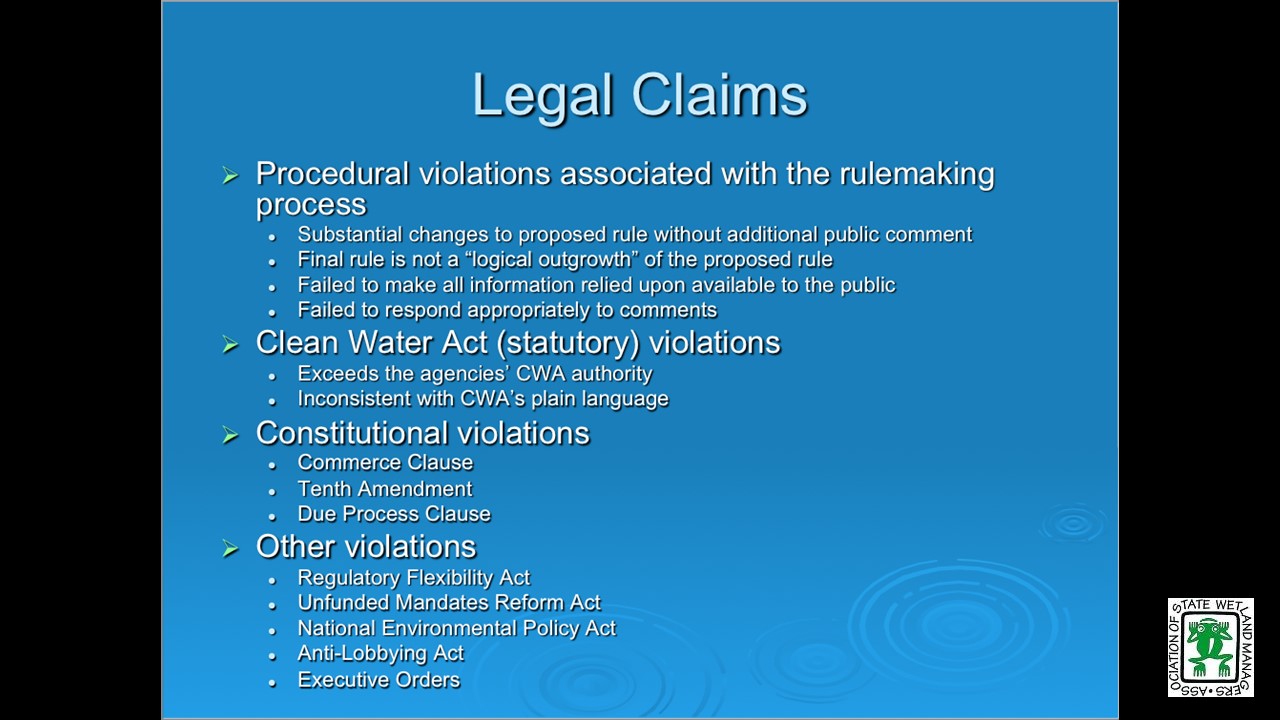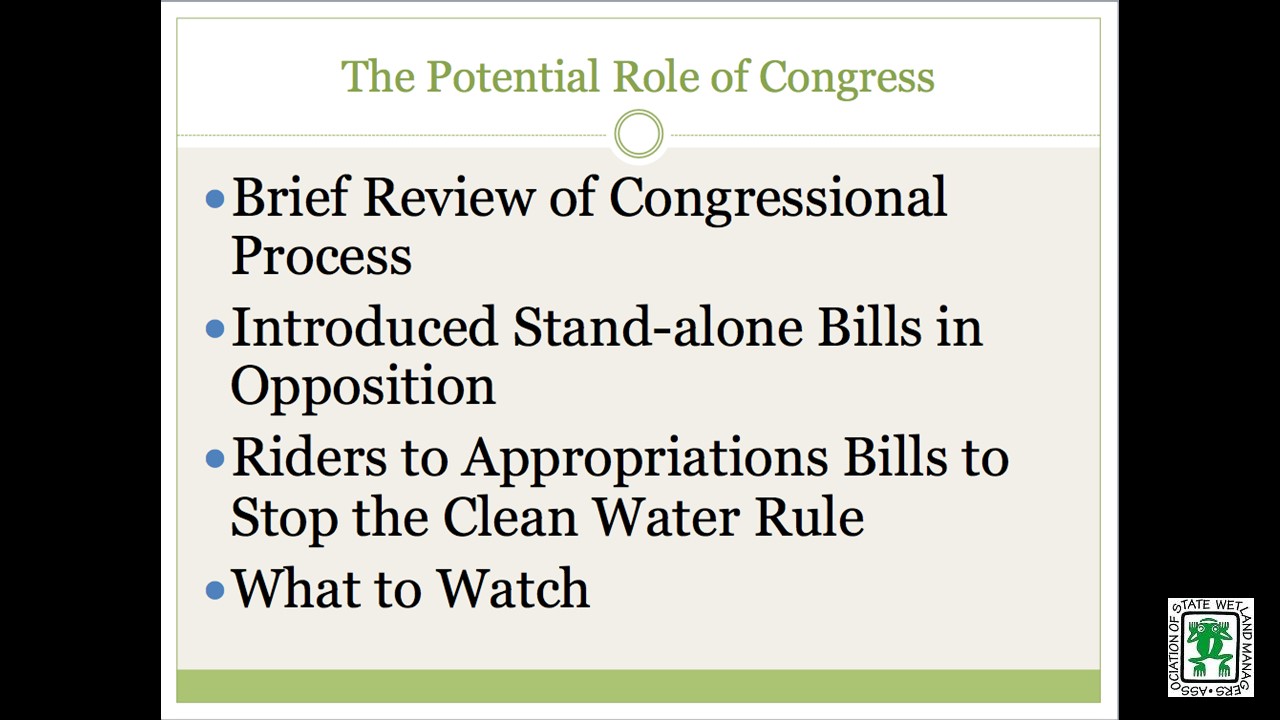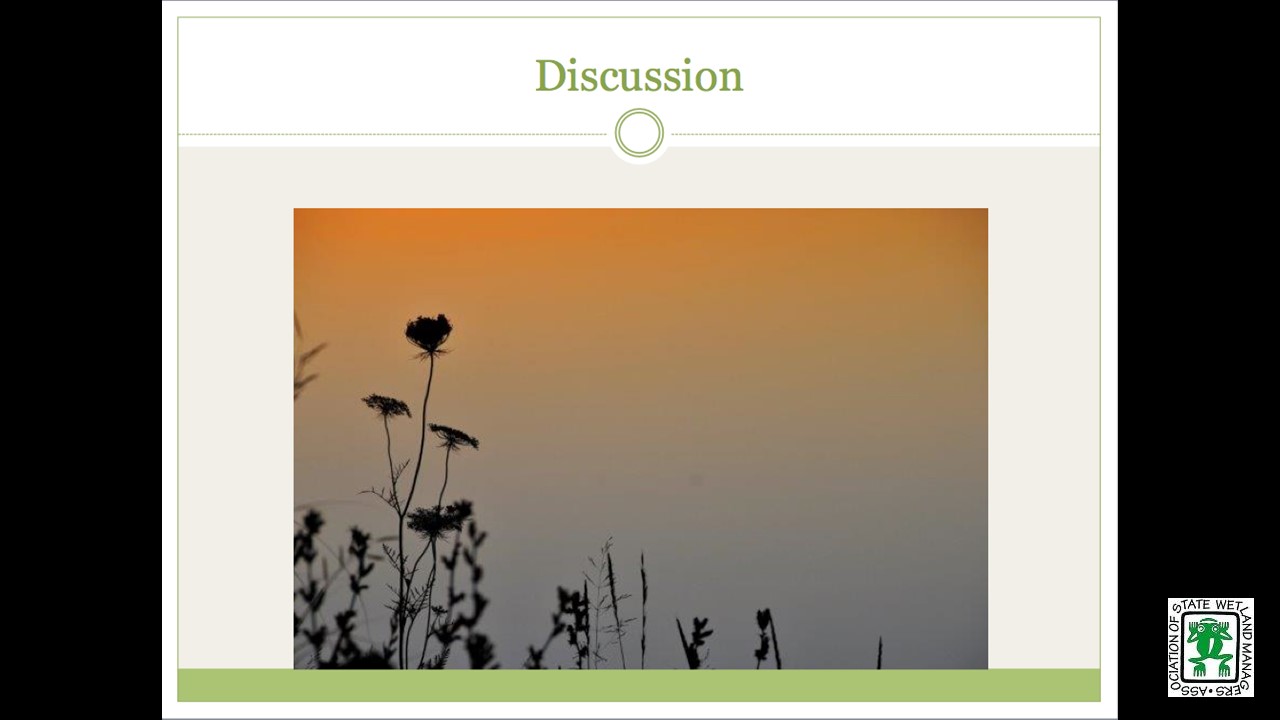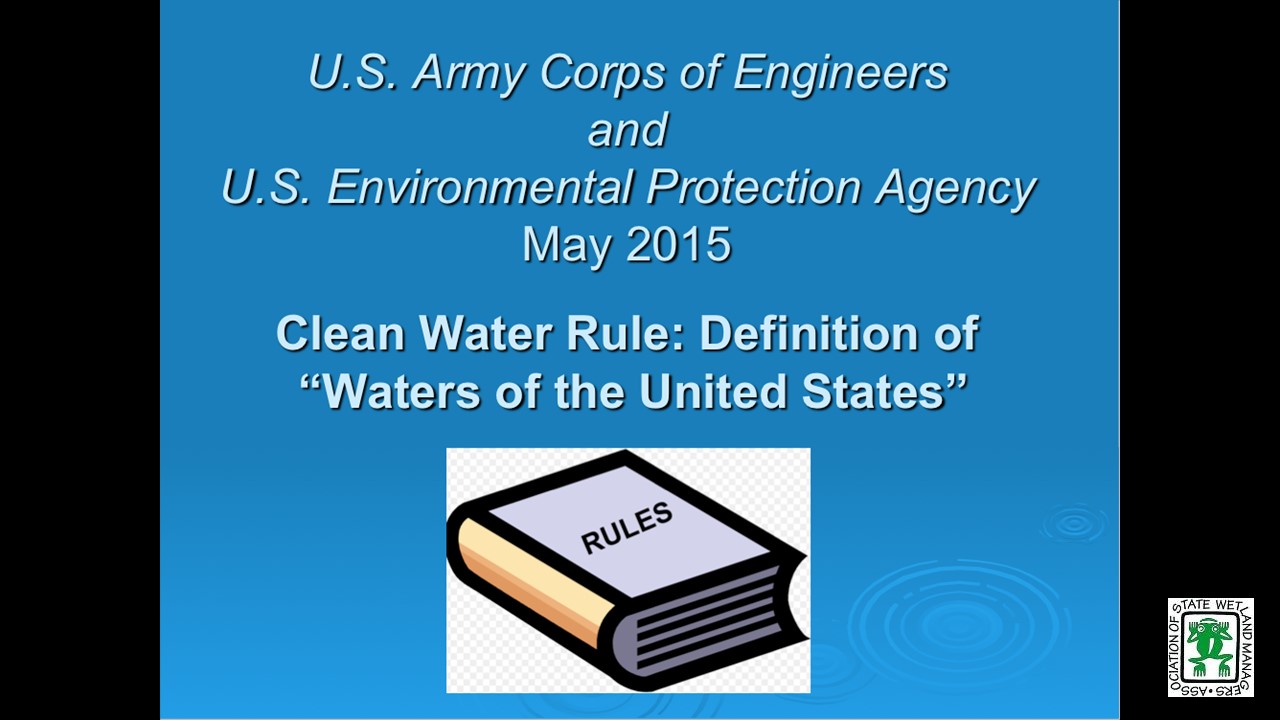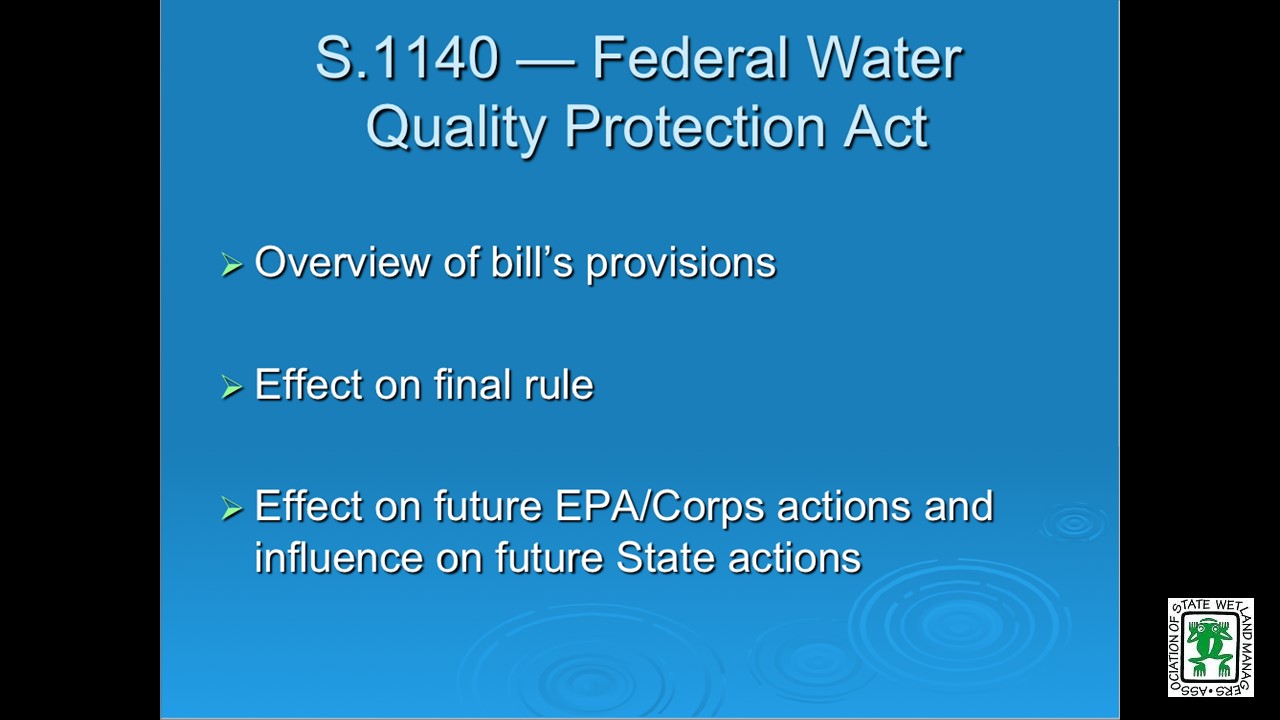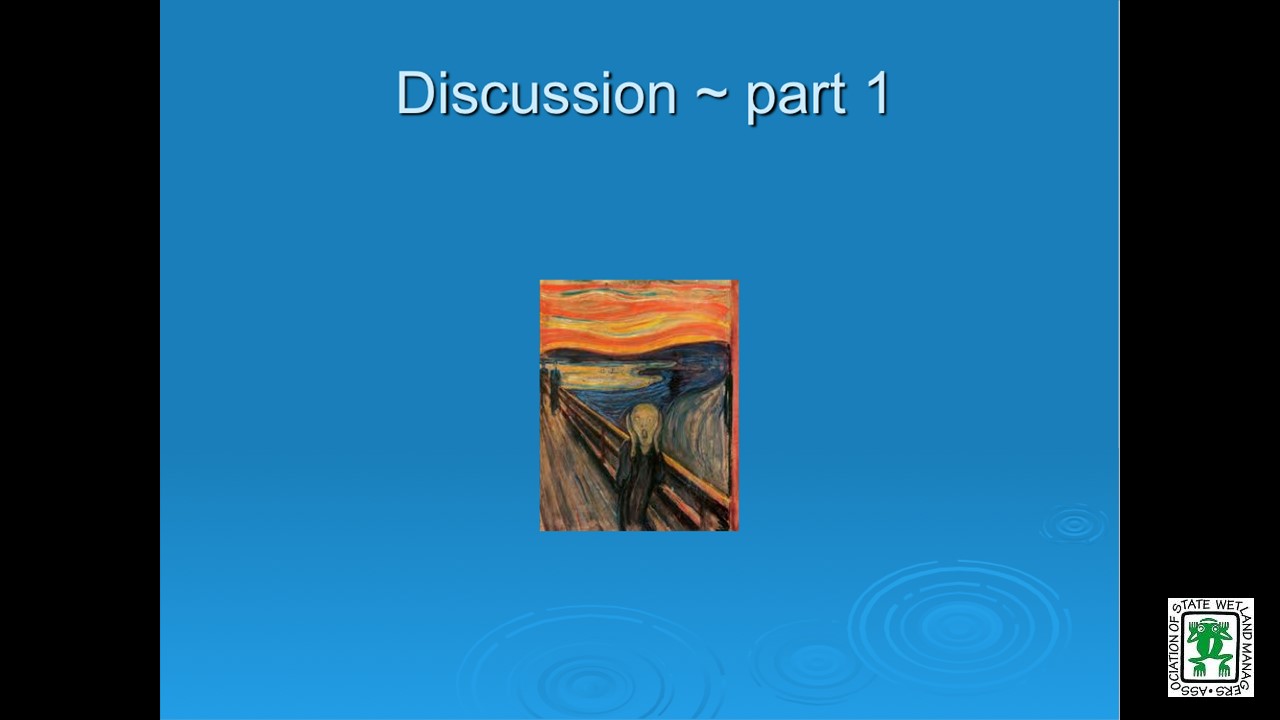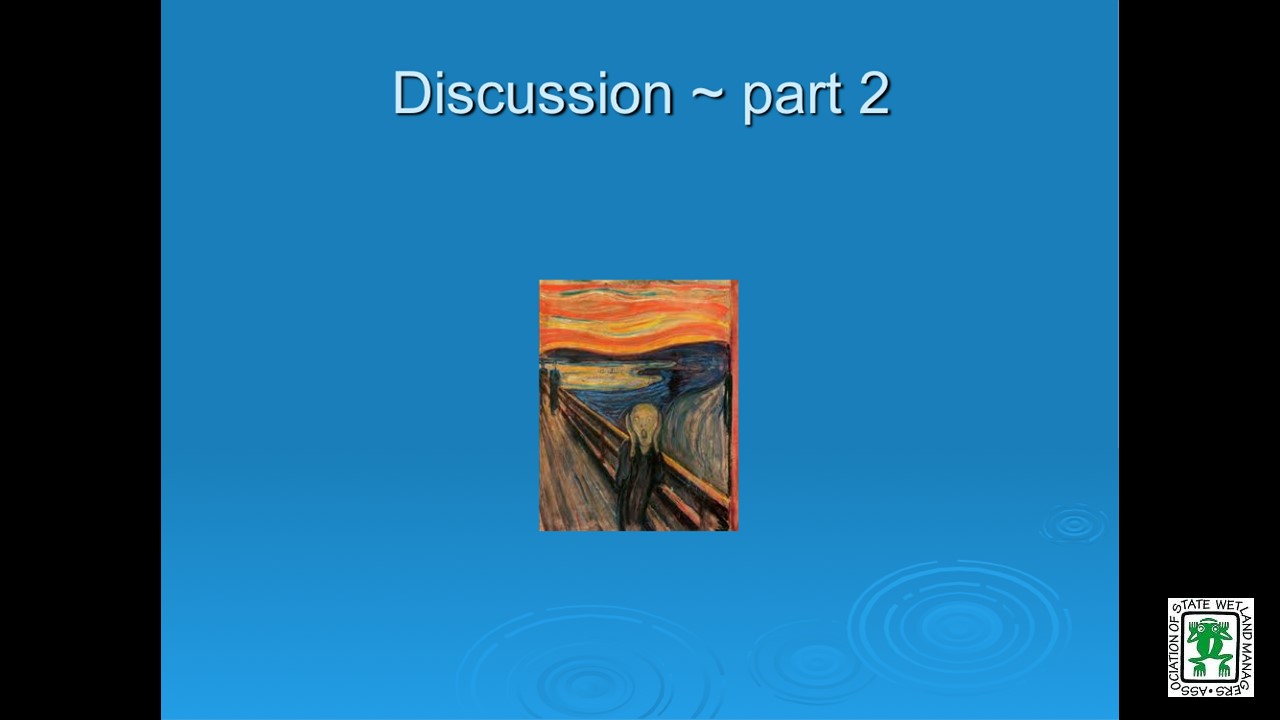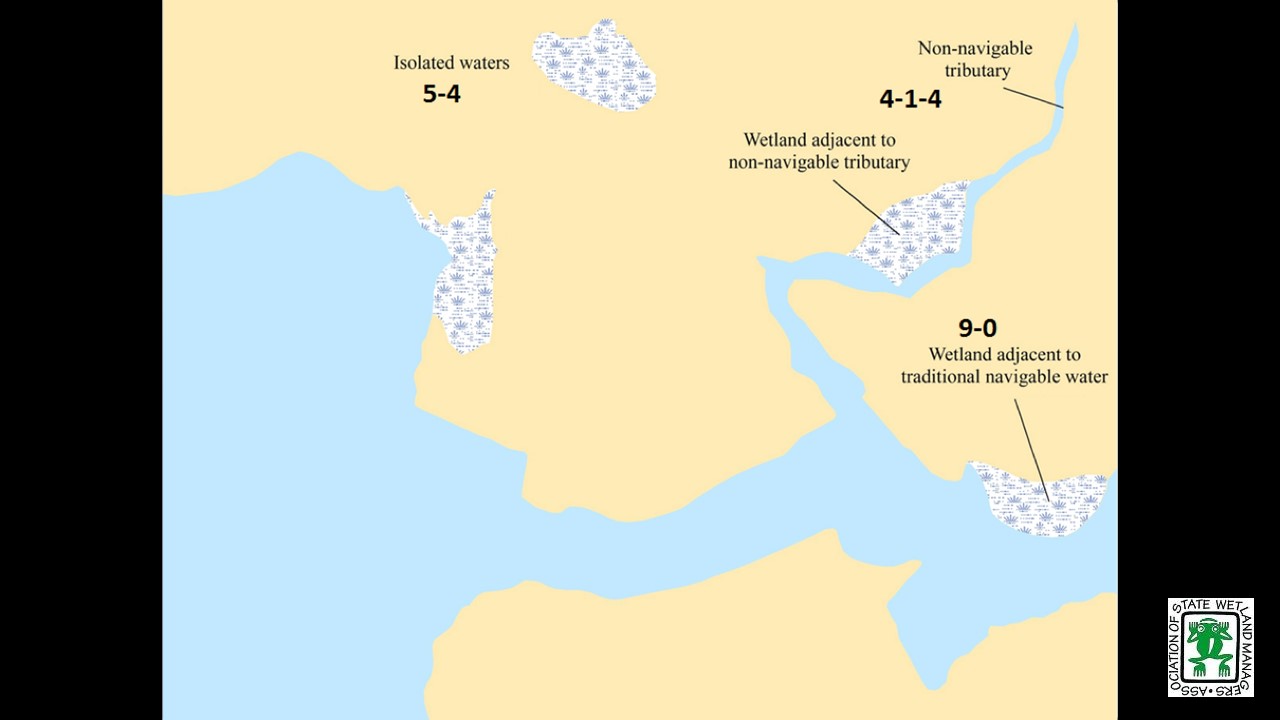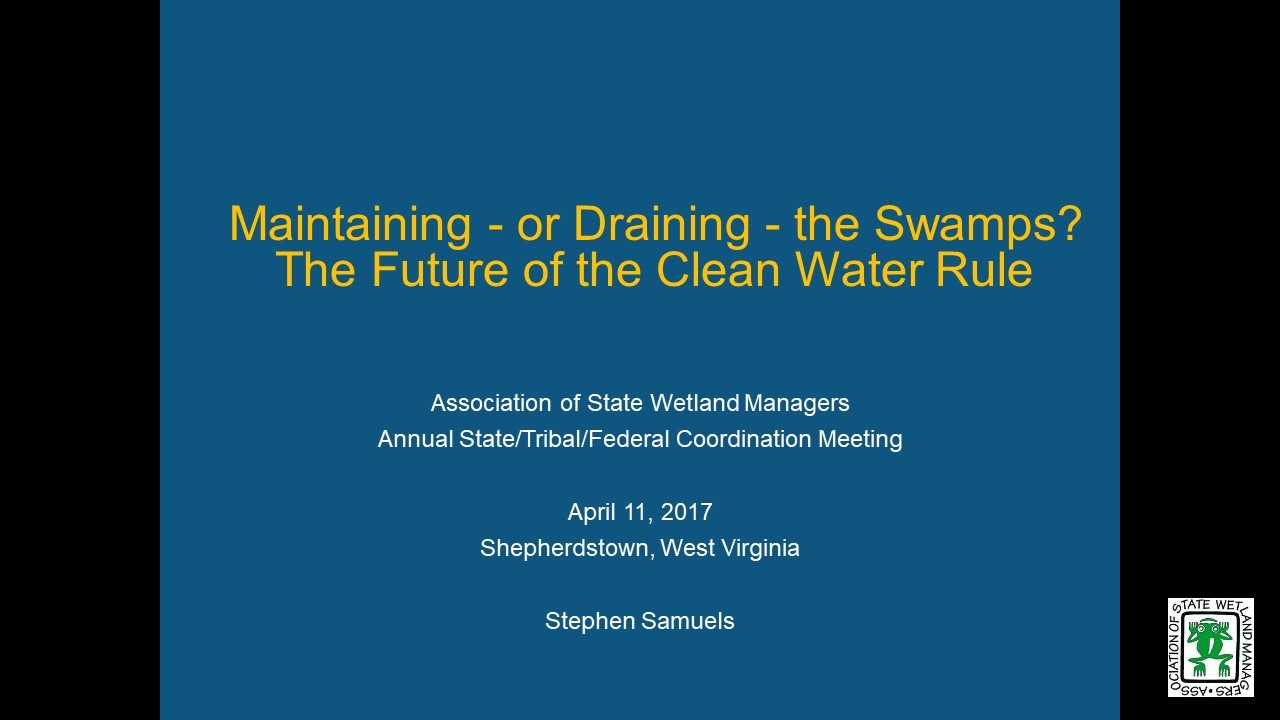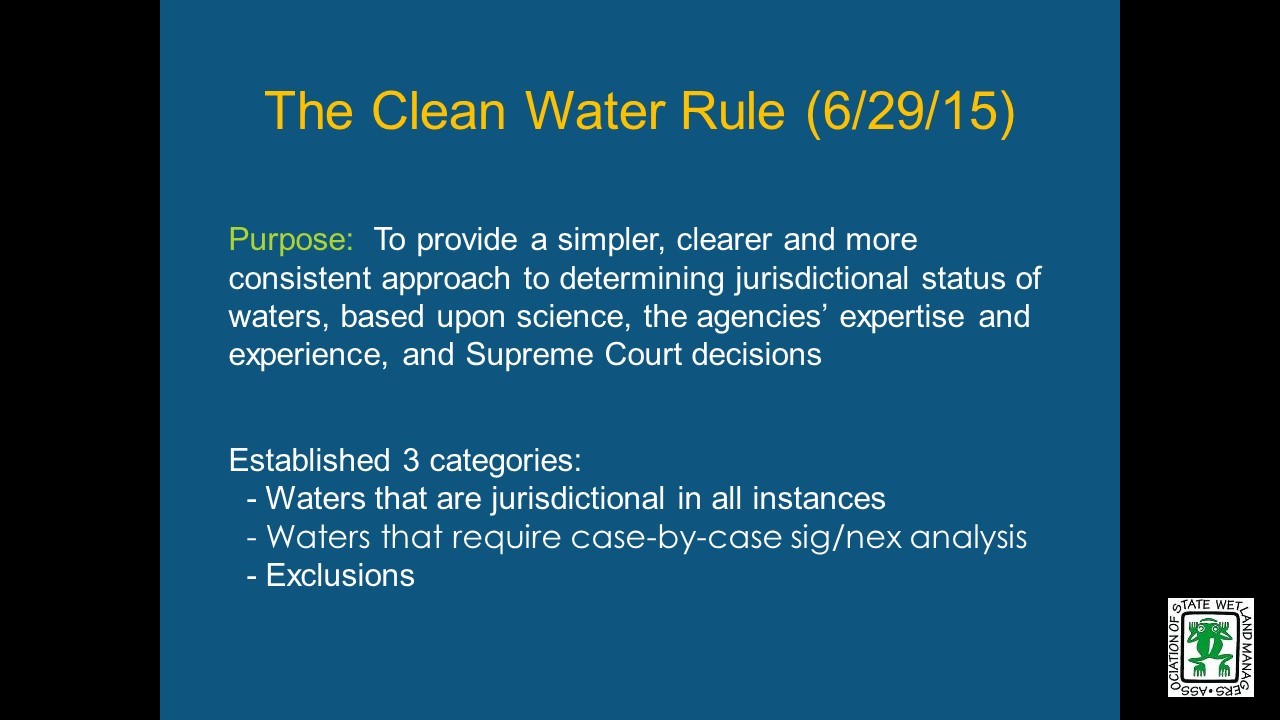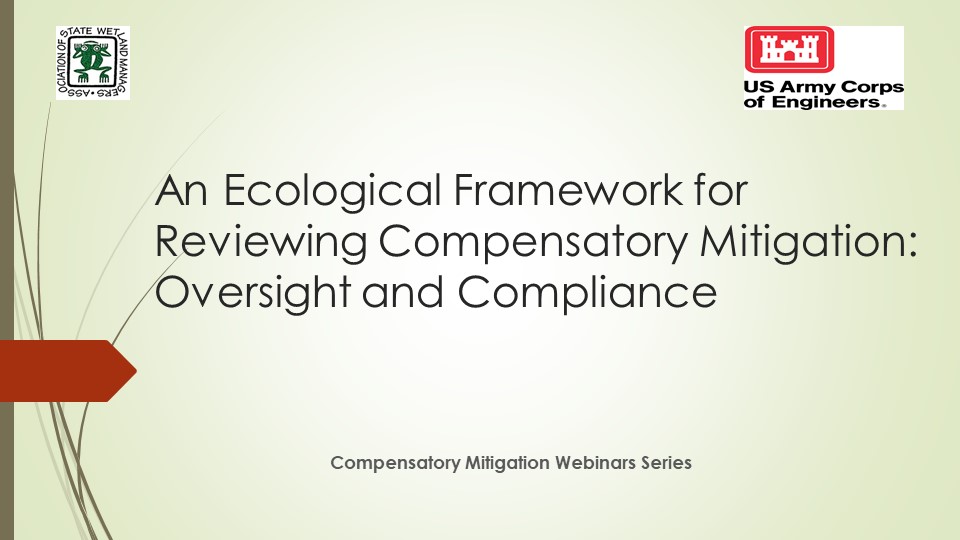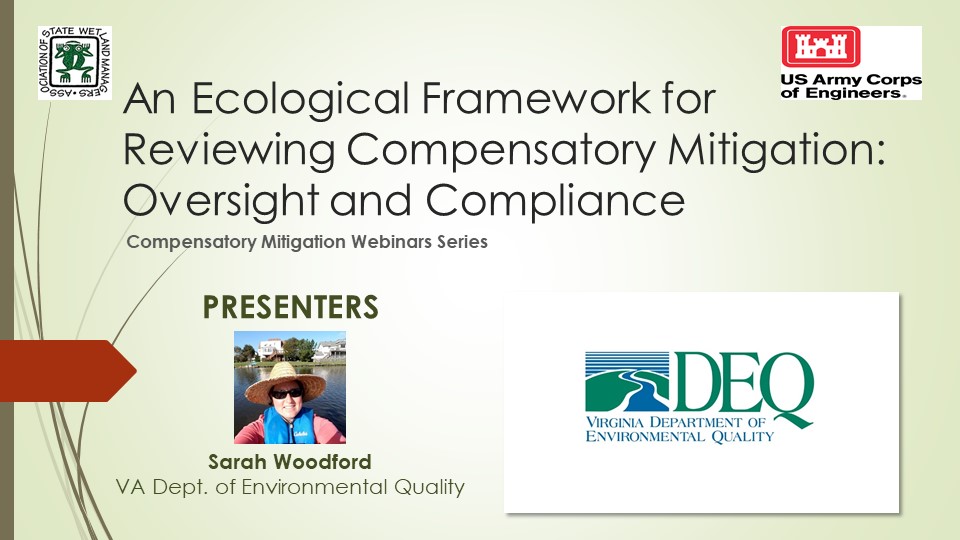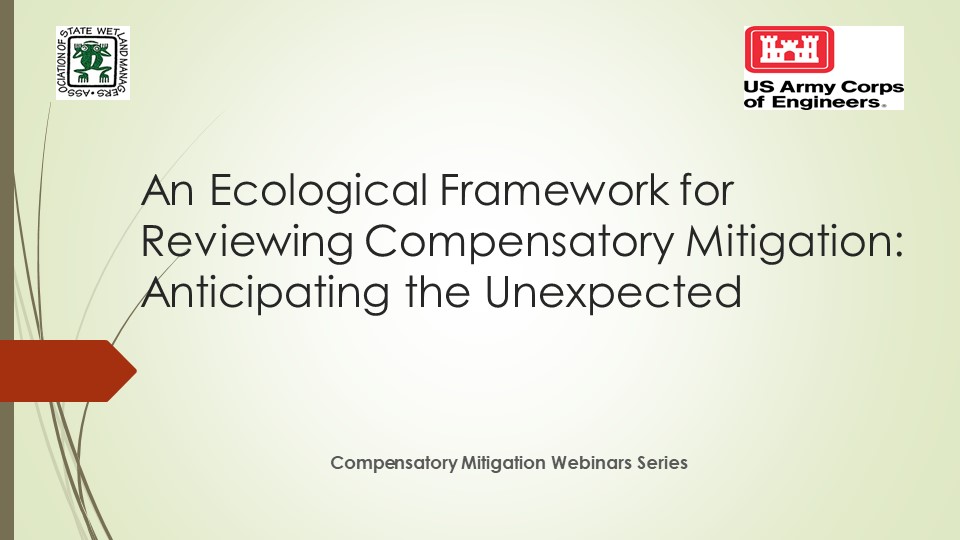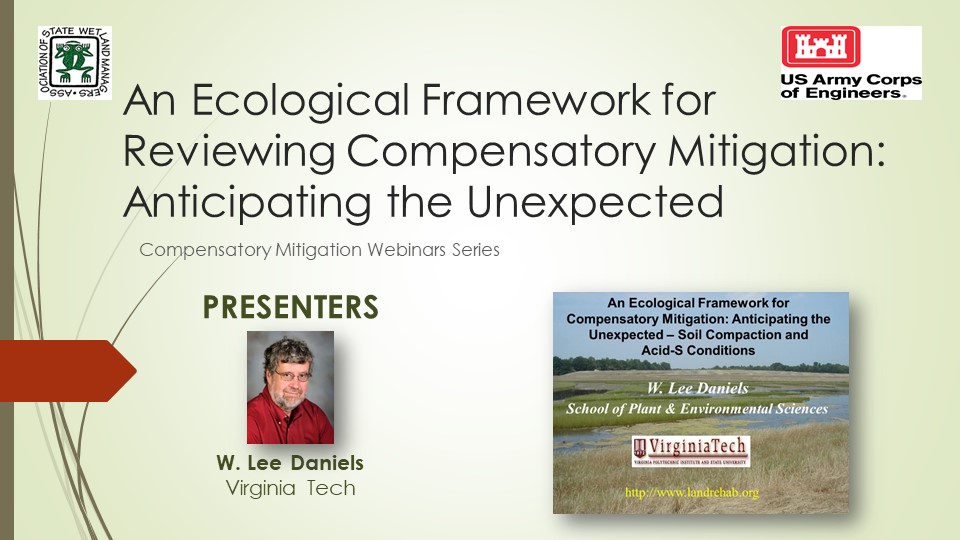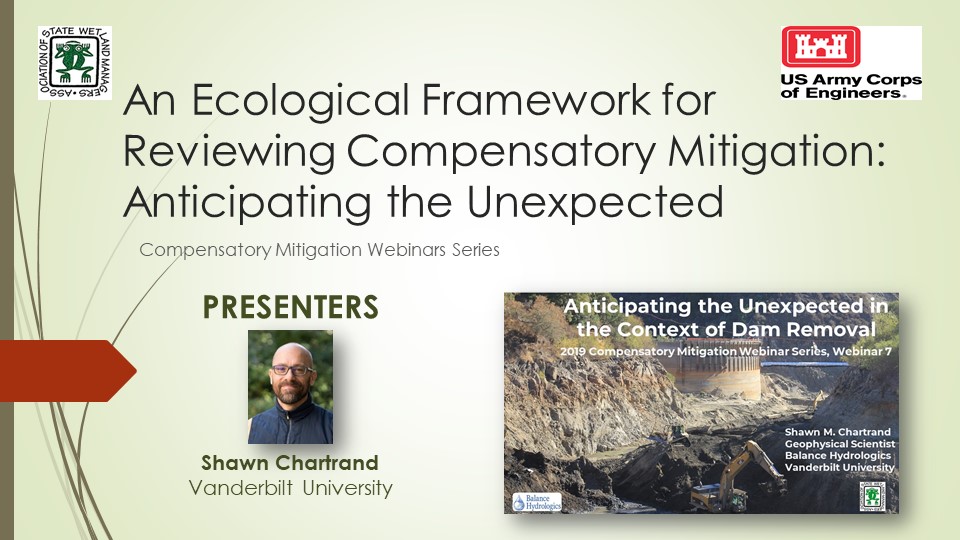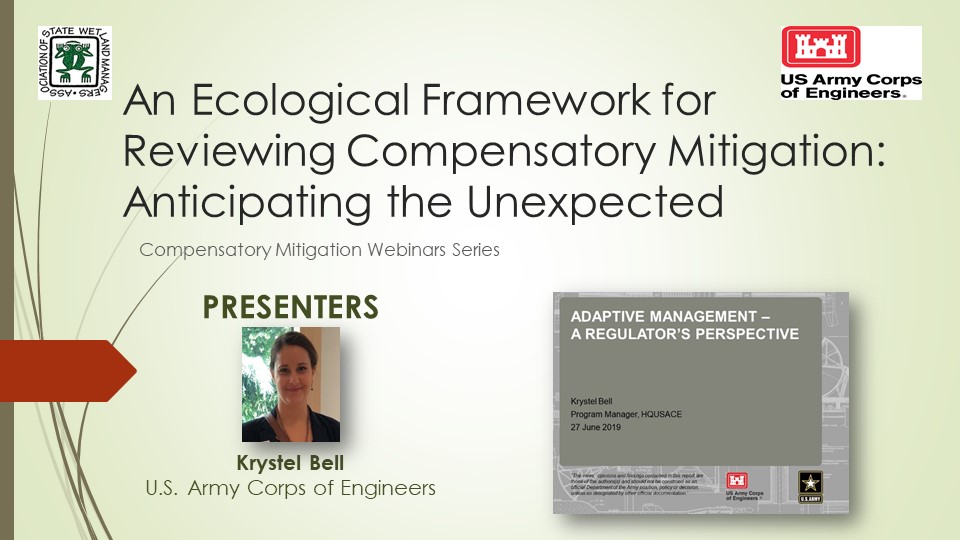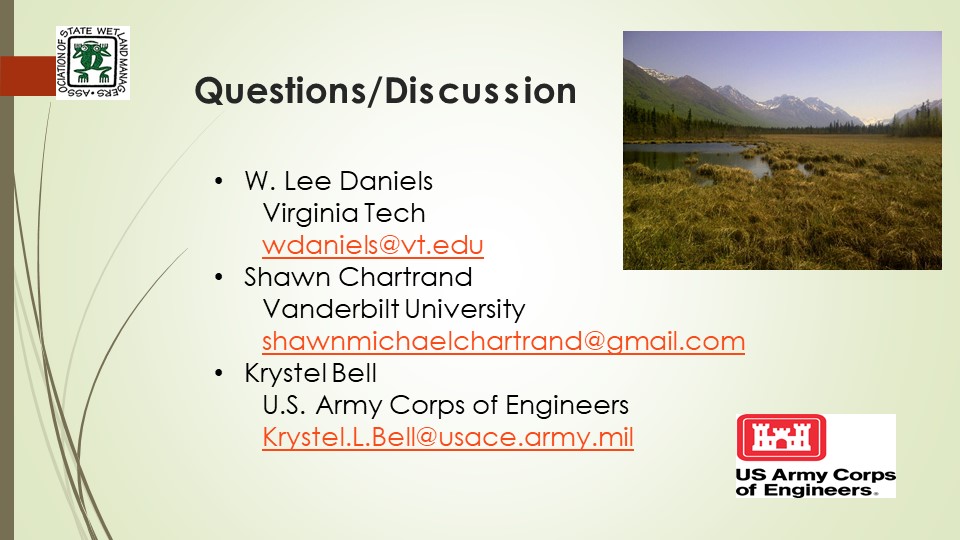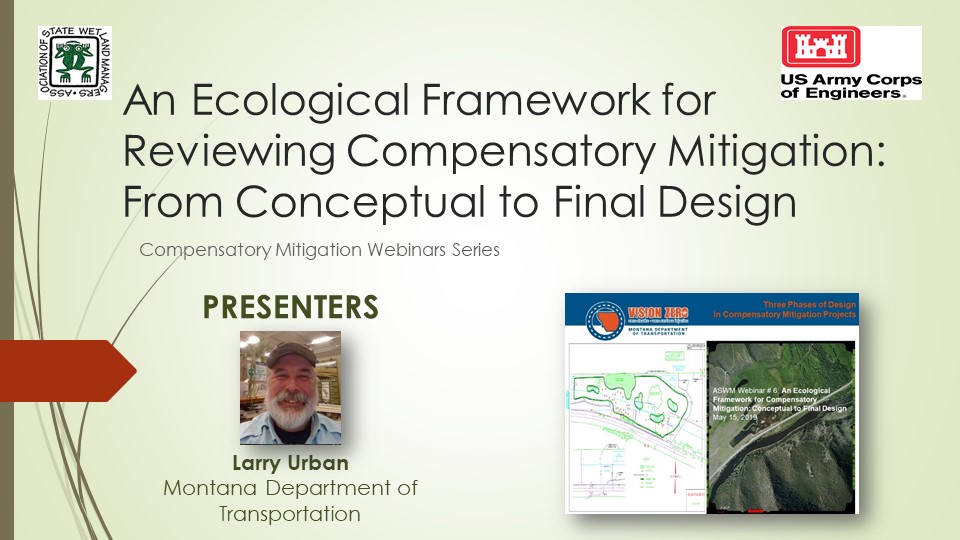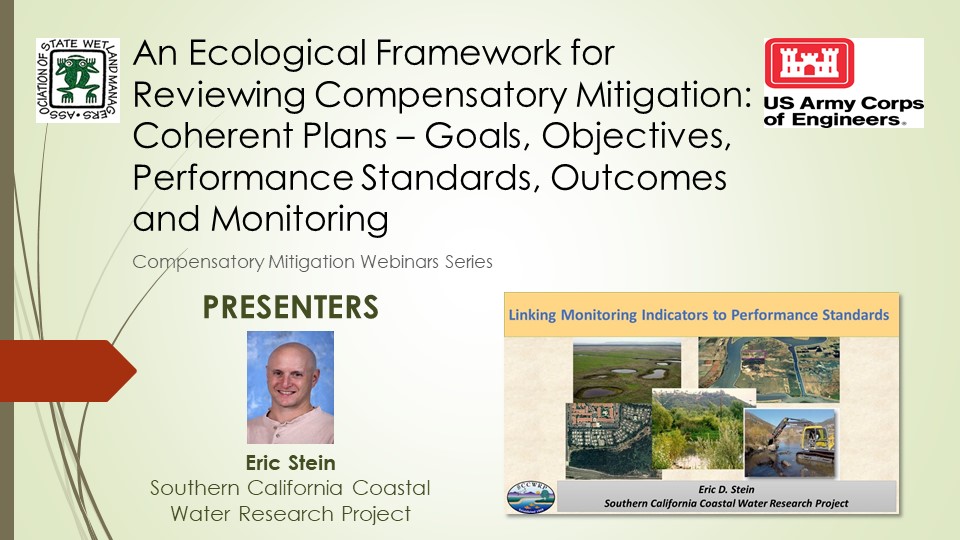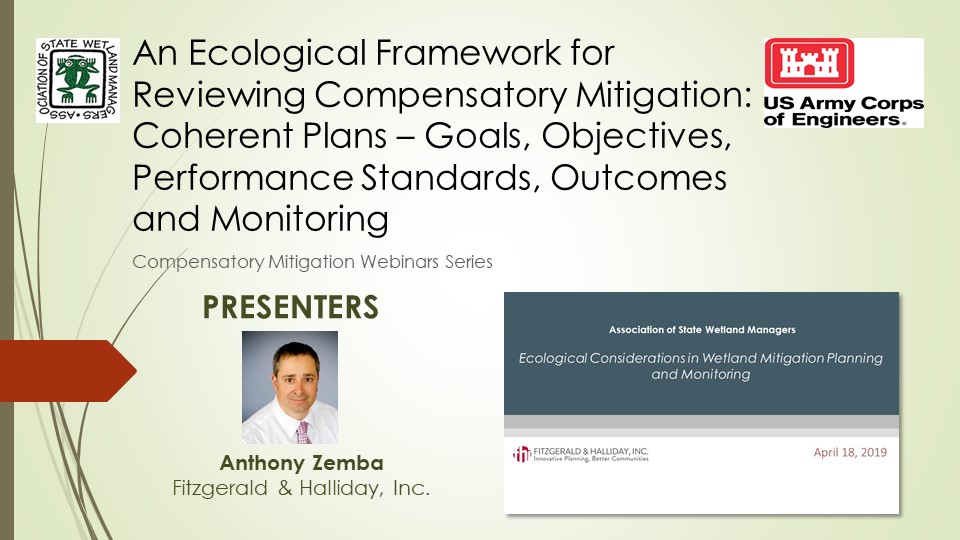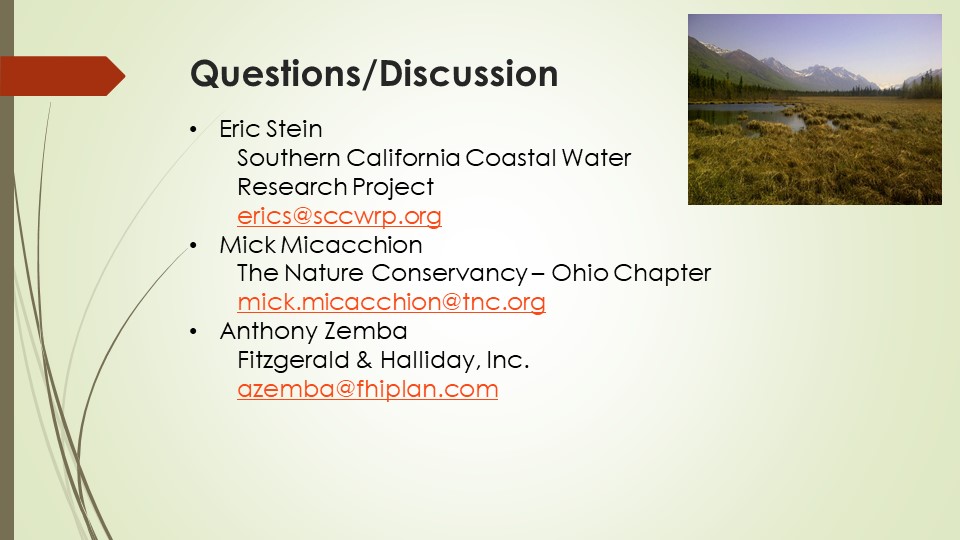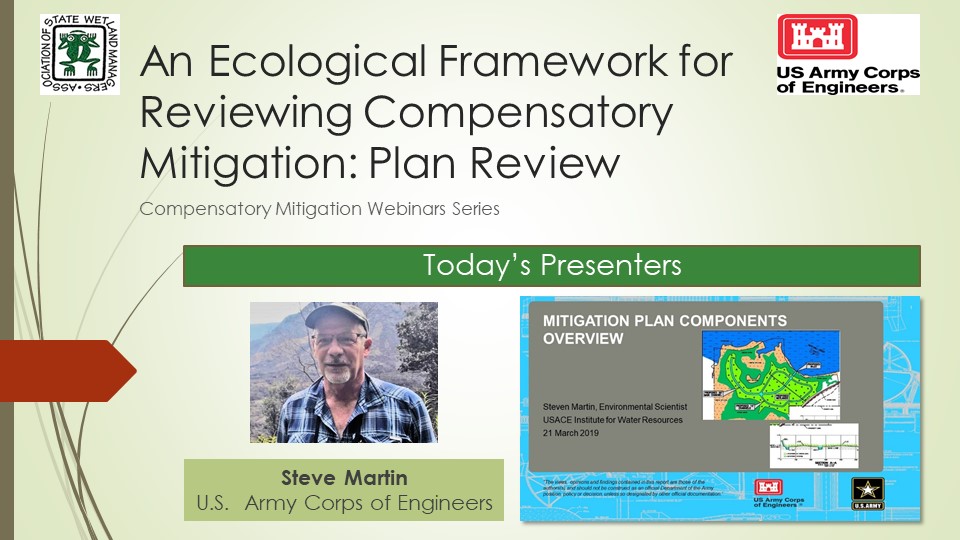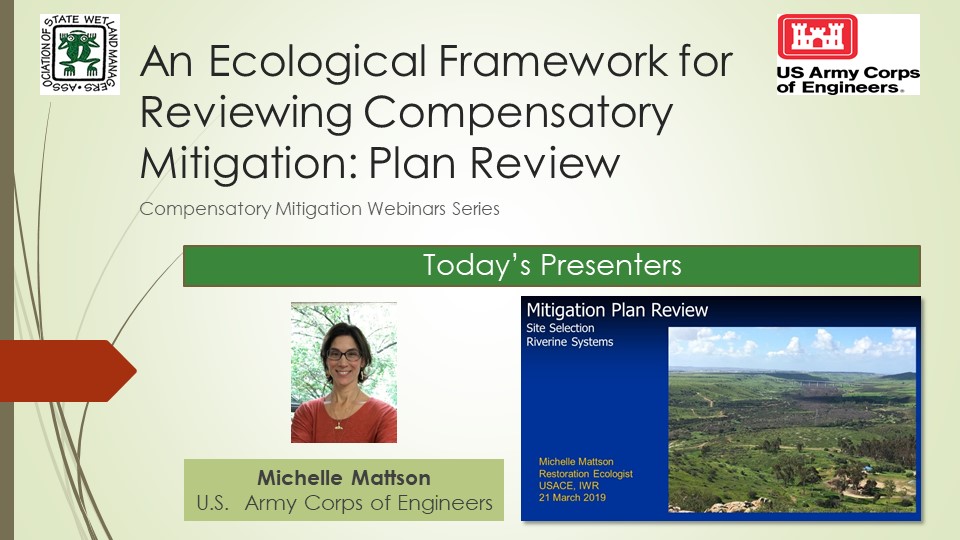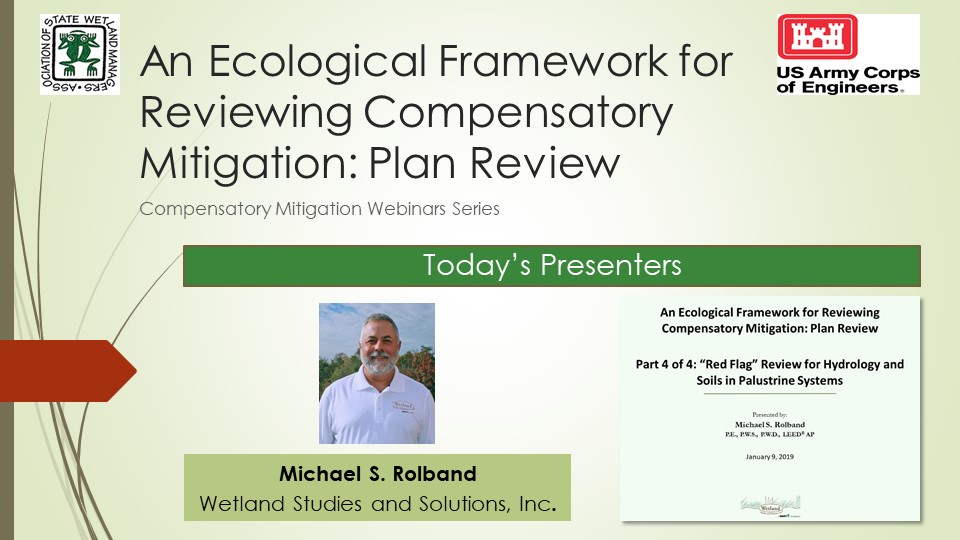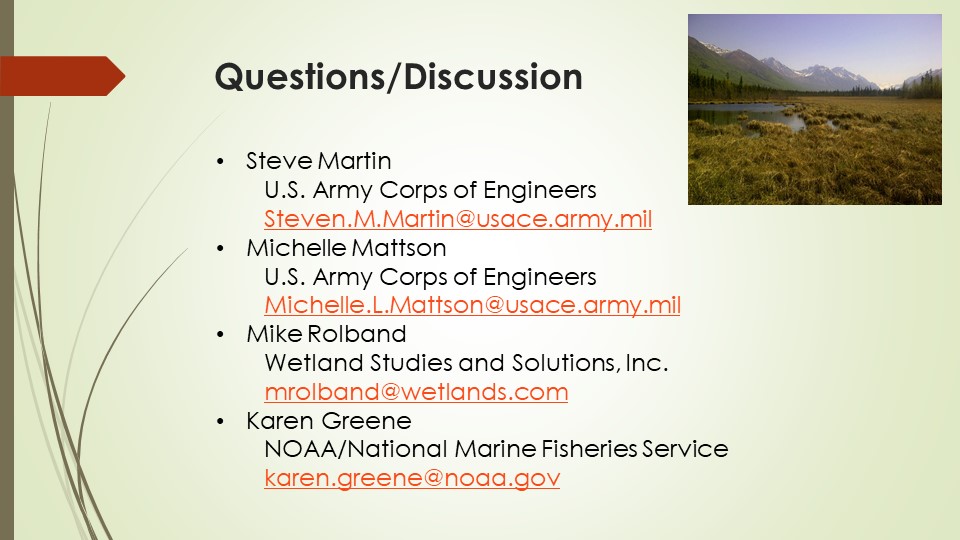NAWM
The National Association of Wetland Managers is a nonprofit membership organization established in 1983 to promote and enhance protection and management of wetland resources, to promote application of sound science to wetland management efforts and to provide training and education for our members and the public. Membership is open to anyone who is involved with wetland resources.
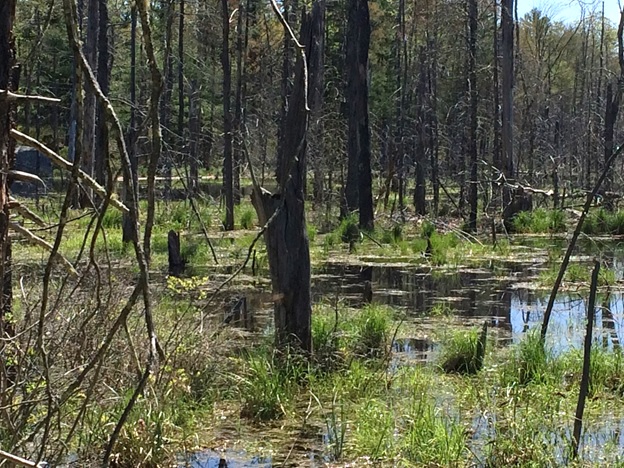 In March 2021, ASWM completed a multi-year project on Building State and Tribal Wetland Regulatory Capacity. This webinar series will provide useful findings, state and tribal lessons learned and useful tools and techniques that can be used to help wetland programs increase effectiveness, efficiency, transparency and predictability in regulatory activities.
In March 2021, ASWM completed a multi-year project on Building State and Tribal Wetland Regulatory Capacity. This webinar series will provide useful findings, state and tribal lessons learned and useful tools and techniques that can be used to help wetland programs increase effectiveness, efficiency, transparency and predictability in regulatory activities.
For more information and/or to join our email list for notices about upcoming events, please contact Laura Burchill at laura@nawm.org or (207) 892-3399.
List of Wetland Regulatory Capacity Building Webinar Recordings Here
Please click on a year below to view past webinars.
Please note, this was an ASWM Members’ Webinar that we have made available to the public.
The Navigable Waters Protection Rule: Highlights & Initial Take-Aways
Held Wednesday, March 25, 2020 - 12:00pm-2:00pm Eastern
INTRODUCTION
- Brenda Zollitsch, Senior Policy Analyst, Association of State Wetland Managers [POWERPOINT PRESENTATION]
PANELISTS
- Royal Gardner, Professor of Law and Director of the Institute for Biodiversity Law and Policy, Stetson University College of Law [POWERPOINT PRESENTATION]
- Mark Patrick McGuire, Association of Clean Water Administrators [POWERPOINT PRESENTATION]
- Ken Norton, National Tribal Water Council [POWERPOINT PRESENTATION]
- Brenda Zollitsch, PhD, Senior Policy Analyst, National Association of Wetland Managers [POWERPOINT PRESENTATION]
BIOS
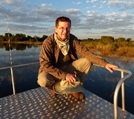 Royal C. Gardner is Professor of Law and Director of the Institute for Biodiversity Law and Policy at Stetson University College of Law. He is an internationally recognized expert in wetland law and policy. Recent projects include serving as the Chair of the Scientific and Technical Review Panel of the Ramsar Convention on Wetlands, testifying before a World Bank arbitration panel, advising the Government of Oman regarding wetland policy, and coauthoring amicus briefs on behalf of environmental scientists. In WOTUS-related litigation, he has filed amicus briefs in the U.S. Court of Appeals for the Sixth Circuit, and in the U.S. District Courts for the District of North Dakota and the Southern District of New York.
Royal C. Gardner is Professor of Law and Director of the Institute for Biodiversity Law and Policy at Stetson University College of Law. He is an internationally recognized expert in wetland law and policy. Recent projects include serving as the Chair of the Scientific and Technical Review Panel of the Ramsar Convention on Wetlands, testifying before a World Bank arbitration panel, advising the Government of Oman regarding wetland policy, and coauthoring amicus briefs on behalf of environmental scientists. In WOTUS-related litigation, he has filed amicus briefs in the U.S. Court of Appeals for the Sixth Circuit, and in the U.S. District Courts for the District of North Dakota and the Southern District of New York.
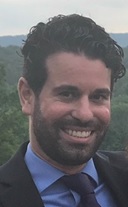 Mark Patrick McGuire joined ACWA in January 2016 as an Environmental Program Manager. He manages Association work in the following subject areas: Nutrients policy, legal affairs, NPDES permitting, compliance, and enforcement, pretreatment, and water quality trading. Patrick holds a J.D. from the Catholic University of America, Columbus School of Law and a B.S. in History from Northeastern University. He is an active member of the Rhode Island and Massachusetts bars.
Mark Patrick McGuire joined ACWA in January 2016 as an Environmental Program Manager. He manages Association work in the following subject areas: Nutrients policy, legal affairs, NPDES permitting, compliance, and enforcement, pretreatment, and water quality trading. Patrick holds a J.D. from the Catholic University of America, Columbus School of Law and a B.S. in History from Northeastern University. He is an active member of the Rhode Island and Massachusetts bars.
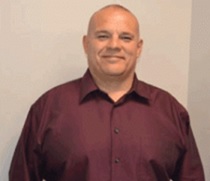 Ken Norton, Chair of the National Tribal Water Council, is an enrolled member of the Hoopa Valley Tribe, and serves as the Director of the Hoopa Valley Tribal Environmental Protection Agency (TEPA). Ken has expertise in water quality and the development of water quality standards. He is a fisheries expert understanding the water quality needs of healthy salmon and other river life, and is experienced in watershed restoration. As TEPA Director, Ken oversees tribal water programs and tribal environmental programs, such as superfund, brownfields, air, pesticides, lead and solid waste. In prior years (2004 and 2009), Ken served as the Vice-Chair of the National Tribal Operations Committee (NTOC) and as the NTOC Tribal Caucus lead for water issues.
Ken Norton, Chair of the National Tribal Water Council, is an enrolled member of the Hoopa Valley Tribe, and serves as the Director of the Hoopa Valley Tribal Environmental Protection Agency (TEPA). Ken has expertise in water quality and the development of water quality standards. He is a fisheries expert understanding the water quality needs of healthy salmon and other river life, and is experienced in watershed restoration. As TEPA Director, Ken oversees tribal water programs and tribal environmental programs, such as superfund, brownfields, air, pesticides, lead and solid waste. In prior years (2004 and 2009), Ken served as the Vice-Chair of the National Tribal Operations Committee (NTOC) and as the NTOC Tribal Caucus lead for water issues.
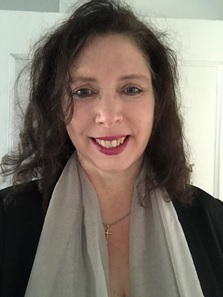 Brenda Zollitsch is Senior Policy Analyst for the Association of State Wetland Managers. Brenda leads national policy analysis and research projects on a wide range of wetland issues and currently leads two national EPA Wetland Program Development Grant projects, one on state and tribal assumption and the other on building regulatory capacity in state and tribal wetland programs. She also leads analysis on proposed regulatory changes to both Clean Water Act Sections 401 and the Waters of the U.S. Brenda received her PhD in Public Policy from the University of Southern Maine’s Muskie School of Public Service in 2012.
Brenda Zollitsch is Senior Policy Analyst for the Association of State Wetland Managers. Brenda leads national policy analysis and research projects on a wide range of wetland issues and currently leads two national EPA Wetland Program Development Grant projects, one on state and tribal assumption and the other on building regulatory capacity in state and tribal wetland programs. She also leads analysis on proposed regulatory changes to both Clean Water Act Sections 401 and the Waters of the U.S. Brenda received her PhD in Public Policy from the University of Southern Maine’s Muskie School of Public Service in 2012.

View Past Clean Water Act Webinars Here
| 2019 | 2018 | 2017 | 2015 | ||||||
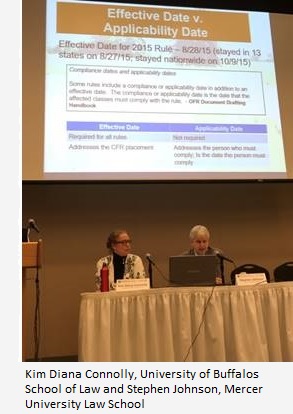 In the Courts - What's next for Waters of the United States Rule?
In the Courts - What's next for Waters of the United States Rule?
Wednesday, April 11, 2018
Presented at the Association of State Wetland Managers 2018 Annual State/Tribal/Federal Coordination Meeting
INTRODUCTION
Jeanne Christie, Association of State Wetland Managers
PRESENTERS
- Kim Diana Connolly, University at Buffalo School of Law
- Steve Johnson, Mercer University School of Law
BIOS
Kim Diana Connolly has focused a large part of her academic career on laws and policies that regulate and protect the planet and its inhabitants. She serves as a Professor of Law, and the Vice Dean for Advocacy and Experiential Learning for the University at Buffalo School of Law, where she directs both the Advocacy Institute and the Clinical Legal Education Program. She teaches environmental law courses, including the Environmental Advocacy Clinic. She also studies, writes and speaks about environmental and animal law policies, creatively examining and sharing ideas as to how to move toward a sustainable future. Professor Connolly’s commitment to environmental justice began before she attended law school, when she ran a non-profit working to bring social justice to those facing a lack of access to clean water and sanitary wastewater removal in North Carolina. After earning her law degree, she has advocated in multiple arenas, including in judicial settings, before federal, state and local legislative bodies, with federal, international, state, and local administrative bodies, and beyond. When she joined academia, Professor Connolly began exploring environmental and related policies. She has written both traditional and non-traditional works, and presented at numerous conferences around the world. Professor Connolly’s work has been used by policy-makers as well as cited by scholars. Prior to her teaching career, she practiced law with a number of Washington, D.C., law firms, including Beveridge and Diamond and Hunton & Williams. She received her J.D., magna cum laude, from Georgetown University Law Center and her LL.M. with highest honors from George Washington University Law School. Professor Connolly did her undergraduate work in chemistry at the University of North Carolina at Chapel Hill where she was a Morehead Scholar, and served as a VISTA volunteer between college and law school. She also received a certification in Non-Profit Management from Duke University.
Stephen M. Johnson is a Professor of Law at Mercer University Law School in Macon, Georgia. He received his J.D. from Villanova University School of Law and an LL.M. in environmental law from the George Washington University Law School. Prior to teaching, he served as an attorney for the Bureau of Regulatory Counsel in the Pennsylvania Department of Environmental Resources (now DEP) and as a trial attorney for the U.S. Department of Justice, Environment and Natural Resources Division, Environmental Defense Section, where he worked on wetlands litigation and other environmental litigation.
He joined the Mercer faculty in 1993 and served as the Associate Dean for Academic Affairs from 2002-2012. He specializes in Environmental Law, Administrative Law and Statutory Law. In addition to authoring numerous articles on environmental law and administrative law, he has written a book on Wetlands Law, published by CALI’s eLangdell Press, and co-edited an American Bar Association book on Wetlands Law.
![]()
What's next for Waters of the U.S. (WOTUS)?
Friday, February 9, 2018 - 10:30 a.m. ET
INTRODUCTION
Jeanne Christie, Association of State Wetland Managers [PowerPoint Presentation] PRESENTERS
PRESENTERS
- Royal Gardner, Stetson University College of Law [PowerPoint Presentation]
- Stephen Samuels, Retired from the U.S. Department of Justice [PowerPoint Presentation]
ABSTRACT
On January 22, 2018, the Supreme Court held unanimously that challenges to EPA’s and the Corps of Engineers’ promulgation of the Clean Water Rule in 2015, which defined the term “waters of the United States” in the Clean Water Act, may be brought only in the district courts. What does this decision mean for the stay of the Clean Water Rule that was issued by the Sixth Circuit Court of Appeals shortly after the new rule took effect? And does it even matter now that the executive branch has announced its intention to rescind the Clean Water Rule and replace it with a definition of WOTUS that will narrow the reach of the Act? Two experts on WOTUS will explore these questions, and yours, in a webinar on Friday, February 9, 2018 at 10:30 AM EST.
BIOS
Royal C. Gardner is Professor of Law and Director of the Institute for Biodiversity Law and Policy at Stetson University College of Law. He is an internationally recognized expert in wetland law and policy. Recent projects include advising the Government of Oman regarding wetland policy, coauthoring a U.S. Supreme Court amicus brief on behalf of environmental scientists, and creating an interdisciplinary course that facilitates discourse among experienced scientists, policymakers, and students.
His research and scholarship focus on U.S. and international wetland legal and policy issues, with an emphasis on biodiversity offsets. He has lectured in Africa, Asia, Europe, and North and South America. In 2006, he won the National Wetlands Award for Education and Outreach. In 1999–2001, Professor Gardner was appointed to the National Research Council’s Committee on Mitigating Wetland Losses.
An executive editor of the Boston College Law Review and a member of the Order of the Coif, he graduated magna cum laude from Boston College Law School. He then clerked for Chief Judge Francis J. Boyle of the United States District Court for the District of Rhode Island. From 1989 to 1993, he served in the Army General Counsel’s office as the Department of the Army’s principal wetland attorney, advising the assistant secretary of the Army (civil works) on legal and policy issues related to the Corps of Engineers’ administration of the Clean Water Act section 404 program. At Stetson, Professor Gardner has served as director of graduate and international programs, associate dean, vice dean, and interim dean.
Stephen Samuels, now retired, was previously Assistant Chief of the Environmental Defense Section of the Environment & Natural Resources Division of the U.S. Department of Justice. In that capacity, Mr. Samuels supervised a staff of 15 attorneys handling federal district court litigation involving all the major environmental pollution statutes. Mr. Samuels has 31 years of experience enforcing and defending the Clean Water Act Section 404 regulatory program. During that time, he helped lead the federal government’s litigation responses to the Supreme Court's decisions in SWANCC, Rapanos, Sackett and Hawkes. Until his retirement in January 2017, Mr. Samuels headed the DOJ litigation team that defended challenges to the Clean Water Rule. Mr. Samuels is a frequent speaker on Clean Water Act jurisdiction at conferences around the country. Mr. Samuels previously was an attorney with the U.S. Department of Energy and with the law firm of Breed, Abbott & Morgan. Mr. Samuels earned his J.D. in 1977 from Stanford Law School and his B.A. in 1974 from Tulane University.
![]()
View Past Clean Water Act Webinars Here
| 2020 | 2019 | 2017 | 2015 | ||||||
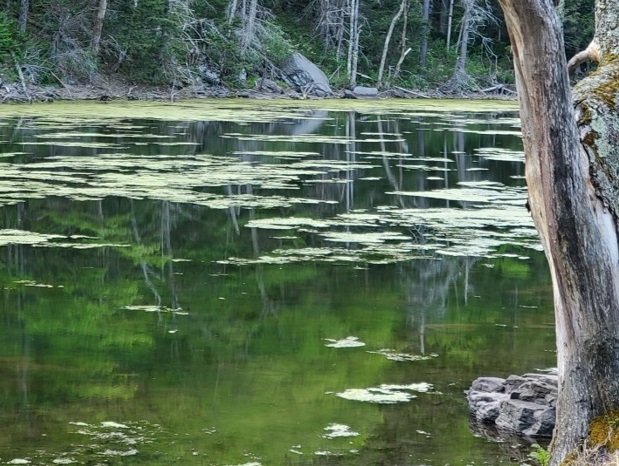 The federal Clean Water Act (CWA) is the main piece of federal legislation that protects the Nation's waters. Within the CWA, there are a number of sections that specifically address protection or regulation of wetlands. As such, NAWM closely follows all proposed and final CWA rules pertaining to wetlands and uses this webinar series as a vehicle to share timely information regarding any proposed regulatory changes and how they might impact state and tribal wetland programs.
The federal Clean Water Act (CWA) is the main piece of federal legislation that protects the Nation's waters. Within the CWA, there are a number of sections that specifically address protection or regulation of wetlands. As such, NAWM closely follows all proposed and final CWA rules pertaining to wetlands and uses this webinar series as a vehicle to share timely information regarding any proposed regulatory changes and how they might impact state and tribal wetland programs.
For more information and/or to join our email list for notices about upcoming events, please contact Laura Burchill at laura@nawm.org or (207)892-3399.
If you haven’t used Teams before or you just need a refresher, please view our guide prior to the webinar here.
View Past Clean Water Act Webinars Here
View a List of Past Clean Water Act Webinar Recordings Here
Please check back for future Clean Water Act Webinars. Thank you.
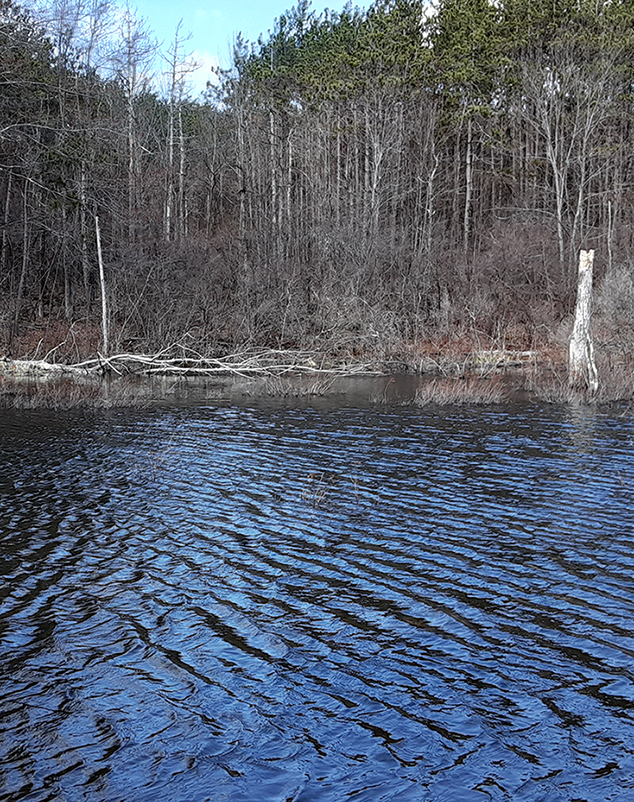 The federal Clean Water Act (CWA) is the main piece of federal legislation that protects the Nation's waters. Within the CWA, there are a number of sections that specifically address protection or regulation of wetlands. As such, NAWM closely follows all proposed and final CWA rules pertaining to wetlands and uses this webinar series as a vehicle to share timely information regarding any proposed regulatory changes and how they might impact state and tribal wetland programs.
The federal Clean Water Act (CWA) is the main piece of federal legislation that protects the Nation's waters. Within the CWA, there are a number of sections that specifically address protection or regulation of wetlands. As such, NAWM closely follows all proposed and final CWA rules pertaining to wetlands and uses this webinar series as a vehicle to share timely information regarding any proposed regulatory changes and how they might impact state and tribal wetland programs.
For more information and/or to join our email list for notices about upcoming events, please contact Laura Burchill at laura@nawm.org or (207) 892-3399.
View a List of Clean Water Act Webinar Recordings Here
Please click on a year below to view past webinars.
Underwater: Rising Seas, Chronic Floods and the Implications for US Coastal Real Estate
Held Wednesday, October 3, 2018 at 3:00-4:30 pm Eastern
INTRODUCTION
Brenda Zollitsch, Policy Analyst, Association of State of Wetland Managers [PRESEANTATION PDF]
PRESENTERS
- Kristina Dahl, Union of Concerned Scientists [PRESENTATAION PDF]
- Shana Udvardy, Union of Concerned Scientists [PRESENTATION PDF]
ABSTRACT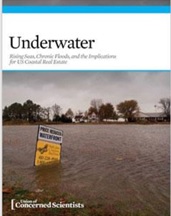
Rising sea levels are putting hundreds of US coastal communities at risk of chronic flooding and growing land and property loss, in many cases within 15 to 20 years. Using data from real estate company Zillow and our own peer-reviewed methodology for estimating flood risk, the Union of Concerned Scientists released a new analysis that identifies the number of coastal properties at risk of chronic inundation, the present-day value of these properties at the zip code level, and their current contribution to the property tax base. Join the report authors to learn about the significant implications for local economies, governments, communities and the financial sector. They will provide suggestions for changes to policies and market incentives to help mount a robust nationwide response to this immediate and growing problem. There will be time for questions after the presentation. You can read the report and view maps here.
BIOS
 Kristina Dahl is a senior climate scientist for the Climate & Energy program at the Union of Concerned Scientists. Dr. Dahl designs, executes, and communicates scientific analyses that make climate change more tangible to the general public and policy makers. Dr. Dahl earned a Ph.D. in paleoclimate from the MIT/Woods Hole Oceanographic Institution Joint Program, and a BA in Earth sciences from Boston University.
Kristina Dahl is a senior climate scientist for the Climate & Energy program at the Union of Concerned Scientists. Dr. Dahl designs, executes, and communicates scientific analyses that make climate change more tangible to the general public and policy makers. Dr. Dahl earned a Ph.D. in paleoclimate from the MIT/Woods Hole Oceanographic Institution Joint Program, and a BA in Earth sciences from Boston University.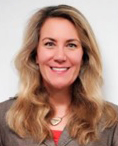 Shana Udvardy is a climate resilience analyst with the Climate & Energy program at the Union of Concerned Scientists. She conducts research and policy analysis to help inform and build support to increase resilience to climate change impacts. Ms. Udvardy is a Certified Floodplain Manager, and holds a M.S. in Conservation Ecology and Sustainable Development from the University of Georgia’s Odum School of Ecology and a B.A. from Syracuse University’s Maxwell School.
Shana Udvardy is a climate resilience analyst with the Climate & Energy program at the Union of Concerned Scientists. She conducts research and policy analysis to help inform and build support to increase resilience to climate change impacts. Ms. Udvardy is a Certified Floodplain Manager, and holds a M.S. in Conservation Ecology and Sustainable Development from the University of Georgia’s Odum School of Ecology and a B.A. from Syracuse University’s Maxwell School.
Please click only once on each video recording to view in this window.
![]()
ASWM American Wetlands Month Webinar
Measuring the Economic Benefits and Cost Effectiveness of Coastal Wetlands and Ecosystems
Held Wednesday, May 30, 2018 at 3:00pm ET
SPONSORED BY:
- National Oceanic and Atmospheric Administration
- U.S. Fish and Wildlife Service
INTRODUCTION
- Marla Stelk, Association of State of Wetland Managers [PRESENTATION PDF]
PRESENTERS
- Michael Beck, The Nature Conservancy and University of California, Santa Cruz [PRESENTATION PDF]
- Siddharth Narayan, University of California, Santa Cruz [PRESENTATION PDF]
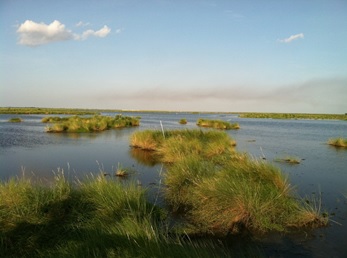 ABSTRACT
ABSTRACT
ASWM will be wrapping up our celebration of American Wetlands Month with a fascinating webinar discussing two report’s findings that show how investments in nature-based infrastructure can meet multiple objectives for environmental restoration, adaptation and flood risk reduction as well as result in millions of dollars in savings from storm damages.
In 2016, the release of the report “Coastal Wetlands and Flood Damage Reduction: Using Risk Industry-based Models to Assess Natural Defenses in the Northeastern USA” gained international attention. In the report the authors quantified the economic benefits of coastal wetlands in reducing property damage from storms and flooding in the northeastern United States. Using risk industry models, they estimated that coastal wetlands saved more than US$ 625 million in avoided flood damages from Hurricane Sandy across the northeastern USA. Just this spring, a second report was released entitled “Comparing the cost effectiveness of nature-based and coastal adaptation: A case study from the Gulf Coast of the United States.” This report also shows that investments in nature-based adaptation could meet multiple objectives for environmental restoration, adaptation and flood risk reduction. In this presentation, Michael Beck and Siddharth Narayan will share their research, methods and findings from these two studies.
BIOS
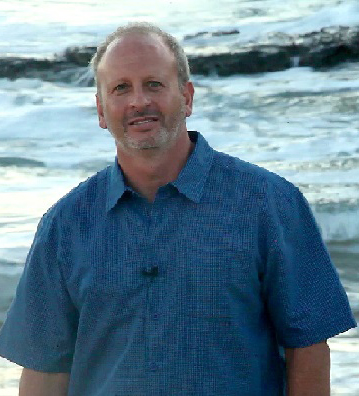 Michael Beck is the Lead Marine Scientist at TNC and adjunct Professor in Ocean Sciences at the University of California Santa Cruz. Mike focuses on building coastal resilience in the interface between risk reduction and conservation. His approach is multi-disciplinary across ecology, engineering and economics. Mike has authored more than sixty peer-reviewed publications. His work covers topics from the role of coral reefs in reducing risks from storms to the effects of people on extinctions of Pleistocene mammals. He has also published numerous popular articles including Op-eds in the NY Times, Miami Herald, Huffington Post and the Caribbean Journal. He was a Fulbright Fellow at the University of Sydney and in 2012 Mike was also selected as a Pew Marine Conservation Fellow.
Michael Beck is the Lead Marine Scientist at TNC and adjunct Professor in Ocean Sciences at the University of California Santa Cruz. Mike focuses on building coastal resilience in the interface between risk reduction and conservation. His approach is multi-disciplinary across ecology, engineering and economics. Mike has authored more than sixty peer-reviewed publications. His work covers topics from the role of coral reefs in reducing risks from storms to the effects of people on extinctions of Pleistocene mammals. He has also published numerous popular articles including Op-eds in the NY Times, Miami Herald, Huffington Post and the Caribbean Journal. He was a Fulbright Fellow at the University of Sydney and in 2012 Mike was also selected as a Pew Marine Conservation Fellow.
 Siddharth Narayan (Sid) is a Research Scientist in Coastal Adaptation and Nature-based Solutions. A civil and coastal engineer, hailing from Chennai in southern India, he is based at the University of California Santa Cruz and works with Michael Beck, lead marine scientist at The Nature Conservancy. Sid's research interests focus on modelling interactions between natural and human coastal systems, to help develop sustainable measures for coastal adaptation. At present, he works closely with insurance risk modelers, ecologists and engineers to assess the role and value of wetlands for reducing flood risk and damages to people and property.
Siddharth Narayan (Sid) is a Research Scientist in Coastal Adaptation and Nature-based Solutions. A civil and coastal engineer, hailing from Chennai in southern India, he is based at the University of California Santa Cruz and works with Michael Beck, lead marine scientist at The Nature Conservancy. Sid's research interests focus on modelling interactions between natural and human coastal systems, to help develop sustainable measures for coastal adaptation. At present, he works closely with insurance risk modelers, ecologists and engineers to assess the role and value of wetlands for reducing flood risk and damages to people and property.
Please click only once on each video recording to view in this window.
![]()
Presented at the Association of State Wetland Managers 2018 Annual State/Tribal/Federal Coordination Meeting
Held Thursday, April 12, 2018
Exploring Opportunities for Integrated Mapping and Functional Assessment of Riverine and Coastal Floodplains and Wetlands
- Andy Robertson, Saint Mary’s University of Minnesota
Focusing Restoration Where it Matters Most
- Caroline Chan, Kentucky Division of Water
An Integration Approach to Revitalizing a Brownfield Site - Achieving Multiple Benefits through Collaboration - NVF-Yorklyn, Delaware
- John Cargill, Delaware Department of Natural Resources and Environmental Control
Mapping Wetland and Floodplain Functions in Vermont
- Mike Kline and Laura Lapierre, Vermont Department of Environmental Conservation [PRESENTATION PDF]
Migratory Bird Treaty – What’s Next?
- Kim Connolly, University at Buffalo School of Law [PRESENTATION PDF]
Assessing Stream Functions for Watershed Management in Oregon
- Dana Hicks, Oregon Department of State Lands [PRESENTATION PDF]
Please click only once on each video recording to view in this window.
![]()
What's next for Waters of the U.S. (WOTUS)?
Held Friday, February 9, 2018 - 10:30 a.m. ET
INTRODUCTION
- Jeanne Christie, Association of State of Wetland Managers[PRESENTATION PDF]
PRESENTERS
- Royal Gardner, Stetson University College of Law [PRESENTATION PDF]
- Stephen Samuels, Retired from the U.S. Department of Justice [PRFESENTATION PDF]
ABSTRACT
On January 22, 2018, the Supreme Court held unanimously that challenges to EPA’s and the Corps of Engineers’ promulgation of the Clean Water Rule in 2015, which defined the term “waters of the United States” in the Clean Water Act, may be brought only in the district courts. What does this decision mean for the stay of the Clean Water Rule that was issued by the Sixth Circuit Court of Appeals shortly after the new rule took effect? And does it even matter now that the executive branch has announced its intention to rescind the Clean Water Rule and replace it with a definition of WOTUS that will narrow the reach of the Act? Two experts on WOTUS will explore these questions, and yours, in a webinar on Friday, February 9, 2018 at 10:30 AM EST.
BIOS
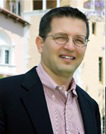 Royal C. Gardner is Professor of Law and Director of the Institute for Biodiversity Law and Policy at Stetson University College of Law. He is an internationally recognized expert in wetland law and policy. Recent projects include advising the Government of Oman regarding wetland policy, coauthoring a U.S. Supreme Court amicus brief on behalf of environmental scientists, and creating an interdisciplinary course that facilitates discourse among experienced scientists, policymakers, and students.
Royal C. Gardner is Professor of Law and Director of the Institute for Biodiversity Law and Policy at Stetson University College of Law. He is an internationally recognized expert in wetland law and policy. Recent projects include advising the Government of Oman regarding wetland policy, coauthoring a U.S. Supreme Court amicus brief on behalf of environmental scientists, and creating an interdisciplinary course that facilitates discourse among experienced scientists, policymakers, and students.
His research and scholarship focus on U.S. and international wetland legal and policy issues, with an emphasis on biodiversity offsets. He has lectured in Africa, Asia, Europe, and North and South America. In 2006, he won the National Wetlands Award for Education and Outreach. In 1999–2001, Professor Gardner was appointed to the National Research Council’s Committee on Mitigating Wetland Losses.
An Executive Editor of the Boston College Law Review and a member of the Order of the Coif, he graduated magna cum laude from Boston College Law School. He then clerked for Chief Judge Francis J. Boyle of the United States District Court for the District of Rhode Island. From 1989 to 1993, he served in the Army General Counsel’s office as the Department of the Army’s principal wetland attorney, advising the assistant secretary of the Army (civil works) on legal and policy issues related to the Corps of Engineers’ administration of the Clean Water Act section 404 program. At Stetson, Professor Gardner has served as director of graduate and international programs, associate dean, vice dean, and interim dean.
 Stephen Samuels, now retired, was previously Assistant Chief of the Environmental Defense Section of the Environment & Natural Resources Division of the U.S. Department of Justice. In that capacity, Mr. Samuels supervised a staff of 15 attorneys handling federal district court litigation involving all the major environmental pollution statutes. Mr. Samuels has 31 years of experience enforcing and defending the Clean Water Act Section 404 regulatory program. During that time, he helped lead the federal government’s litigation responses to the Supreme Court's decisions in SWANCC, Rapanos, Sackett and Hawkes. Until his retirement in January 2017, Mr. Samuels headed the DOJ litigation team that defended challenges to the Clean Water Rule. Mr. Samuels is a frequent speaker on Clean Water Act jurisdiction at conferences around the country. Mr. Samuels previously was an attorney with the U.S. Department of Energy and with the law firm of Breed, Abbott & Morgan. Mr. Samuels earned his J.D. in 1977 from Stanford Law School and his B.A. in 1974 from Tulane University.
Stephen Samuels, now retired, was previously Assistant Chief of the Environmental Defense Section of the Environment & Natural Resources Division of the U.S. Department of Justice. In that capacity, Mr. Samuels supervised a staff of 15 attorneys handling federal district court litigation involving all the major environmental pollution statutes. Mr. Samuels has 31 years of experience enforcing and defending the Clean Water Act Section 404 regulatory program. During that time, he helped lead the federal government’s litigation responses to the Supreme Court's decisions in SWANCC, Rapanos, Sackett and Hawkes. Until his retirement in January 2017, Mr. Samuels headed the DOJ litigation team that defended challenges to the Clean Water Rule. Mr. Samuels is a frequent speaker on Clean Water Act jurisdiction at conferences around the country. Mr. Samuels previously was an attorney with the U.S. Department of Energy and with the law firm of Breed, Abbott & Morgan. Mr. Samuels earned his J.D. in 1977 from Stanford Law School and his B.A. in 1974 from Tulane University.
Please click only once on each video recording to view in this window.
![]()
PDF List of Past Hot Topics Webinar Recordings
View Upcoming Hot Topics Webinars
A Legal Analysis of the Clean Water Act § 401 Proposed Rule
Held Friday, September 20, 2019 - 3:00-5:00 pm Eastern
INTRODUCTION
Marla Stelk, Executive Director, Association of State Wetland Managers [POWERPOINT PRESENTATION]
PRESENTERS
- Royal C. Gardner, Professor of Law and Director of the Institute for Biodiversity Law and Policy, Stetson University College of Law [POWERPOINT PRESENTATION]
- Mark A. Ryan, Principal, Ryan & Kuehler PLLC [POWERPOINT PRESENTATION]
- James M. McElfish, Jr., Senior Attorney, Environmental Law Institute [POWERPOINT PRESENTATION]
ABSTRACTS
On Thursday, August 22, 2019, the U.S. Environmental Protection Agency’s (EPA) proposed rule for changes to Clean Water Act (CWA) Section 401 was published in the Federal Register. The EPA has only provided a 60-day public comment period - comments are due on or before Monday, October 21, 2019 – however, EPA has requested feedback on over 130 questions. CWA § 401 is a direct grant of authority to states (and tribes that have been approved for “treatment as a state” status) to review for compliance with appropriate federal, state, and tribal water quality requirements any proposed activity that requires a federal license or permit and may result in a discharge to waters of the United States. The proposed rule has significant legal and policy implications for states’ rights to protect their water quality within their own boundaries. To assist states, tribes and others in understanding the potential legal concerns surrounding the proposed rule, ASWM has invited three of the nation’s top Clean Water Act attorneys to provide a history of significant court cases regarding § 401, its use by states and tribes, and a legal analysis of the proposed rule and potential impacts.
Royal C. Gardner
Gardner provided a history of state water quality certification provisions, beginning with the Water Quality Improvement Act of 1970. He discussed the key U.S. Supreme Court cases that interpret Clean Water Act Section 401 (PUD No. 1 of Jefferson County v. Washington Department of Ecology and S.D. Warren Co. v. Maine Board of Environmental Protection), as well as other cases mentioned in the proposed rulemaking. He will also highlight significant aspects of the proposed rule: time limitations on state certification decisions; restrictions on the scope of what states may consider in the certification process; and federal agency review (and possible rejection) of state certification decisions.
Mark A. Ryan
Mark discussed the administrative process EPA is required to follow to promulgate a final rule, how the likely litigation will play out and the possibility of Congress invoking the Congressional Review Act. Mark also discussed how this effort fits into other CWA reform efforts by the Trump administration.
James M. McElfish, Jr.
James discussed the reliance by many states on 401 as a basis for wetlands regulatory programs; the various types of conditions that states have applied to 401 certifications to protect water quality in the context of federal licenses and permits and what limitations the proposed rule would place on such conditions; and the potential impacts of the proposed rule on enforceability of state conditions.
BIOS
 Royal C. Gardner is Professor of Law and Director of the Institute for Biodiversity Law and Policy at Stetson University College of Law. He is an internationally recognized expert in wetland law and policy. Recent projects include serving as the Chair of the Scientific and Technical Review Panel of the Ramsar Convention on Wetlands, testifying before a World Bank arbitration panel, advising the Government of Oman regarding wetland policy, and coauthoring amicus briefs on behalf of environmental scientists. In WOTUS-related litigation, he has filed amicus briefs in the U.S. Court of Appeals for the Sixth Circuit, and in the U.S. District Courts for the District of North Dakota and the Southern District of New York.
Royal C. Gardner is Professor of Law and Director of the Institute for Biodiversity Law and Policy at Stetson University College of Law. He is an internationally recognized expert in wetland law and policy. Recent projects include serving as the Chair of the Scientific and Technical Review Panel of the Ramsar Convention on Wetlands, testifying before a World Bank arbitration panel, advising the Government of Oman regarding wetland policy, and coauthoring amicus briefs on behalf of environmental scientists. In WOTUS-related litigation, he has filed amicus briefs in the U.S. Court of Appeals for the Sixth Circuit, and in the U.S. District Courts for the District of North Dakota and the Southern District of New York.
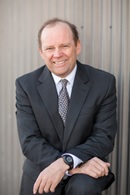 Mark Ryan is an Attorney with Ryan & Kuehler PLLC in Winthrop, Washington where he has a national and regional practice that focuses on Clean Water Act (CWA) counseling and litigation, water rights and land-use issues. Prior to Ryan & Kuehler, Mr. Ryan spent 24 years as an EPA trial attorney, where he was one of EPA's leading experts on the CWA. He has published and spoken extensively on the CWA, and he is the long-standing editor of the American Bar Association’s Clean Water Act Handbook. He received his B.S. in natural resources from the University of Michigan and his law degree from Indiana University School of Law (cum laude), where he was an editor of the Indiana Law Journal. Mr. Ryan's Clean Water Act Blog, where he provides summaries of recent developments under the CWA, can be viewed at ryankuehler.com. Mr. Ryan can be reached at mr@ryankuehler.com.
Mark Ryan is an Attorney with Ryan & Kuehler PLLC in Winthrop, Washington where he has a national and regional practice that focuses on Clean Water Act (CWA) counseling and litigation, water rights and land-use issues. Prior to Ryan & Kuehler, Mr. Ryan spent 24 years as an EPA trial attorney, where he was one of EPA's leading experts on the CWA. He has published and spoken extensively on the CWA, and he is the long-standing editor of the American Bar Association’s Clean Water Act Handbook. He received his B.S. in natural resources from the University of Michigan and his law degree from Indiana University School of Law (cum laude), where he was an editor of the Indiana Law Journal. Mr. Ryan's Clean Water Act Blog, where he provides summaries of recent developments under the CWA, can be viewed at ryankuehler.com. Mr. Ryan can be reached at mr@ryankuehler.com.
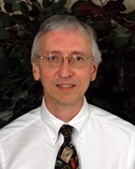 James M. McElfish, Jr. is a Senior Attorney, Director with the Environmental Law Institute Sustainable Use of Land Program. Jim McElfish’s research focuses on development choices and their links to land use, water resources, biological diversity, and infrastructure policy. ELI’s Sustainable Use of Land Program makes connections among laws, policies, taxes, investments, and land use decisions. His work includes research on coastal zone activities, renewable energy siting, enforcement, and conservation outcomes. McElfish served as representative of the natural environment on the American Planning Association’s multi-year Growing Smarter Legislative Guidebook Directorate. McElfish also leads ELI programs on water resources, examining how watersheds and resources can be evaluated, used, conserved, and restored. He is a nationally recognized authority on NEPA and a former litigator in private practice and with the Department of the Interior. McElfish has been an ELI Senior Attorney since 1986.
James M. McElfish, Jr. is a Senior Attorney, Director with the Environmental Law Institute Sustainable Use of Land Program. Jim McElfish’s research focuses on development choices and their links to land use, water resources, biological diversity, and infrastructure policy. ELI’s Sustainable Use of Land Program makes connections among laws, policies, taxes, investments, and land use decisions. His work includes research on coastal zone activities, renewable energy siting, enforcement, and conservation outcomes. McElfish served as representative of the natural environment on the American Planning Association’s multi-year Growing Smarter Legislative Guidebook Directorate. McElfish also leads ELI programs on water resources, examining how watersheds and resources can be evaluated, used, conserved, and restored. He is a nationally recognized authority on NEPA and a former litigator in private practice and with the Department of the Interior. McElfish has been an ELI Senior Attorney since 1986.
![]()
View Past Clean Water Act Webinars Here
| 2020 | 2018 | 2017 | 2015 | ||||||
Webinar: Legal Challenges to the Clean Water Rule: Which Court? What Questions? What Timeframe?
Thursday, November 19, 2015
Introduction: Jeanne Christie, Executive Director, Association of State Wetland Managers
On Thursday, November 19, 2015 the Association of State Wetland Managers (ASWM) hosted a webinar to assist participants in understanding the status of challenges to the Clean Water Rule in the courts and explore what might happen in the coming months. The webinar provided a general overview of pending legal challenges to the Clean Water Rule and the status of those challenges. Much of the presentation focused on the basis for the legal challenges and what the process is likely to be in the courts as the lawsuits move through the justice system. Presenters also discussed various bills and resolutions before Congress, as well as the possibility of a rider being attached to the expected Congressional omnibus spending bill.
Panelists were Roy Gardner, Professor of Law and Director, Institute for Biodiversity Law and Policy, Stetson University College of Law and Kim Diana Connolly, Professor, Director of Clinical Legal Education, Vice Dean for Legal Skills, SUNY Buffalo Law School. Both panelists have extensive experience in Clean Water Act law and policy issues.
A PDF of the PowerPoint presentation is available here.
![]()
Clean Water Rule Webinar: Understanding Legal Challenges and Next Steps for the Clean Water Rule
Wednesday, August 24, 2015
On Monday, August 24, 2015 the Association of State Wetland Managers (ASWM) hosted a webinar on “Understanding Legal Challenges and Next Steps for the Clean Water Rule” with presentations by Roy Gardner, Professor of Law and Director, Institute for Biodiversity Law and Policy and Kim Diana Connolly, Professor, Director of Clinical Legal Education, Vice Dean for Legal Skills, SUNY Buffalo Law School. It was recorded and the webinar can be viewed below.
A PDF of the PowerPoint presentation is available here.
![]()
Wednesday, June 17, 2015
![]()
On Wednesday, June 17 the Association of State Wetland Managers (ASWM) held a webinar “Understanding the Final Clean Water Rule and Changes to CWA Jurisdiction Included in Senate Bill 1140” with presentations by Roy Gardner, Professor of Law and Director, Institute for Biodiversity Law and Policy and Kim Diana Connolly, Professor, Director of Clinical Legal Education, Vice Dean for Legal Skills, SUNY Buffalo Law School. Topics covered during the webinar included: an overview of changes to CWA jurisdiction under the new rule, a discussion of how the changes reflect the Carabell/Rapanos and SWANCC Supreme Court decisions and an overview of Senate Bill 1140, "The Federal Water Quality Protection Act". It was recorded and the webinar can be viewed below.
A PDF of the PowerPoint presentation is available here.
![]()
View Past Clean Water Act Webinars Here
| 2020 | 2019 | 2018 | 2017 | ||||||
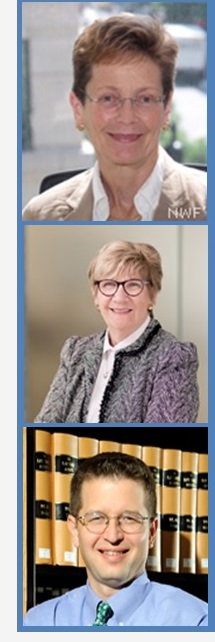 What's Next for Clean Water Act Jurisdiction
What's Next for Clean Water Act Jurisdiction
Tuesday, July 11, 2017 - 12:00 p.m.-2:00 p.m. Eastern
INTRODUCTION
Jeanne Christie, Executive Director, Association of State Wetland Managers [POWERPOINT PRESENTATION]
PRESENTERS
- Jan Goldman-Carter, National Wildlife Federation
- Virginia Albrecht, Hunton and Williams, LLP
- Royal C. Gardner, Stetson University, College of Law [POWERPOINT PRESENTATION]
The U.S. Environmental Protection Agency (EPA) and the Department of Army (Army) are carrying out a two-step process to revise Clean Water Act Jurisdiction. The first step is to repeal the Clean Water Rule regulation finalized by EPA and the Army in the spring of 2015 and replace it with the 1986 rule previously in place in conjunction with the Rapanos guidance. Essentially this step formally adopts the current status quo which remains in place because the Clean Water Rule is stayed by the Sixth Circuit Court pending action by the court. The next step following the repeal and replace rulemaking will be a new rule based in part on the Scalia Opinion in the Rapanos decision.
As states, tribes, and others review the proposed rule and think about the rulemaking that is planned to follow it, there are many issues to consider. ASWM has invited legal experts representing diverse perspectives to share their insights to help webinar participants to understand the current process, issues of importance, and potential outcomes as these rulemaking efforts are carried out and later challenged in the courts.
BIOS
Virginia S. Albrecht is Special Counsel for Hunton and Williams. Her practice focuses exclusively on environmental law and administrative law --- in particular, the Clean Water Act (CWA) wetlands program, the Endangered Species Act (ESA), the National Environmental Policy Act (NEPA) and other federal regulatory programs that affect the use of land. She has experience in permit negotiation, litigation of policy issues, lobbying Congress and the Administration, enforcement defense, and compliance counseling. Representative clients include development companies, agricultural and mining companies, state and local agencies, and trade associations. She has extensive experience with federal environmental agencies both in Washington and in district and regional offices. Virginia is a member of the assumable waters subcommittee which EPA established in 2015 to obtain advice on the scope of waters that can be assumed and Administered by states under section 404 of the clean water act. She is also an adjunct professor for the University of Miami School of Law Program in Real Property Development. She received her JD from Vanderbilt University Law School, was Articles Editor of the Vanderbilt Law Review in1981, and received her MA in Communications from the University of Pennsylvania in 1970 and her BS from the University of Wisconsin in 1964. She has bar admissions in the District of Columbia.
Jan Goldman-Carter is Director, Wetlands and Water Resources for the National Wildlife Federation. She manages the NWF campaign to restore Clean Water Act protections and works to strengthen wetland and watershed protections regionally and nationally. Jan has lectured and written extensively on Clean Water Act and wetlands laws and programs since 1987. She received the EPA-ELI National Wetlands Award in 1993. Jan served as a wetlands specialist with the U.S. Fish and Wildlife Service, the U.S. Environmental Protection Agency, and the U.S. Army Corps of Engineers. She grew up on the edge of the "River of Grass" - the Everglades - and enjoys canoeing, kayaking, birding and otherwise being in and on the water. She received her B.A. in Biology and Environmental Studies from Williams College, Massachusetts, her M.S. in Natural Resources from the University of Michigan School of Natural Resources, and her law degree from the University of Minnesota.
Royal C. Gardner is Professor of Law and Director of the Institute for Biodiversity Law and Policy at Stetson University College of Law. He is an internationally recognized expert in wetland law and policy. Recent projects include advising the Government of Oman regarding wetland policy, coauthoring a U.S. Supreme Court amicus brief on behalf of environmental scientists, and creating an interdisciplinary course that facilitates discourse among experienced scientists, policymakers, and students.
His research and scholarship focus on U.S. and international wetland legal and policy issues, with an emphasis on biodiversity offsets. He has lectured in Africa, Asia, Europe, and North and South America.
Professor Gardner is the current chair of the Scientific and Technical Review Panel (STRP) for the Ramsar Convention, an intergovernmental wetland treaty with 168 countries. He also served on the Ramsar STRP as North American representative (2006–2008) and invited expert (2009–2012). He was chair of the U.S. National Ramsar Committee (2005–2008) and participated in the Ramsar Convention Conferences of the Parties held in Spain (2002), Uganda (2005), Korea (2008), and Romania (2012). In 2006, he won the National Wetlands Award for Education and Outreach. In 1999–2001, Professor Gardner was appointed to the National Research Council’s Committee on Mitigating Wetland Losses.
An executive editor of the Boston College Law Review and a member of the Order of the Coif, he graduated magna cum laude from Boston College Law School. He then clerked for Chief Judge Francis J. Boyle of the United States District Court for the District of Rhode Island. From 1989 to 1993, he served in the Army General Counsel’s office as the Department of the Army’s principal wetland attorney, advising the assistant secretary of the Army (civil works) on legal and policy issues related to the Corps of Engineers’ administration of the Clean Water Act section 404 program. From 1993 until he joined the Stetson faculty in 1994, Professor Gardner worked for the Department of Defense, where he participated in negotiating international agreements with Russia, Ukraine, Kazakhstan, and Belarus to facilitate the dismantlement of the former Soviet Union’s nuclear weapons.
Since joining the Stetson faculty, Professor Gardner has twice received Stetson University’s Homer and Dolly Hand Award for Excellence in Faculty Scholarship and has been voted the Outstanding Professor by the Stetson student body. He has taught at Stetson’s summer programs in Spain, Germany, Argentina, and Estonia, and has been a visiting professor at the Universidad de Málaga (Spain) and Concordia International University-Estonia, where he received the Outstanding Instructor Award. At Stetson, Professor Gardner has served as director of graduate and international programs, associate dean, vice dean, and interim dean.
|
The presentations for Jan Goldman-Carter and Virginia Albrecht are not available for viewing. |
![]()
Recorded Webinar: 2017 Annual State/Tribal/Federal Coordination Meeting
What's Next for Clean Water Act Jurisdiction:
Maintaining - or Draining - the Swamps? The Future of the Clean Water Rule
Tuesday, April 11, 2017
INTRODUCTION
Jeanne Christie, Executive Director, Association of State Wetland Managers
ABSTRACT
In the spring of 2017 the US Environmental Protection Agency and the Army Corps of Engineers are implementing Executive Order 13778 on Restoring the Rule of Law, Federalism, and the Economic Growth by Reviewing the ”Waters of the United States” Rule which directs the federal agencies to rescind the current Clean Water Rule and replace it. This recorded webinar by Stephen Samuels, retired, formerly with Department of Justice, provides information about the status of the currently stayed Clean Water Rule and the case that has been accepted to be heard in 2018 before the Supreme Court, as well as a succinct overview of Supreme Court decisions addressing Clean Water Act jurisdiction in recent decades through the present day.
PRESENTER
- Stephen Samuels, Retired, formerly with Department of Justice [POWERPOINT PRESENTATION]
BIO
Now retired, Stephen Samuels was previously Assistant Chief of the Environmental Defense Section of the Environment & Natural Resources Division of the U.S. Department of Justice. In that capacity, Mr. Samuels supervised a staff of 15 attorneys handling federal district court litigation involving all the major environmental pollution statutes. Mr. Samuels has 31 years of experience enforcing and defending the Clean Water Act Section 404 regulatory program. During that time, he helped lead the federal government’s litigation responses to the Supreme Court's decisions in SWANCC, Rapanos, Sackett and Hawkes. Until his retirement in January 2017, Mr. Samuels headed the DOJ litigation team that defended challenges to the Clean Water Rule. Mr. Samuels is a frequent speaker on Clean Water Act jurisdiction at conferences around the country. Mr. Samuels previously was an attorney with the U.S. Department of Energy and with the law firm of Breed, Abbott & Morgan. Mr. Samuels earned his J.D. in 1977 from Stanford Law School and his B.A. in 1974 from Tulane University.
![]()
View Past Clean Water Act Webinars Here
| 2020 | 2019 | 2018 | 2015 | ||||||
Webinar 8: An Ecological Framework for Reviewing Compensatory Mitigation: Oversight and Compliance
Held Thursday, October 24, 2019 - 2:00pm – 4:30pm Eastern
INTRODUCTION
Marla Stelk, Executive Director, National Association of Wetland Managers [POWERPOINT PRESENTATION]
PRESENTERS
- Kristina Hall, U.S. Army Corps of Engineers [POWERPOINT PRESENTATION]
- Sarah Woodford, Virginia Department of Environmental Quality [POWERPOINT PRESENTATION]
- Ashely Zavagno, CA WRA, Inc. [POWERPOINT PRESENTATION]
ABSTRACTS
Kristina Hall
Oversight and compliance is an important component of compensatory mitigation. This presentation will discuss oversight and compliance from the perspective of a Corps Regulator as well as important “touch points” in mitigation plan review, approval, implementation, monitoring and long term management. Examples of effective adjustment of anticipated outcomes will be given and along with flexibility in the Regulatory’s oversight of the compensatory mitigation process.
Sarah Woodford
Oversight and compliance are essential components of any functional regulatory program. This presentation discusses oversight tools that are used in Virginia in the regulation of mitigation banks and in-lieu fee programs. In addition, through several case studies, the presentation will provide a state perspective of the communication and resolutions that developed when non-compliance or other issues were identified.
Ashley Zavagno
Oversight and compliance challenges in compensatory mitigation are different for project sponsors and consultants than for regulators. This presentation will explore challenges faced by project sponsors and consultants during the development, implementation, monitoring, and long-term management stages of mitigation projects and offer potential solutions and best management practices. Such challenges include implementing complex performance standards for multiple agencies, finding appropriate easement and endowment holders, disparity in endowment requirements across projects, coordinating decisions with multiple parties during implementation, and lack of collaboration between agencies and project proponents during project development.
BIOS
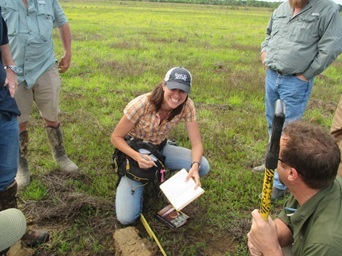 Kristi Hall, Professional Wetland Scientist, is currently the USACE Regulatory Headquarters Science Detailee. When not on detail assignment, she is a Senior Environmental Scientist with the Vicksburg District Regulatory Branch, Evaluation Section. At the District, Kristi primarily focuses on mitigation banking and standard permitting. Kristi has worked in the Regulatory field since 2003 and has been with the Vicksburg District since 2015. She obtained her bachelor’s degree in biochemistry from Virginia Tech and her master’s degree in fisheries and wildlife biology from Colorado State University. Kristi has worked in both the public and private sectors with the Mississippi Department of Transportation, USACE ERDC Environmental Lab, as well as several private consulting firms prior to working with USACE Regulatory. Kristi served as Acting Technical Services Branch Chief in the Nashville District in 2017 and was named the 2018 Vicksburg District Regulator of the Year. In her “free time” she can be found shuttling her two kids to their numerous athletic endeavors, and working with her husband to build their own home in Vicksburg.
Kristi Hall, Professional Wetland Scientist, is currently the USACE Regulatory Headquarters Science Detailee. When not on detail assignment, she is a Senior Environmental Scientist with the Vicksburg District Regulatory Branch, Evaluation Section. At the District, Kristi primarily focuses on mitigation banking and standard permitting. Kristi has worked in the Regulatory field since 2003 and has been with the Vicksburg District since 2015. She obtained her bachelor’s degree in biochemistry from Virginia Tech and her master’s degree in fisheries and wildlife biology from Colorado State University. Kristi has worked in both the public and private sectors with the Mississippi Department of Transportation, USACE ERDC Environmental Lab, as well as several private consulting firms prior to working with USACE Regulatory. Kristi served as Acting Technical Services Branch Chief in the Nashville District in 2017 and was named the 2018 Vicksburg District Regulator of the Year. In her “free time” she can be found shuttling her two kids to their numerous athletic endeavors, and working with her husband to build their own home in Vicksburg.
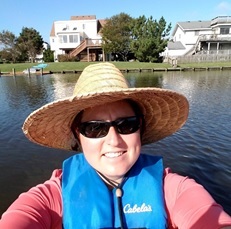 Sarah Woodford is the Compensatory Mitigation Specialist for the Virginia Department of Environmental Quality. She is the state chair of the Interagency Review Team for all non-tidal wetland and stream mitigation banks and in-lieu fee programs in the U.S. Army Corps of Engineers Norfolk District, and ensures that mitigation sponsors adhere to State Water Control Law and Virginia Water Protection Permit Program regulations. Sarah works closely with the Corps and the Virginia Marine Resources Commission IRT chairs, along with other member agencies of the IRT, to reach consensus on complex issues in compensatory mitigation. She also assists permit managers, mitigation sponsors, consultants, and the regulated public in understanding the mitigation process. Prior to DEQ, Sarah worked as an environmental consultant, where she focused on water quality monitoring and stream mitigation assessment, restoration design, and post-construction performance monitoring.
Sarah Woodford is the Compensatory Mitigation Specialist for the Virginia Department of Environmental Quality. She is the state chair of the Interagency Review Team for all non-tidal wetland and stream mitigation banks and in-lieu fee programs in the U.S. Army Corps of Engineers Norfolk District, and ensures that mitigation sponsors adhere to State Water Control Law and Virginia Water Protection Permit Program regulations. Sarah works closely with the Corps and the Virginia Marine Resources Commission IRT chairs, along with other member agencies of the IRT, to reach consensus on complex issues in compensatory mitigation. She also assists permit managers, mitigation sponsors, consultants, and the regulated public in understanding the mitigation process. Prior to DEQ, Sarah worked as an environmental consultant, where she focused on water quality monitoring and stream mitigation assessment, restoration design, and post-construction performance monitoring.
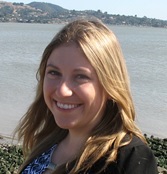 Ashley Zavagno is a Restoration Ecologist and Project Manager at WRA, Inc., a private environmental consulting firm based in the San Francisco Bay Area. She received her Bachelor of Science in Ecology and Evolution from U.C. Santa Barbara and her Master of Environmental Science and Management with a specialization in conservation planning from the Bren School of Environmental Science & Management. She is also a Certified Ecological Restoration Practitioner through the Society of Ecological Restoration and a Certified Ecologist through the Ecological Society of America. For the past several years, she has been overseeing the entitlement, permitting, implementation, monitoring, and long-term management of various mitigation banks and large-scale permittee-responsible mitigation projects throughout California. She has worked in various western landscapes including tidal wetlands, vernal pools, chaparral, coniferous forests, and oak woodlands, but her passion is rivers and salmonids.
Ashley Zavagno is a Restoration Ecologist and Project Manager at WRA, Inc., a private environmental consulting firm based in the San Francisco Bay Area. She received her Bachelor of Science in Ecology and Evolution from U.C. Santa Barbara and her Master of Environmental Science and Management with a specialization in conservation planning from the Bren School of Environmental Science & Management. She is also a Certified Ecological Restoration Practitioner through the Society of Ecological Restoration and a Certified Ecologist through the Ecological Society of America. For the past several years, she has been overseeing the entitlement, permitting, implementation, monitoring, and long-term management of various mitigation banks and large-scale permittee-responsible mitigation projects throughout California. She has worked in various western landscapes including tidal wetlands, vernal pools, chaparral, coniferous forests, and oak woodlands, but her passion is rivers and salmonids.
![]()
Webinar 7: An Ecological Framework for Compensatory Mitigation: Anticipating the Unexpected
Held Thursday, June 27, 2019 - 2:00pm – 4:30pm Eastern
![]()
INTRODUCTION
Marla Stelk, Executive Director, National Association of Wetland Managers [POWERPOINT PRESENTATION]
PRESENTERS
- W. Lee Daniels, Thomas B. Hutcheson Professor of Environmental Soil Science, Virginia Tech [POWERPOINT PRESENTATION]
- Shawn Chartrand, Postdoctoral Research Fellow, Vanderbilt University [POWERPOINT PRESENTATION]
- Krystel Bell, Regulatory Program Manager, U.S. Army Corps of Engineers [POWERPOINT PRESENTATION]
ABSTRACTS
W. Lee Daniels
Compaction of created wetland subsoils is often required for stability and to limit groundwater losses, but failure to provide a suitably loosened surface soil rooting media is a common problem, particularly for deeper rooted forested wetlands. Remedies include managing soil placement and tillage operations in concert with seasonal/moisture constraints. Near-surface compaction can also drastically alter hydroperiod regimes away from intended target references. Deeper excavations of creation sites in the mid-Atlantic USA also commonly encounter potential acid-sulfate materials, which if allowed to oxidize, generate very low soil+water pH and phytotoxic conditions. Preconstruction testing, recognition and avoidance are critical; remedial measures include heavy liming and organic amendments and/or keeping these materials saturated year-round.
Shawn Chartrand
Wetland and fluvial restoration projects commonly include post-construction plans which detail actions to address issues related to routine maintenance, adaptive management and remediation. These three direct actions have one common goal: set the constructed project on a trajectory to realize the restoration objectives. In this webinar they reviewed these three direct actions, with an emphasis on (1) how the direct actions are typically differentiated during the pre-construction planning and design phase, (2) post-construction conditions that are difficult to anticipate and therefore plan around, and (3) strategies that can be used to address significant uncertainties involving future landscape conditions. They reviewed the San Clemente Dam Removal project to help illustrate routine maintenance, adaptive management and remediation, within the context of an action that will reset the Carmel River corridor to a new physical state.
Krystel Bell
This presentation provided an understanding of the Corps' perspective in review, approval, and oversight of mitigation projects where adaptive management has been used as an important tool for planning and response to challenges and unforeseen changes to those projects.
BIOS
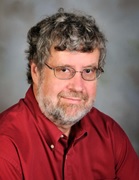 W. Lee Daniels is the Thomas B. Hutcheson Professor of Environmental Soil Science at Virginia Tech in Blacksburg, Virginia. He received his Ph.D. in Soil Science from VPI & SU in 1985. Dr. Daniels areas of specialization include stabilization and restoration of disturbed lands including areas disturbed by mining, road building, waste disposal, urbanization and erosion. In particular, he has focused his research and consulting experience in wetland impact mitigation, mine reclamation, and soil-waste management systems. His teaching programs at Virginia Tech focus on soil geomorphology and landscape analysis with particular emphasis on the relationships among surficial geology, hydrology, soil patterns and long term landscape evolution processes. Major awards include the Reclamation Researcher of the Year by the American Society for Surface Mining and Reclamation (ASMR) in 1993, USEPA’s National Biosolids Utilization Research Award in 2000 and the Lifetime Achievement in Research Award by ASMR in 2012.
W. Lee Daniels is the Thomas B. Hutcheson Professor of Environmental Soil Science at Virginia Tech in Blacksburg, Virginia. He received his Ph.D. in Soil Science from VPI & SU in 1985. Dr. Daniels areas of specialization include stabilization and restoration of disturbed lands including areas disturbed by mining, road building, waste disposal, urbanization and erosion. In particular, he has focused his research and consulting experience in wetland impact mitigation, mine reclamation, and soil-waste management systems. His teaching programs at Virginia Tech focus on soil geomorphology and landscape analysis with particular emphasis on the relationships among surficial geology, hydrology, soil patterns and long term landscape evolution processes. Major awards include the Reclamation Researcher of the Year by the American Society for Surface Mining and Reclamation (ASMR) in 1993, USEPA’s National Biosolids Utilization Research Award in 2000 and the Lifetime Achievement in Research Award by ASMR in 2012.
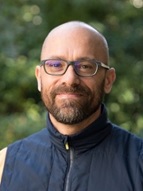 Shawn Chartrand completed his PhD at the University of British Columbia, and he is presently a postdoctoral research fellow at Vanderbilt University. Shawn is interested in how mountain streams form and evolve due to changes in local to watershed scale conditions. He uses laboratory experiments, develops theory, numerical models as well as field-based programs to pursue his interests, and develop strategies to assist practitioners working on applied problems. He has worked professionally for Balance Hydrologics since 2000, during which time he built and continues to lead a river and wetland restoration program. His notable applied experience includes 8 years of work on the San Clemente Dam Removal project, Carmel River, CA, and 15 years of work using climate change projections to plan water supply and instream flows for salmonids with the City of Santa Cruz and other regional Cities.
Shawn Chartrand completed his PhD at the University of British Columbia, and he is presently a postdoctoral research fellow at Vanderbilt University. Shawn is interested in how mountain streams form and evolve due to changes in local to watershed scale conditions. He uses laboratory experiments, develops theory, numerical models as well as field-based programs to pursue his interests, and develop strategies to assist practitioners working on applied problems. He has worked professionally for Balance Hydrologics since 2000, during which time he built and continues to lead a river and wetland restoration program. His notable applied experience includes 8 years of work on the San Clemente Dam Removal project, Carmel River, CA, and 15 years of work using climate change projections to plan water supply and instream flows for salmonids with the City of Santa Cruz and other regional Cities.
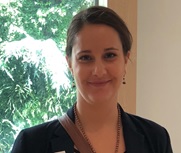 Krystel Bell recently became Regulatory Program Manager for the U.S. Army Corps of Engineers in Washington, D.C. Prior to this, she served as Mitigation Banking Specialist for the Sacramento District of the U.S. Army Corps of Engineers where she chaired the Interagency Review Team for multiple mitigation banks and in-lieu fee programs and worked on several of the District’s most complex regulatory actions. Prior to working for the Sacramento District, Ms. Bell worked as an environmental consultant and acted as a local representative for a County‐ level environmental program. Ms. Bell has extensive knowledge of how Regulatory decisions can affect developers, conservationists, and the general public. Her ability to communicate effectively with applicants, the public, federal, state and local agencies, and peers in the regulatory community has led to productive collaborative approaches in resolution of complex regulatory issues.
Krystel Bell recently became Regulatory Program Manager for the U.S. Army Corps of Engineers in Washington, D.C. Prior to this, she served as Mitigation Banking Specialist for the Sacramento District of the U.S. Army Corps of Engineers where she chaired the Interagency Review Team for multiple mitigation banks and in-lieu fee programs and worked on several of the District’s most complex regulatory actions. Prior to working for the Sacramento District, Ms. Bell worked as an environmental consultant and acted as a local representative for a County‐ level environmental program. Ms. Bell has extensive knowledge of how Regulatory decisions can affect developers, conservationists, and the general public. Her ability to communicate effectively with applicants, the public, federal, state and local agencies, and peers in the regulatory community has led to productive collaborative approaches in resolution of complex regulatory issues.
Webinar 6: An Ecological Framework for Reviewing Compensatory Mitigation: From Conceptual to Final Design
Held Wednesday, May 15, 2019 - 2:00 p.m. ET
INTRODUCTION
- Dawn Smith, National Association of Wetland Managers [POWERPOINT PRESENTATION]
PRESENTERS
- Matt Gause, Ecological Resources & Land Stewardship Director, Westervelt Ecological Services
[POWERPOINT PRESENTATION] -
Larry Urban, Wetland Mitigation Specialist, Montana Department of Transportation
[POWERPOINT PRESENTATION] -
Jeanne Richardson, Mitigation Subject Matter Expert, U.S. Army Corps of Engineers, Norfolk District Regulatory Branch
[POWERPOINT PRESENTATION]
ABSTRACTS
Matt Gause
Wetland Mitigation Concept to Final Design – Where Dreams and Reality Collide
The value of good data on both biotic and abiotic elements was emphasized in earlier webinars in this series. Good biotic and abiotic data also forms the foundation of the mitigation conceptual design; however, all the data necessary to finalize the design is often not yet available when a conceptual mitigation plan is first presented to regulatory agency staff. Using selected case studies this webinar identified general best practices for evaluating conceptual designs, illustrate how designs become more refined as new information comes to light and how to best remain engaged in the design process while working towards a final, implementable design.
Larry Urban
Three Phases of Design in Compensatory Mitigation Projects
Mitigation projects generally follow a three-phased approach to design prior to construction and implementation on the ground. These phases consist of Conceptual, Preliminary, and Final Design efforts. The Conceptual phase focuses on developing a series of Concepts / Options and then determining the feasibility of developing a mitigation project. These initial conceptual phases are important in provides an opportunity for cooperative agency review and input towards the selection of an approved “Preferred” concept. However, that “Preferred” concept may or may not move forward into more detailed design based upon cost/benefit analysis. Preliminary Design phase is where the details of a “Preferred” concept selected evolves thru a design process towards the development of construction plans. It involves agency review that may involve revisions to the details of the “Preferred” design as it moves forward towards construction. The Final Design is essentially that, to finalize the construction plans and specifications of a mitigation project for construction efforts. The Final Design involves agency review of the details of the project but does not involve major changes to the design that would delay construction or prevent implementation of the project. At this stage of a project, input is usually associated with the approval of permits and provide permit conditions for the project during construction and upon completion. This presentation provided some examples of the different phases for different types of projects that may be undertaken.
Jeanne Richardson
Mitigation Work Plans: A Regulators Perspective
Jeanne C. Richardson outlined the U.S. Army Corps of Engineers Norfolk District review and approval process for Mitigation Work Plans submitted by providers of wetland and stream compensatory mitigation projects from conceptual to final design. The presentation focused on the District regulators perspective of what information is necessary, when is that information necessary, and the level of detail required at each submittal milestone for review and approval. Jeanne walked through some specific examples that will serve to demonstrate some lessons learned and how the District’s requirements have changed over the years.
BIOS
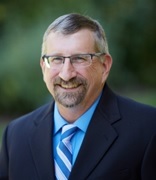 Matt Gause is the Ecological Resources & Land Stewardship Director at Westervelt Ecological Services and oversees Westervelt’s land stewardship and ecological resources on over 8,000 acres of restored wetlands and endangered species habitat on 18,000 acres of preserved properties in California, the Rocky Mountain region and southeastern United States. Mr Gause has over 25 years of experience with wetland restoration including the restoration of vernal pools, riparian forest, tidal marsh, and floodplain wetlands. He has also managed conserved lands for more than 15 threatened or endangered species on preserves throughout California.
Matt Gause is the Ecological Resources & Land Stewardship Director at Westervelt Ecological Services and oversees Westervelt’s land stewardship and ecological resources on over 8,000 acres of restored wetlands and endangered species habitat on 18,000 acres of preserved properties in California, the Rocky Mountain region and southeastern United States. Mr Gause has over 25 years of experience with wetland restoration including the restoration of vernal pools, riparian forest, tidal marsh, and floodplain wetlands. He has also managed conserved lands for more than 15 threatened or endangered species on preserves throughout California.
In addition, Mr. Gause provides site suitability analyses during the land acquisition process, including restoration suitability, threatened and endangered species, easement restriction analysis, and future land management cost estimation. Mr. Gause also develops and implements both baseline and long-term land management and monitoring strategies for mitigation and conservation landscapes.
Mr. Gause is a Certified Ecological Restoration Practitioner (CERP) and received a Bachelor of Science in Botany from the University of California at Davis.
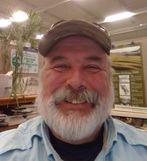 Lawrence J. “Larry” Urban is the wetland mitigation specialist for the Montana Department of Transportation with state-wide responsibilities based out of Helena, Montana. He has over 30 years of experience in wetland delineations, functional assessments, monitoring and mitigation site development for both the New Jersey and Montana Department of Transportations. He has been involved in the development of a comprehensive aquatic resource mitigation program to meet wetland and stream mitigation needs for transportation projects throughout the state of Montana that has created over 55 mitigation areas ranging in size from ½ to 300 acres in size. He developed MDT’s annual mitigation monitoring programs for the purposes of managing MDT aquatic resource mitigation sites on private, state and tribal lands to comply with federal, state and tribal permitting requirements.
Lawrence J. “Larry” Urban is the wetland mitigation specialist for the Montana Department of Transportation with state-wide responsibilities based out of Helena, Montana. He has over 30 years of experience in wetland delineations, functional assessments, monitoring and mitigation site development for both the New Jersey and Montana Department of Transportations. He has been involved in the development of a comprehensive aquatic resource mitigation program to meet wetland and stream mitigation needs for transportation projects throughout the state of Montana that has created over 55 mitigation areas ranging in size from ½ to 300 acres in size. He developed MDT’s annual mitigation monitoring programs for the purposes of managing MDT aquatic resource mitigation sites on private, state and tribal lands to comply with federal, state and tribal permitting requirements.
He has presented at National and Regional wetland mitigation conferences, and participates in annual continuing education, undergraduate and graduate courses as an instructor in wetland regulations, endangered plant species, functional assessments, mitigation monitoring, and aquatic resource restoration here in the state of Montana.
He was the recipient of the 2017 Montana Wetland Stewardship Award for his untiring efforts to protect, preserve and restore Montana’s wetland ecosystems. In his spare time, he is a fly-fishing guru working part-time at CrossCurrents Fly shop in Helena, Montana for his addiction to fly-fishing and fly-tying. He is also an avid birder that loves his day job at MDT as it affords him opportunities to see all kinds of birds and travel across the vast expanses of Montana.
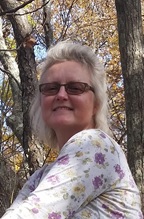
Jeanne C. Richardson is the Mitigation Subject Matter Expert for the U.S. Army Corps of Engineers, Norfolk District Regulatory Branch. She has worked for the Corps of Engineers for over 15 years. Jeanne oversees the District’s compensatory mitigation program where she develops and implements District level policy, standard operating procedures, templates, and technical guidance related to compensatory mitigation. Jeanne organizes training and provides assistance for District staff, 3rd party mitigation providers, and others specific to those policies, procedures, templates, and guidance. Jeanne manages the Virginia Aquatic Resources Trust Fund (VARTF) for the District. VARTF currently has currently has approximately 109 approved and pending projects. Jeanne provides the primary oversight of the District’s Interagency Review Team.
Webinar 5: An Ecological Framework for Reviewing Compensatory Mitigation: Coherent Plans – Goals, Objectives, Performance Standards, Outcomes and Monitoring
Held Thursday, April 18, 2019 - 2:00 p.m. ET

INTRODUCTION
Held Thursday, April 18, 2019 - 2:00 p.m. ET
INTRODUCTION
- Marla Stelk, Executive Director, National Association of Wetland Managers [POWERPOINT PRESENTATION]
PRESENTERS
- Eric Stein, Principal Scientist, Southern California Coastal Water Research Project [POWERPOINT PRESENTATION]
- Mick Micacchion, Professional Wetland Scientist and Restoration Ecologist, The Nature Conservancy [POWERPOINT PRESENTATION]
- Anthony Zemba, Environmental Specialist, Certified Ecologist/Soil Scientist, Fitzgerald & Halliday, Inc. [POWERPOINT PRESENTATION]
ABSTRACTS
Eric Stein
Performance standards are the roadmap to successful wetland restoration and mitigation. The likelihood of success increases dramatically when well-designed, ecologically relevant performance standards are used. This talk outlined key considerations for constructing effective performance standards that account for a broad set of physical, hydrological, and biological functions. We also covered practical considerations such alternative ways to approach “reference”, timing of when different standards should be met, and ways to develop standards that are resilient to changing conditions over time. Finally, we considered critical data management approaches that can improve accessibility of monitoring data necessary to evaluate standards over time.
Mick Micacchion
A condition-based approach to assessing functional replacement for wetland mitigation was developed using a reference wetland data set of natural wetlands that includes data from the major Ohio wetland types that span a gradient of human disturbance. From this data set wetland program tools were developed: 1) multimetric biological indices (IBIs) and hydrological and biogeochemical indicators; 2) a rapid (condition based) wetland assessment tool (ORAM); and 3) a wetland classification scheme based on landscape position and dominant vegetation. Ensuring functional replacement occurs in a several step process:
- First, as part of permit application, the HGM class and dominant plant community of the impacted wetland(s) are determined. This determination accounts for the ecosystem processes (functions) and ecological services (values) of different wetland types without the necessity of developing a comprehensive list of those functions and values;
- Second, the condition of the impacted wetland is assessed with the rapid condition tool (ORAM v. 5.0) or a wetland IBI providing a measure of "functional capacity";
- Third, the size of the wetland to be impacted is determined and appropriate mitigation ratios are applied;
- Fourth, any residual moderate to high functions or values the impacted wetland(s) may still be providing, despite moderate to severe degradation, are evaluated using checklist with a narrative discussion; and,
- Finally, requirements for mitigation are specified in the permit.
Fundamentally, the above approach is strongly data-driven, and it follows then that meaningful and adequate mitigation monitoring is absolutely necessary to determine whether the mitigation wetland has "succeeded" or "failed."
Anthony Zemba
Tiering may be an often overlooked but very useful approach to mitigation design and implementation. There are lots of information to be gained from the biology of early successional and volunteer species. Too often in the past, too much focus has been on getting plants in the ground and the subsequent survivorship metric of the planted specimens. Poor survivorship may be a result of poor microhabitat selection, poor choice of plants for site-specific conditions, or a result of overlooking other ecological factors and processes. Anthony provided an overview of some case studies of how some restoration sites here in the east have failed and why, and how tiering, more attention to site-specific attributes, and the consideration of other ecological factors in the mitigation planning process may help to improve success of a mitigation site.
BIO
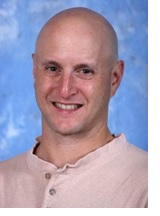 Eric D. Stein, D.Env. is a Principal Scientist at the Southern California Coastal Water Research Project (SCCWRP), where he is head of the Biology Department. Dr. Stein oversees a variety of projects related to in-stream and coastal water quality, bioassessment, hydromodification, watershed modeling, and assessment of wetlands and other aquatic resources. His research focuses on effects of human activities on the condition of aquatic ecosystems, and on developing tools to better assess and manage those effects. Dr. Stein has authored over 100 journal articles and technical reports and participates on numerous technical workgroups and committees related to water quality and wetland assessment and management. Prior to joining SCCWRP in 2002, Dr. Stein spent six years as a Senior Project Manager with the Regulatory Branch of the Los Angeles District Corps of Engineers, and four years with a private consulting firm.
Eric D. Stein, D.Env. is a Principal Scientist at the Southern California Coastal Water Research Project (SCCWRP), where he is head of the Biology Department. Dr. Stein oversees a variety of projects related to in-stream and coastal water quality, bioassessment, hydromodification, watershed modeling, and assessment of wetlands and other aquatic resources. His research focuses on effects of human activities on the condition of aquatic ecosystems, and on developing tools to better assess and manage those effects. Dr. Stein has authored over 100 journal articles and technical reports and participates on numerous technical workgroups and committees related to water quality and wetland assessment and management. Prior to joining SCCWRP in 2002, Dr. Stein spent six years as a Senior Project Manager with the Regulatory Branch of the Los Angeles District Corps of Engineers, and four years with a private consulting firm.
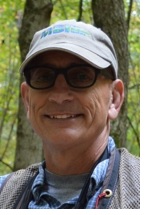 Mick Micacchion is a Professional Wetland Scientist and works as a restoration ecologist with The Nature Conservancy for the Ohio In-Lieu-Fee Compensatory Mitigation Program. He has a BS and MS in Wildlife Management, both from Ohio State University. Mick retired in 2011 from the Ohio Environmental Protection Agency (Ohio EPA) with 32 years of state service including 10 years with the Ohio Department of Natural Resources. While working for 20 years at Ohio EPA he was instrumental in the development of Ohio’s Wetland Water Quality Standards rules, wetland assessment tools, including the Ohio Rapid Assessment Method for Wetlands (ORAM), Vegetation Index of Biotic Integrity (VIBI), Amphibian Index of Biotic Integrity (AmphIBI), “Standardized Monitoring Protocols and Performance Standards for Ohio Mitigation Wetlands” and their integration into Ohio’s wetland program, which has worked as a model for the country.
Mick Micacchion is a Professional Wetland Scientist and works as a restoration ecologist with The Nature Conservancy for the Ohio In-Lieu-Fee Compensatory Mitigation Program. He has a BS and MS in Wildlife Management, both from Ohio State University. Mick retired in 2011 from the Ohio Environmental Protection Agency (Ohio EPA) with 32 years of state service including 10 years with the Ohio Department of Natural Resources. While working for 20 years at Ohio EPA he was instrumental in the development of Ohio’s Wetland Water Quality Standards rules, wetland assessment tools, including the Ohio Rapid Assessment Method for Wetlands (ORAM), Vegetation Index of Biotic Integrity (VIBI), Amphibian Index of Biotic Integrity (AmphIBI), “Standardized Monitoring Protocols and Performance Standards for Ohio Mitigation Wetlands” and their integration into Ohio’s wetland program, which has worked as a model for the country.
Mick also works for the non-profit Midwest Biodiversity Institute (MBI) where he has served as a wetland ecologist for the past seven years. Currently he instructs courses in Wetland Botany, Wetland Delineation, Ohio Amphibians, Ohio Wetland Assessment Methods, including ORAM, VIBI/VIBI-FQ, and AmphIBI, as well as several other courses at MBI. He has monitored the physical, chemical and biological features, including the soils, hydrology, chemistry, plant, amphibian and macroinvertebrate communities of hundreds of Ohio’s natural wetlands and trained hundreds of wetland professionals in the development and use of wetland monitoring and assessment methods, including ORAM, VIBI and AmphIBI. He has also monitored, assessed, and reported on the condition of hundreds of Ohio compensatory wetland mitigation projects and spent more than a decade on Ohio’s Interagency Review Team, where he was a major contributor to the “Guidelines on Wetland Mitigation Banking in Ohio.” Mick was a member of the Technical Advisory Group, which developed the methods used in the National Wetland Condition Assessment (NWCA), and lead crews and managed others for both the 2011 and 2016 NWCAs sampling wetlands in Ohio, Michigan, Wisconsin, Minnesota, Kentucky, Tennessee, and 10 other states.
He is the Vice President of the Ohio Wetlands Association and was a founder and has been active with the Ohio Vernal Pool Network since 2004.

Anthony Zemba is a certified ecologist, certified soil scientist, and certified hazardous materials manager. He has over 30 years of experience in natural resource management that includes aquatic toxicology, analytical chemistry, wetland assessment and delineation, ecological risk assessment, habitat assessments, conservation biology and ecological restoration. Mr. Zemba also serves as an adjunct professor at the University of New Haven Graduate Program in Environmental Science where he teaches a course in Environmental Impact Reports and Assessment. His love of nature blurs the line between work and play and on any given day, he may be found half-submerged in a swamp, scampering over boulder talus, or striding through forest and field alike with binoculars, insect net, hand lens, camera, or all of the above in tow searching for the next subject of study.
Webinar 4: An Ecological Framework for Reviewing Compensatory Mitigation Plans: Plan Review
- Marla Stelk, Executive Director, National Association of Wetland Managers [POWERPOINT PRESENTATION]
- Steve Martin, Environmental Scientist, Institute for Water Resources, U.S. Army Corps of Engineers [POWERPOINT PRESENTATION]
- Michelle Mattson, Environmental Scientist, Institute for Water Resources, U.S. Army Corps of Engineers [POWERPOINT PRESENTATION]
- Michael S. Rolband, P.E., P.W.S., P.W.D., Wetland Studies and Solutions, Inc. [POWERPOINT PRESENTATION]
- Karen Greene, National Oceanic and Atmospheric Administration, National Marine Fisheries Service (NOAA Fisheries) [POWERPOINT PRESENTATION]
ABSTRACT
Over the past three decades compensatory mitigation has become an important strategy for addressing the adverse environmental impacts that result from dredge and fill activities. Compensatory mitigation projects should be designed to replace lost ecological services at an alternative location by either the permitee or a third party in a mitigation bank or in-lieu fee program. Federal and State regulatory and resource agency staff routinely review these proposals to ensure that projects will achieve the desired outcomes. But what exactly should compensatory mitigation project reviewers consider in evaluating a proposal? The purpose of this webinar was to help plan reviewers evaluate whether a project as proposed is likely to achieve its objectives by examining some of the most important aspects of a project. Examples (including both successful and less than successful projects) from riverine, palustrine freshwater and coastal projects was provided to highlight the importance of site selection, water budgets, soils, monitoring, adaptation, and resiliency in evaluating a restoration plan.
BIOS
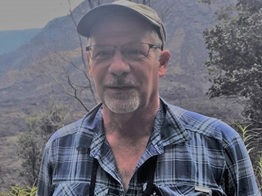 Steve Martin is an Environmental Scientist with the U.S. Army Corfps of Engineers’ Institute for Water Resources (IWR). His focus is on compensatory mitigation, including third party compensatory mitigation (mitigation banks and in-lieu fee programs). He provides technical and policy support to HQ USACE and Corps districts on compensatory mitigation. Much of his work has focused on education of Corps, federal, and state agencies in administrative and ecological aspects of compensatory mitigation. He also is the Corps’ national technical lead for RIBITS (Regulatory In-lieu fee and Bank Information Tracking System). Before coming to IWR he was a senior environmental scientist in the Norfolk District Regulatory Branch. He oversaw development and operations of a number of commercial mitigation banks.
Steve Martin is an Environmental Scientist with the U.S. Army Corfps of Engineers’ Institute for Water Resources (IWR). His focus is on compensatory mitigation, including third party compensatory mitigation (mitigation banks and in-lieu fee programs). He provides technical and policy support to HQ USACE and Corps districts on compensatory mitigation. Much of his work has focused on education of Corps, federal, and state agencies in administrative and ecological aspects of compensatory mitigation. He also is the Corps’ national technical lead for RIBITS (Regulatory In-lieu fee and Bank Information Tracking System). Before coming to IWR he was a senior environmental scientist in the Norfolk District Regulatory Branch. He oversaw development and operations of a number of commercial mitigation banks.

Michelle Mattson is a Stream and Wetland Ecologist with the U.S. Army Corfps of Engineers’ Institute for Water Resources (IWR) with over 20 years of professional experience as a consultant and regulator. Michelle is a compensatory mitigation subject matter expert (SME) and the IWR Regulatory Team budget manager. She supports national and regional training courses in compensatory mitigation and has spent her career in the field working with restoration teams to design, install and monitor restoration projects and programs. At the USACE, Michelle worked across agencies to develop the Advanced Permittee-Responsible Mitigation (APRM) Program for San Diego Association of Governments (SANDAG) and managed multiple banks and ILFs. As a consultant, she worked on two Special Area Managements Plans (SAMPs), the Otay River Watershed Management Plan, and several Mitigation Banks and ILF sites and multiple large-scale stream restoration projects in alignment with existing and planned USFWS habitat conservation plans (HCPs) and new SDRWQCB water quality requirements. She was a member of the California Wetland Monitoring Workgroup Level 2 (rapid assessment) Committee and was the first to use CRAM in evaluating impacts, alternatives analysis, and monitoring compensatory mitigation to improve decision making in LA District for several large alternative energy projects. Michelle remains a huge supporter of using functional and conditional assessments in regulatory and restoration practices including in informing the location and design of sites to short- and long-term monitoring performance and condition of sites.
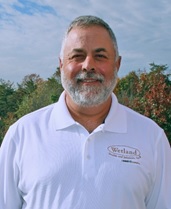 Michael (Mike) S. Rolband is the founder of Wetland Studies and Solutions, Inc. (WSSI), a 175+ person natural and cultural resources consulting firm headquartered in Gainesville, Virginia, and a subsidiary of The Davey Tree Expert Company. Mike founded WSSI in 1991 and pioneered its growth and expansion from the one-person wetlands consulting firm, to the multi-discipline natural and cultural resource consulting firm that today operates from four offices focused on permitting and regulatory requirements for the Clean Water Act, Chesapeake Bay Preservation Act, and Stormwater.
Michael (Mike) S. Rolband is the founder of Wetland Studies and Solutions, Inc. (WSSI), a 175+ person natural and cultural resources consulting firm headquartered in Gainesville, Virginia, and a subsidiary of The Davey Tree Expert Company. Mike founded WSSI in 1991 and pioneered its growth and expansion from the one-person wetlands consulting firm, to the multi-discipline natural and cultural resource consulting firm that today operates from four offices focused on permitting and regulatory requirements for the Clean Water Act, Chesapeake Bay Preservation Act, and Stormwater.
Mike is responsible for development of the first wetlands bank in Virginia in 1994 and the first mitigation bank to provide stream credits in Virginia in 2001. He also formed a non-profit to manage the Wetland Research Initiative, a research program that has funded $3.6 million in grants to several universities since 2007 – dedicated to advancing the state of the science of Mitigation. Between mitigation banks and permittee-responsible mitigation, WSSI has designed over 1,000 acres of wetland mitigation and over 280,000 linear feet of stream restoration projects.
Mike has served on the Chesapeake Bay Local Assistance Board and many state and local committees dealing with the Chesapeake Bay Preservation Act, stormwater regulations, and wetlands/stream regulations. In 2017 he accepted an appointment as a part-time Professor of Practice in the School of Civil and Environmental Engineering at Cornell University, and now invests his time and expertise teaching graduate students about the design and challenges of wetlands and stream restoration projects. Mike is an alumnus of Cornell, where he obtained his BS in Civil and Environmental Engineering, Master of Engineering (Civil), and MBA.
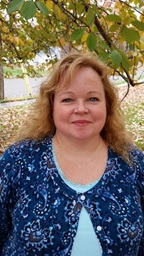 Karen Greene is the Mid-Atlantic Field Offices Supervisor for National Oceanic and Atmospheric Administration, Fisheries Greater Atlantic Regional Fisheries Office’s (GARFO) Habitat Conservation Division and is also the GARFO Essential Fish Habitat Coordinator. She has been with NOAA Fisheries for more than 25 years, working primarily in the Mid-Atlantic region, especially in New York, New Jersey, Delaware and Pennsylvania. Her primary focus has been to provide advice and guidance to federal agencies on avoiding, minimizing and offsetting adverse impacts to coastal fish habitats through a number of consultation authorities such as the Magnuson Stevens Fishery Conservation and Management Act and the Fish and Wildlife Coordination Act. Karen has been involved in the evaluation of compensatory mitigation plans for more than two decades and participated on many interagency review teams (IRTs) for wetland mitigation banks, including the Meadowlands Interagency Mitigation Advisory Committee originally convened in 1998, as well as the IRTs for the first federally approved mitigation banks in NJ and NY. Karen is co-located at the NOAA Fisheries Northeast Fisheries Science Center at their James J. Howard Marine Science Laboratory at Sandy Hook, NJ. She has a BS and MS in Environmental Science, both from Rutgers University.
Karen Greene is the Mid-Atlantic Field Offices Supervisor for National Oceanic and Atmospheric Administration, Fisheries Greater Atlantic Regional Fisheries Office’s (GARFO) Habitat Conservation Division and is also the GARFO Essential Fish Habitat Coordinator. She has been with NOAA Fisheries for more than 25 years, working primarily in the Mid-Atlantic region, especially in New York, New Jersey, Delaware and Pennsylvania. Her primary focus has been to provide advice and guidance to federal agencies on avoiding, minimizing and offsetting adverse impacts to coastal fish habitats through a number of consultation authorities such as the Magnuson Stevens Fishery Conservation and Management Act and the Fish and Wildlife Coordination Act. Karen has been involved in the evaluation of compensatory mitigation plans for more than two decades and participated on many interagency review teams (IRTs) for wetland mitigation banks, including the Meadowlands Interagency Mitigation Advisory Committee originally convened in 1998, as well as the IRTs for the first federally approved mitigation banks in NJ and NY. Karen is co-located at the NOAA Fisheries Northeast Fisheries Science Center at their James J. Howard Marine Science Laboratory at Sandy Hook, NJ. She has a BS and MS in Environmental Science, both from Rutgers University.
![]()
View Past Compensatory Mitigation Training Webinars Here
View a List of Past Compensatory Mitigation Training Webinar Recordings Here
test1
test
Publications
 The Association conducts research and publishes reports, guidebooks, news articles, brochures, white papers, and summaries of findings of symposia and workshops. These are available electronically to all interested individuals and organizations.
The Association conducts research and publishes reports, guidebooks, news articles, brochures, white papers, and summaries of findings of symposia and workshops. These are available electronically to all interested individuals and organizations.


